List of apple cultivars
Over 7,500 cultivars of the culinary or eating apple (Malus domestica) are known.[1] Some are extremely important economically as commercial products, though the vast majority are not suitable for mass production. In the following list, use for "eating" means that the fruit is consumed raw, rather than cooked. Cultivars used primarily for making cider are indicated. Those varieties marked agm have gained the Royal Horticultural Society's Award of Garden Merit.[2]

This list does not include the species and varieties of apples collectively known as crab apples, which are grown primarily for ornamental purposes, though they may be used to make jelly or compote. These are described under Malus.
Table of apples
Abbreviations: H height in mm, W Width in mm, We weight in grams. FCC = First Class Certificate. RHS = Royal Horticultural Society. AM = Award of Merit. BB = Biennial bearing, AC = Apple Canker, AS = Apple Scab, P = Parentage, PM = Powdery Mildew, s = Susceptible r = Resistant
| Common name | Image | Origin | First developed | Comment | Use |
|---|---|---|---|---|---|
| Abram[3][4] | 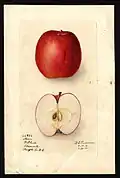 |
US | <1850 | A small apple with red flush. Flesh white, tender, subacid. Use December - March. | Eating |
| Acheson[5] | Alberta, Canada | Introduced 1941 | Fruit large, greenish yellow. P Delicious x unknown. Use August - September | Eating | |
| Acklam Russet[6] | Yorkshire, England | 1768 | A small russet apple. An excellent dessert apple of first rate quality, ripe in November, keep till March | Eating | |
| Adams Pearmain[7][8][3][9] | 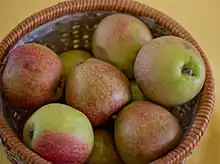 |
Norfolk or Herefordshire, England | Introduced 1826 | A dessert apple. First introduced under the name "Norfolk Pippin". W 64, H 63. Flesh yellow, crisp, firm, juicy, subacid, aromatic, very good. | Eating |
| Adina (syn. Frankad, Satark)[10] | Queensland, Australia | A large red apple. Flesh firm, juicy, sweet, very good. Tree vigorous. | Eating | ||
| Admiral |  |
Czech Republic | 2012 | New very popular variety. Flesh firm, crisp, juicy with very good taste. Robust, healthy, scab resistant variety with excellent keeping qualities and taste. | Eating |
| Advance[8] | %252C_National_Fruit_Collection_(acc._1962-020).jpg.webp) |
Bedford, England | 1908 | Early dessert apple. Medium size. Yellow with brown-red flush. Award of Merit from RHS in 1932. Pick mid August. Use August - September. | Eating |
| Adzamovka[11] | Croatia | A yellow conical apple with red stripes. W 60-70, H 50-60. We 110-150. Flesh juicy, subacid. Use November. | Eating, Cider | ||
| Ahrina[12] |  |
Germany | 1993 | A large roundish apple. Flesh juicy, subacid. Pick late September. Use November - February. | Eating |
| Aia Ilu | Estonia | 1946 | Apple is large in size, weighing 250–300 g. It is yellow, juicy, and bittersweet with a weak aroma. | Eating | |
| Airlie Red Flesh (Newell-Kimzey red flesh, Aerlie's Red Flesh) | Oregon, US | c. 1961 | A large, conic apple. Light yellow-green skin strewn with white dots, occasionally with a faint reddish orange blush. Light pink to deep red flesh is crisp, sweet and mildly tart. | Eating | |
| Akane | 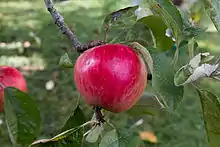 |
Japan | 1970 | Jonathan × Worcester Pearmain. Tangy taste. | Eating |
| Åkerö[13][14] | 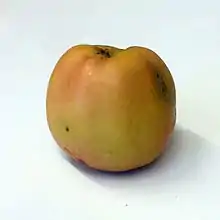 |
Sweden | 1759? | Apple is egg-shaped, medium to large in size, sweet and aromatic. H 68, W 68. Stalk 20–25 mm. Best in November, keeps well till February. Grown mostly in Sweden and Estonia. | Eating |
| Akin[15][16] | 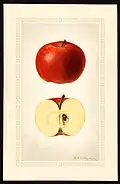 |
Illinois, US | 1831 | Tree vigorous. W 68, H 52. Stalk 20 mm. Flesh yellow crisp, tender, juicy, subacid, aromatic, good to very good. Use January - June. | Eating |
| Alamanka[11] | Macedonia | A green apple (round to conical) with red stripes. We 100. Flesh juicy, subacid with poor aroma. Pick October. Use November. | Eating | ||
| Alantapfel(syn. Princesse Noble)[13][17] | 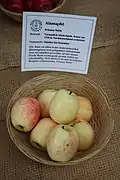 |
Germany | <1750 | An oblong apple. W 56-63, H 59-73. Stalk 13-16mm. Flesh sugary, aromatic. Pick October. Use December - March. | Eating |
| Alaska[5] | California, US | Introduced 1944 | Flesh white. Tree heavy producer. | Eating | |
| Albrechtapfel(syn. Prinz Albrecht von Preussen)[12][18] |  |
Germany | 1865 | P Alexander x unknown. W 60 - 85, H 55-63, We 80-200. Stalk 10 – 30 mm. Pick late September. Use October - December. | Eating, Cooking |
| Albury Park Nonsuch[7] | Surrey, England | <1892 | Yellow with red flush. AM from RHS in 1892. Flesh crisp, juicy, subacid. Use December - March. | Cooking | |
| Aldenham Purple[19] |  |
Hertfordshire, England | 1925 | A red apple. W 63, H 48. Stalk 15–25 mm. Pick September. Use September - October. | Eating, Cooking |
| Alderman[8][20] | Scotland | <1923 | A golden yellow apple. W 90, H 71. Stalk short to medium. Flesh firm, crisp, juicy, acid. Pick mid September. Use October - December. | Baking | |
| Alexander(syn. Kaiser Alexander, Emperor Alexander, Grand Alexander, Aport)[13][21][22][23] | .jpg.webp) |
Russia | <1800 | A very large apple. W 95, H 75. Stalk 18 mm. Flesh faint yellow, firm, crisp, juicy, very soft, mild subacid, fair to good. Pick early October. Pick mid September. Use September - December. | Eating |
| Alfriston[7][8][24] | 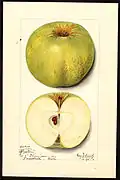 |
Sussex, England | late 1700s | Raised at Uckfield Sussex by Mr Shepherd. A large acid green apple. Flesh crisp, yellow, subacid, pear-like flavour. Award of Merit from RHS in 1920. W 83, H 76. Pick early October. Use November - April. | Cooking |
| Alice[14] | .jpg.webp) |
Sweden | 1964 | Medium size. Yellow with red stripes. Flesh juicy, aromatic. P Ingrid Marie x Gyllenkroks Astrakan. Pick September. Use September - Oct. | Eating |
| Alkmene[18] agm[25] |  |
Germany | 1930 | P: Cox's Orange Pippin × Doktor Oldenburg. W 58, H 58, We 120. Stalk 9 – 20 mm. Pick September. Use September - November. | Eating |
| Allen's Everlasting[8][26] | ? | <1864 | Late-keeping desert apple. First Class Certificate from RHS in 1899. Pick mid October. Use February - April. | Eating | |
| Allington Pippin[8][13][21][27] | 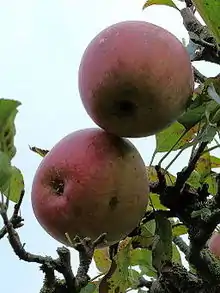 |
Lincolnshire, United Kingdom | 1880s, introduced 1896 | A versatile English dessert apple raised by horticulturalist Thomas Laxton some time before 1884. Exhibited as Brown's South Lincoln Beauty, the name was changed to Allington Pippin by Bunyard Nursery in 1896. A cross of Cox's Orange Pippin and King of the Pippins. A small apple, aromatic, with a pineapple-like flavour, keeps its shape when cooked. H 61-68 W 68-70. Stalk 15 mm. First Class Certificate from RHS in 1894. Pick late September. Use October - December. | Eating, Cooking, Dessert |
| All Summer[3] | 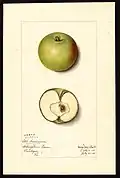 |
Pa. US | <1850 | Flesh white, tender, very good. Tree slow growth, annual bearer, productive. Stalk slender. Use July - August. | Eating |
| Almeda[5] | Tennessee, US | Introduced 1939 | Fruit large, green. Flesh subacid. Ripens July 25 - August 5. | Cooking | |
| Altländer Pfannkuchenapfel[18] | 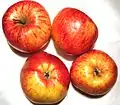 |
Germany | 1840 | W 67, H 51, We 115. Stalk 10 –20 mm. Pick October. Use March - May. | Cooking, Eating |
| Alvanija(syn. Elvanija, Ilvanija)[11] | Croatia | A green oblong apple with red flush. W 60-75, H 65-80, We 110-140. Flesh firm, juicy. Use October. | Eating, Cooking, Cider | ||
| Ambrosia | 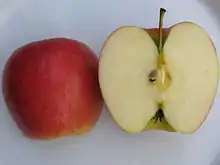 |
British Columbia, Canada | 1980s | Medium to large in size, mostly red coloration with yellow patches. Has cream-coloured flesh with a sweet, crisp, aromatic flavour and low acidity. Ambrosia trees are hardy and no major disadvantages have yet been identified. | Eating |
| American Beauty[3] | 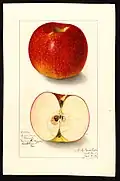 |
Massachusetts, US | <1855 | Tree vigorous, productive, annual bearer. Stalk short. Flesh yellowish, tender, juicy, subacid, aromativ, very good. Use December - April. | Eating |
| American Golden Pippin(syn. Golden Pippin, Ribbed Pippin, Golding, New York Greening, Newtown Greening, Golden Apple)[3] | 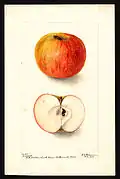 |
US | <1850 | Yellow with russet. Flesh yellowish, juicy, aromatic, subacid, very good. W 79. H 65. Stalk 16 mm. Tree does not bear young. Use November - February. | Eating |
| American Golden Russet(syn. Golden Russet, Sheep Nose, Bullock's Pippin, Little Pearmain.[6][28] | 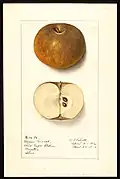 |
US | late 1700s | Yellow with brown overcolour and grey russet. W 64-74. H 58-72. Stalk 13–23 mm. Flesh yellowish, tender, juicy sugary, lightly aromatic, best. Use October - January. | Eating |
| American Melon see Melon American | |||||
| American Mother see Mother | |||||
| American Summer Pearmain see Summer Pearmain American | |||||
| Anabela[10] | Brazil | Introduced 1995 | P Gala x Anna. A yellow apple with (30-40%) red flush. Flesh juicy, sweet, very good. Tree vigorous. | Eating | |
| Ananas Reinette[18][13][29][30] | 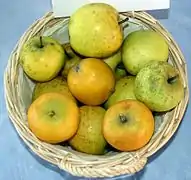 |
Netherlands | <1800 | A small yellow apple with pineapple flavor. W 48-65mm, H 52-65mm. We 115. Stalk 15 – 20 mm. Picking October. Use December - February. | Eating |
| Anisovka(syn. Anis koritschnevoje, Anis polosatyiy)[31] | Russia | <1850 | Medium size, round, greenish yellow with red stripes. Pick September. Use October - December. | Cooking, Eating | |
| Anna[10] | 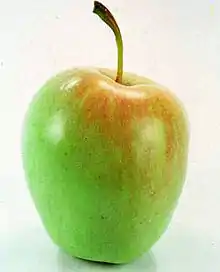 |
Israel | Introduced 1963 | Colour is yellow with a red blush. P Red Hadassiya x Golden Delicious. This variety does not grow well in the cold and prefers heat and humidity. Tree annually productive. | Eating |
| Annie Elizabeth[32][7][8][21] | Leicester, Leicestershire, England | introduced 1868 | Large yellow apple, FCC from RHS in 1868. W 79-87, H 63-65. Stalk 9–18 mm. Pick late September - early October. Use November - April. | Cooking, Eating | |
| Annurca | 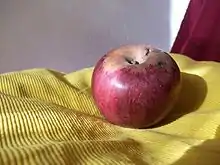 |
Campania, Italy | 1876 (documented) | Very old apple; possibly one of the oldest of all. Believed to be much older than first mention in Pasquale's Manuale di Arboricultura, 1876. May be related to apples found in frescoes found in Herculaneum or Pompeii if not the same one.[33] | Eating |
| Antonovka[13] | 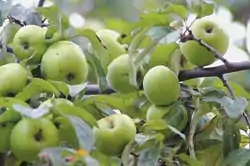 |
Kursk, Russia | 17th century | A very old Russian variety, often planted at dachas. Apples are large, yellow-green and bracingly tart to eat out of hand, but superb for cooking, as they keep their shape. Stalk 10 mm. Extremely tolerant of cold weather, and because it produces a single, deep taproot (unusual among apple trees), Antonovka is propagated for use as a rootstock. Antonovka rootstock provides a cold-hardy (to −45 °C), well-anchored, vigorous, standard-sized tree. | Cooking, Cider |
| Antonovka Safrannoje[31] | Russia | 1909 | A large yellow apple with red flush. P Antonovka x Renet Orleanski | Eating, Cooking | |
| Apfel aus Grignon[34] |  |
? | <1800 | A yellow apple with red flush and russet. W 82 H 66. Stalk 30 mm. Use December - March. | Eating, Cooking |
| Api[6] | France | 1628 | Very tiny apple. Would fit in the palm of the hand of an adult. | Eating | |
| Api Noir[6] | France | late 1700s | A desert apple, inferior to the Api. | Eating | |
| Apollo[18] | Germany | 1976 | Cox's Orange Pippin × Geheimrat Dr. Oldenburg. W 69, H 59, We 140. Stalk 13 mm. Pick September. Use September - October. | Eating | |
| Arapka(syn. Bugarka)[11] | Montenegro | A red oblong conical apple. W 61, H 66. We 118. Flesh soft, juicy, sweet, subacid, with a pronounced flavour. Use October - May. | Cooking | ||
| Ard Cairn Russet[8] | Cork, Ireland | c. 1890 | Medium sized long-keeping dessert apple. Award of Merit from RHS in 1910. Pick late September - early October. Use October - January. | Eating | |
| Ariane | 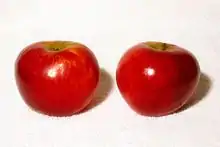 |
Angers, France | 2002 | Scab resistant. Developed at the National Institute of Agricultural Research in France. | Eating |
| Arkansas Black(syn. Arkansas, Mammoth Black Twig)[35][36] | 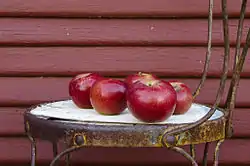 |
Arkansas, US | c. 1870 | Hard and crunchy; stores well. W 69, H 60. Stalk 20 mm. Very deep red, appearing black from a distance. Flesh yellow, firm, tewnder, juicy, subacid, crisp, good. Use December - May. | Eating |
| Armorel[7] | England | introduced 1893 | A small yellow apple with russet. FCC from RHS in 1892. Flesh crisp, good. Use February - May. | Eating | |
| Aroma[14] |  |
Sweden | 1947, Introduced 1973. | A yellow apple with red flush. W 63, H 58. P Ingrid Marie x Filippa. Use November - December. | Eating |
| Aromatic Russet[3] | 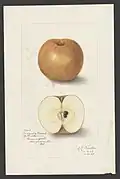 |
England | <1870 | Flesh greenish white, firm, subacid, aromatic. Use November - February. | Eating |
| Arreskov[13] | Denmark | <1860 | A yellow apple with a pleasant aroma reminding of gravenstein. W 77-85mm, H 66-75mm. Stalk 8-15mm. | Eating | |
| Arthur Turner[7] agm[37][21][38] | Buckinghamshire, England | <1912, introduced 1914 | W 80, H 48-76. Stalk 10–16 mm. Large golden cooker: prone to mildew but scab resistant. Award of Merit from RHS in 1912. Pick late September. Use September - November. | Cooking, Baking | |
| Arthur W. Barnes[8] | Chester, England | 1902 | P Gascoyne's Scarlet x Cox Orange. A yellow apple with red flush. W 82, H 70. Stalk medium. Flesh white, juicy, acid. Pick late September. Use November - March. | Cooking | |
| Ashmead's Kernel[7]agm[39]<[21] | 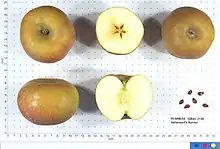 |
Gloucestershire, England | c. 1700 | W 57, H 57. Flesh pale yellow, subacid and very aromatic. W 54-64, H 54-57. Stalk 7–12 mm. Pick early-mid October. Use December - February. | Eating |
| Ashmore[4][3] | 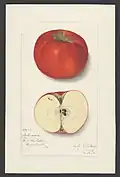 |
US | <1840 | W 85, H 66. Stalk 11 mm. Flesh yellowish-white, crisp, juicy, subacid, very good. Use September - October. | Cooking, Eating |
| Atalanta[7] | England | <1891, introduced 1893 | Lemon yellow with red streaks. AM from RHS in 1891. Use November - January. | Cooking, Eating | |
| Atlas[14] | Ottawa, Canada | 1924 | A truncate conical yellow apple with red stripes. W 67, H 67. Pick September. Use October - December. | Eating, Cooking | |
| Auksis | Lithuania | 1951 | McIntosh x Gravenstein | Eating | |
| Auralia see Tumanga | |||||
| Aurora Golden Gala |  |
British Columbia, Canada | 2003 | Dessert apple; medium size, sweet, juicy, crisp, firm, very long storage life. | Eating |
| Ausbacher Roter(syn. Ausbacher Rotapfel)[40] |  |
Ausbach, Hesse, Germany | 1770, introduced 1870 | A yellow apple with red flush. W 77, H 70. Stalk 12 mm. Tree vigorous. Flesh white to greenish yellow, subacid. Quality: cooking good, eating fair. Pick late September. Use October - April. | Cooking |
| Austin Sweet[3] | 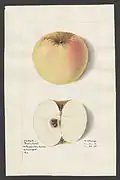 |
Pennsylvania, US | <1875 | Flesh white, juicy, sweet, very good. Stalk short. Use September - December. | Eating |
| Autumn Glory[41] | 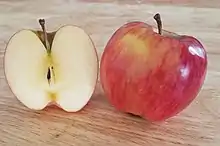 |
Washington, US | 2011 | The Autumn Glory variety is a hybrid of the Fuji (apple) and the Golden Delicious apple, featuring a red over golden background. Very sweet, firm flesh with a subtle "cinnamon" flavor. Produced only by Domex Superfresh Growers in Washington's Yakima Valley. | Eating |
| Automn Pearmain[29][21] | England | 1588 | Green with russet and red overcolour. H 60-68, W 67-72. Stalk 12 – 17 mm. Flesh cream coloured, nutty and aromatic. Pick late September. Use September - November. | Eating | |
| Avajlilja[11] | Turkey | A green apple with red flush. Tolerant to common apple diseases and pests. Flesh sweet sour taste, weak aroma. | |||
| Babovača[11] | Montenegro | A green apple with red flush. W 96, H 79, We 250. Stalk very short. Flesh soft, sweet and sour. Use October - April. | |||
| Bailey(syn. Bailey Sweet).[4][42][43] | 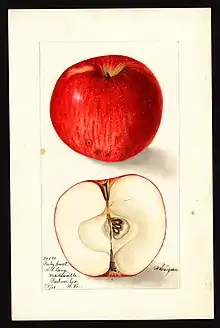 |
Wyoming County, New York, US | c. 1840 | Red apple with considerable white flecks. Has some russeting. W 86, H 74. Stalk 21 mm. Flesh yellow, tender, juicy, very sweet, very good. Use October. | Eating, Cooking |
| Baker's Delicious[8] | Wales | <1932 | A yellow apple with orange-red flush. W 63, H 58. Stalk short. Flesh white, crisp, juicy, aromatic. Pick late August - early September. Use August - September. | Eating | |
| Baldwin(syn. Woodpecker, Pecker, Butters)[44][6][3][45] | .jpg.webp) |
Massachusetts, US | c. 1740 | Flesh yellowish white, crisp, sweet to subacid flavor, very good. W 81, H 68. Stalk 22 mm. Very old variety for North America. Makes much juice. Use November - March. | Cooking, Eating |
| Ballinora[7] | England | <1898 | Golden yellow with red flush. W 79, H 56. AM from RHS in 1898. Use December - January. | Cooking, Eating | |
| Ball's Pippin[46][47] | England | <1920 | A green-yellow apple with red flush and russet. P Cox Orange x Sturmer Pippin. Flesh white, juicy, sweet, aromatic. AM from RHS in 1923. Use January. | Eating | |
| Ballyfatten | .jpg.webp) |
County Tyrone, Ireland | c. 1740 | A large, round apple with firm, dry, sweet, slightly tart white flesh. Excellent keeper. Scab and canker resistant. | Cooking, Eating |
| Baltimore(syn. Baltimore Pippin)[3] |  |
US | <1860 | W 78, H 62. Stalk 15 mm. Flesh whitish, juicy, subacid. Use December - April. | Eating |
| Banks[28][48] | 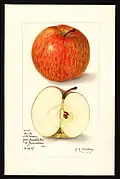 |
Nova Scotia | 1880 | A red sport from Gravenstein | Eating, Cooking, Pie |
| Barcelona Pearmain[6][49] | England | <1837 | One of the best dessert apples. The tree is a free grower, but does not attain the largest size. | Eating, Cooking | |
| Bardsey Island Apple | 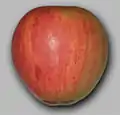 |
Bardsey Island, Wales | 1998 | A medium-sized eating apple with a unique lemon aroma. Sweet and juicy. Skin color red over gold. Very disease resistant. Single tree discovered on Bardsey island in 1998, age of original tree unknown. May have monastic origins. | Eating |
| Barnack Beauty[7][8][21] | Barnack, Northamptonshire, England | c.1840, introduced c. 1870 | Medium sized apple. Yellow, 25-75% flushed with orange red. AM from RHS in 1899. FCC from RHS in 1909. W 67, H 58. Stalk 20–25 mm. Flesh juicy, hard. Pick late September. Use December - March. | Eating | |
| Barnack Orange[8] | England | 1904 | P Barnack Beauty x Cox Orange. W 76, H 67. Stalk short. Flesh white, juicy, subacid, aromatic. Pick late September. Use November - February. | Eating | |
| Baronesa[10] | Brazil | Introduced 1997 | P Princesa x Fuji. We 130. Flesh sweet, crisp. Tree vigorous. | Eating | |
| Batul(syn. Batulenka, Batulka)[11] | Romania or Hungary | A green apple with red flush. Russet in stalk cavity. W 50, H 50, We 80. Flesh acidic with poor aroma. | Eating | ||
| Baumanns Reinette[18][50][51] | 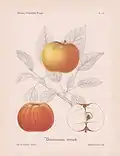 |
Belgium | c. 1810 | Medium size. Skin brilliant crimson. W 66, H 52. We 110. Stalk 10 – 15 mm. First Class Certificate from RHS in 1878. Pick late September. Use December - March. | Cooking, Eating |
| Baxter's Pearmain[6] | Norfolk, England | 1821 | A large dual purpose apple. The tree is hardy, vigorous, a most abundant bearer. Pick late September - early October. Use November–March. | Cooking, Eating | |
| Beacon | 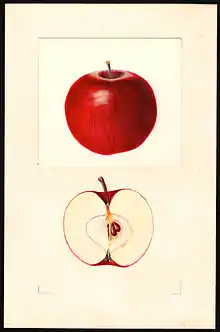 |
Minnesota, US | 1936 | Lively, juicy flavor; good for baking. Does not keep very well. | Cooking, Eating |
| Beauty of Bath[7][21][52] | 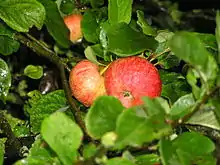 |
Somerset, England | 1864 | W 63, H 51. Stalk 9 – 12 mm. Deep red flush and streaks of red with a little russet. Early maturing but short season. Formerly grown commercially in England for local markets. FCC from RHS in 1887. Good flavor in its home climate if it is eaten soon after picking. Poor flavour if distributed long distances and stored for weeks, so now rare. Pick early August. Use early August. | Eating |
| Beauty of Bedford[7][53] | Bedfordshire, England | 1913 | H 64, W 64. P Lady Sudely x Beauty of Bath. Greenish yellow with orange flush. Flesh yellow, firm, juicy, sweet. Pick mid. September. Use September - October. | Eating | |
| Beauty of Hants[7][8] | Southampton, Hampshire, England | c1850 | A yellow apple with orange-red flush. W 80, H 70. Stalk variable. Flesh very crisp, yellowish juicy, highly aromatic. Triploid. Pick late September. Use November - February. | Eating | |
| Beauty of Kent[7][8] | Kent, England | 1820 | Old culinary apple, very irregular, ribbed. W 90, H 83. AM from RHS in 1901. Flesh yellowish, tender, subacid. Pick late September. Use December–March. | Cooking | |
| Beauty of Stoke[7] | Nottinghamshire, England | Tree vigorous. FCC from RHS in 1890. Flesh yellowish, firm, dry, pleasant flavour. Use January - March. | Cooking, Eating | ||
| Beauty of Wiltshire(syn. Weisse Wachs Reinette)[34] | 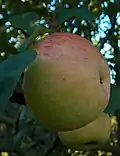 |
? | <1800 | Yellow with red flush. W 65, H 56. Stalk 9 mm. Flesh juicy, very acidic. Use October - November. | Cooking, Eating |
| Bedfordshire Foundling[6] | Bedfordshire, England | c.1800 | An excellent culinary apple. Pick late September. Use December - March. | Cooking | |
| Bedrika(syn.Prisatka)[11] | Serbia ? | A green conical apple with red flush. W 77, H 65. We 184. Flesh white, sweet, with pleasant aroma. | Eating | ||
| Beefsteak[3] | 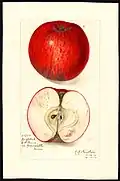 |
US | <1870 | Stalk medium. Flesh white, tender, crisp, juicy, subacid. Very good. Use October - November. | Eating |
| Beeley Pippin[8] | Derbyshire, England | c1880 | A yellow apple flushed(25-50%) with red. W 73, H 62. Stalk short. Flesh yellow, juicy, sweet, aromatic. Pick late August. Use September - October. | Eating | |
| Belle de Boskoop agm[54][13][18][21] | 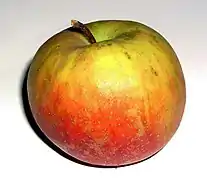 |
Boskoop, Netherlands | 1856 | W 73-82, H 67, We 205. Stalk 10–25 mm. Flesh acid and aromatic. AM from RHS in 1897. Pick early October. Use January - April. | Cooking, Baking |
| Belle de Buits[34] | Buits, La Vienne, France | <1860 | A yellow apple with red flush. W 68-74, H 49-54. Stalk 17 mm. Flesh white, crisp, juicy, aromatic, sweet. Use January - April. | Cooking, Eating | |
| Belle de Pontoise[7][21] | France | 1869, introduced 1879 | Large flat-round apple. Greenish-yellow, 25-75% flushed with red. Biennial. W 86, H 64. Stalk 15–20 mm. Flesh white, sweet, juicy. Pick mid October. Use November - March. | Cooking. | |
| Belmont[3] | 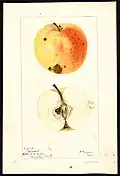 |
Pa. US | <1870 | W 82, H 67. Stalk short to medium. Flesh yellowish, crisp, tender, juicy, aromatic. Very good. Tree vigorous, healthy, very productive. Use November - February. | Eating |
| Ben Davis[55][56] | 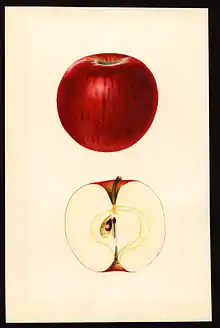 |
Southeastern US | c. 1800 | Noted for keeping well prior to refrigerated storage, but flavour has been compared with cork. | Eating |
| Bennet[3] | 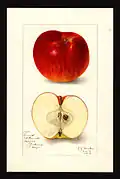 |
Herefordshire, England | <1870 | A cider apple. | Cider |
| Benoni[57][58][59][60] | 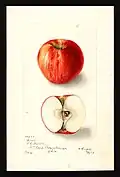 |
Massachusetts, US | <1832 | A small orange-yellow apple with red overcolour. W 59, H 53. Stalk 16 mm. Flesh yellow, firm, crisp, tender, juicy, subacid, good to very good. BB. Pick late August. Use August - September. | Eating |
| Ben's Red[7][8] | Cornvall, England | c.1830 | Medium to large apple. Slightly ribbed. Skin flushed and striped dark red. Flesh pale yellow, sweet, aromatic. P Devonshire Quarrenden x Box Apple. Award of Merit from RHS in 1899. Pick early September. Use September. | Eating | |
| Bentley Sweet[4] | 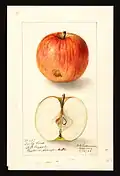 |
Virginia, US | <1850 | Flesh sweet. Tree vigorous,productive, an early bearer. Use April - September. | Eating |
| Berner Rosen[13] |  |
Switzerland | 1860 | A red apple. H 57-62, W 62-66. We 110. Stalk 20 mm. Pick October. Use December - February. | Eating |
| Bess Pool[7][21] | Nottinghamshire, England | 1824 | Round-conical apple. Flesh firm but tender, white, sweet, rather dry. Trees are shy bearers at first. W 67, H 58. Stalk 10–15 mm. Pick early October. Use November - February. | Eating | |
| Bethlemite[3] | 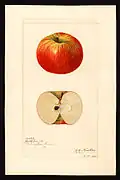 |
US | <1860 | W 78, H 58. Stalk 13 mm. Flesh juicy, subacid, aromatic. Use December - March. | Eating |
| Beverly Hills[5][10] | California, US | 1939, Introduced 1945.[61] | P Melba x Early McIntosh. Slightly tart flavor. Flesh white. Likes warm weather. MacIntosh style summer apple that is self fertile and well adapted to low chill conditions.[61] | Eating | |
| Bietigheimer[62][63] | Germany | <1870 | Fruit very large with russet. W 110, H 78. Stalk 16 mm. Tree large, vigorous. Flesh white, firm, coarse, srisp, juicy, subacid, fair to good. Use September - October. | ||
| Birgit Bonnier[64] | 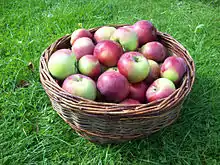 |
Sweden | 1992 | A cross between Cortland (apple) and Lord Lambourne. | |
| Bismarck[13][7][65][66] | .jpg.webp) |
Victoria, Australia | 1870 | Large fruit with a yellow-green with red overcolour. Flesh crisp, juicy, subacid, fair to good. FCC from RHS in 1887. Width 65-85mm, height 58-72mm. use November - February. | Cooking |
| Black Annette[3] | 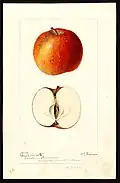 |
US | <1820 | Flesh white, tender, good. Use November - December. | Eating |
| Black Apple[3] | 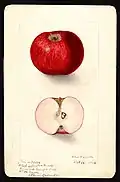 |
US | <1820 | Flesh white, good. Use November - February. | Eating |
| Black Gilliflower[4][67] | 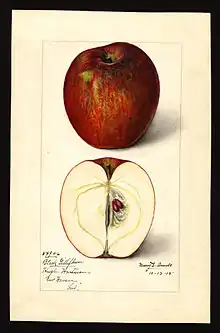 |
US | <1800 | W 68, H 74. Stalk 15 mm. Flesh white, dry, subacid, good. Tree very productive. Use November - March | Eating |
| Blackjon[5] | Washington, US | Introduced 1931 | Mutation of Jonathan | Eating | |
| Blackmack[5] | British Columbia, Canada | Introduced 1930 | Mutation of Red McIntosh. | Eating | |
| Black Oxford[3] | 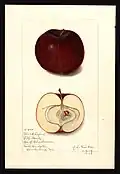 |
Maine, US | <1870 | Flesh white, dry, subacid, good. Tree a great bearer. Use March - May. | Eating |
| Black Sweet(syn. Moore's Sweeting)[4] | 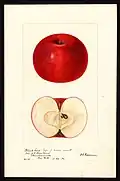 |
US | <1820 | W 82, H 67. Stalk 10 mm. Flesh yellow, dry, very sweet. Quality inferior. Use December - March. | Baking, Cider |
| Bledsoe[4] | 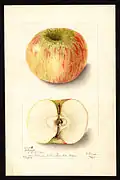 |
Kentucky, US | <1855 | A large apple. Stalk short. Flesh crisp, juicy, subacid, good. Use September - April. | Eating |
| Blenheim Orange (syn. Emilia in Ecuador and Pennsylvania in Colombia)agm[68][18][69][70] | 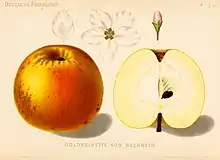 |
England | c. 1740 | Has greenish-yellow to orange skin streaked with red. W 75-91 , H 60-70, We 165. Stalk 10–20 mm. Distinctive nutty flavor excellent for cooking. The vigorous tree is slow to come into crop but then produces heavily. | Cooking, Eating |
| Bloody Ploughman | .jpg.webp) |
Carse of Gowrie, Scotland | c. 1800 | A medium-sized, very dark red, heavily ribbed apple. Crisp, mildly sweet white flesh, sometimes pink-streaked. It is reputed to have got its name from a ploughman who was caught stealing apples near Megginch Castle and was shot by the gamekeeper. His wife got the bag of apples and threw them on the compost heap where a seedling then grew and - voila - Bloody Ploughman. | Eating |
| Blue Pearmain[8][3][7][71] | 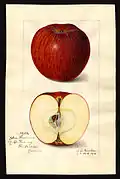 |
US | c1800 | A yellow apple with dark red stripes. H 63, W 70. Steam short and stout. FCC from RHS in 1896. Flesh aromatic, spicy, subacid, very good. Pick October. Use November - December. | Cooking, Cider, Eating |
| Bodil Neergaard[72] | .jpg.webp) |
Denmark | 1855 | A green oblong conical apple. W 56-61, H 70-75. Stalk 10 mm. Pick October. Use January- March. | Eating |
| Böhmer(syn. Edel-Böhmer)[34] | 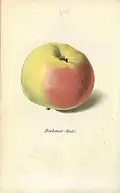 |
Tyrol | <1857 | Green with red flush. W 75, H 55. Stalk 13mm. Use December - March. | Eating |
| Böhmischer Rosenapfel[34] | 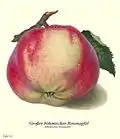 |
Bohemia, Germany | <1800 | A large apple. W 81, H 56. Stalk 12 mm. Flesh juicy, sweet. Use August - September. | Eating,Cooking |
| Bohnapfel[18] | _jm26577.jpg.webp) |
Germany | <1800 | W 55, H 55, We 100. Stalk 10 – 20 mm.Pick October. Use March–May. | Cooking, Cider |
| Boiken[18][13][73] | .jpg.webp) |
Germany | 1828 | Culinary apple. H 56, W 68, We 125. Stalk 17–23 mm. Flesh white, firm, crisp, tender, juicy, subacid, good.
Picking October Use: February–May. |
Cooking, Drying. |
| Bonum(syn. Magnum Bonum)[3][74][75] |  |
US | 1828 | W 77, H 57. Stalk 20 mm. Flesh white, firm, tender, aromatic, juicy, mild subacid, very good. Use September - December. | Eating |
| Borgovskoje[31] | Russia | <1860 | A sweet yellow apple. Pick late August. | Eating | |
| Bottle Greening[3] | 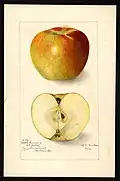 |
Green Mountains, US | <1850 | Produces large fruit. Has thick skin. Flesh white, subacid. Use January - February. | Eating, Cider |
| Bough see Sweet Bough | |||||
| Bountiful[21] | Kent, England | W 76, H 57. Stalk 20 mm. A yellow apple flushed (0-25%) with red. Flesh, fairly juicy, fairly tender. Pick late September. Use September - January. | Cooking, Eating | ||
| Bow Hill Pippin[7] | Bow Hill, Kent, England | introduced 1893 | Golden yellow with slight flush. AM from RHS in 1893. Flesh yellow, firm, juicy, good. Use November to February. | Eating | |
| Braeburn | 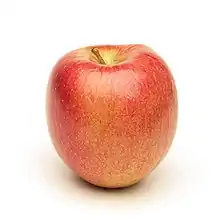 |
New Zealand | 1952 | Chance seedling. The fruit is widely sold commercially in the United Kingdom. | Eating |
| Brabant Bellefleur[7] | France ? | <1830 | Large golden yellow with red flush and stripes. Stalk short. AM from RHS in 1901. Flesh crisp, yellow, acid. Use December - April. | Cooking | |
| Bramley (Bramley's Seedling) agm[76] | 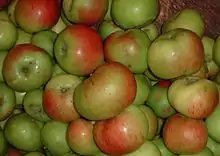 |
Nottinghamshire, United Kingdom | 1809 | The fruit is the most widely sold cooker in the United Kingdom. Triploid. W 83, H 70. Stalk 10-20mm. Large sized fruits with waxy skin, green with a red flush. A favorite ingredient in many traditional British puddings.[77] | Cooking |
| Brasil(syn. Bruckner, Bruckner do Brasil)[10] | Brazil | 1940s | Fruit large, resembles Delicious. Tree vigorous. | Eating | |
| Brauner Matapfel[78] |  |
Germany | <1800 | A yellow apple with redbrown flush. W 65, H 55. Stalk 7 mm. Flesh whitish-yellow, sweet, subacid. Quality cooking good, eating fair. Pick mid October. Use December - May. | Cooking |
| Bravo de Esmolfe | Esmolfe, Penacova, Portugal | 18th century | A small, juicy and sweet apple, considered one of the best Portuguese apples | Eating | |
| Breakey[5] | Manitoba, Canada | Introduced 1935 | Fruit medium size, red and scarlet. Flesh white, melting, juicy, spicy. Use September - November. | Cooking, Eating | |
| Breda Reinette(syn. Reinette von Breda, Reinette de Breda)[34] |  |
Netherlands | <1850 | W 65, H 56. Stalk 7 mm. Flesh yellowish, juicy, aromatic. Use December - March. | Cooking, Eating |
| Breedon Pippin | England | 1801 | Sweet flavor. Originally raised by a parson in Berkshire. Rare. | Eating | |
| Breuhahn[18] |  |
Germany | 1895 Introduced 1934 | W 63, H 53, We 93. Stalk 17 – 25 mm. Pick September - October. Use October - April. | Cooking, Eating |
| Briar Sweet see Pound Sweet | |||||
| Brina | Italy | 1998 | Resistant to scab. Spreading habit with intermediate vigor; full flowering season is medium-late, production is heavy, fruit is medium or medium-large, with smooth skin; white lenticels, no russet, excellent taste characteristics. Ripens first week of October (Trentino). | Eating | |
| Broad Eyed Pippin[8] | England | <1700 | A yellow apple with some light brown flush. W 93, H 70. Stalk short. Flesh white, acid. Pick late September. Use November - January. | Cooking, Cider. | |
| Brownlee's Russet[7][8][21] | Hempstead, Hertfordshire, England | c1848 | Green with red flush, covered with russet. W 70-74, H 58-61. Stalk 8-12mm. Flesh greenish white, juicy, acid, nutty flavour. Pick mid October. Use December - March. | Eating | |
| Buckingham(Syn. Kentucky Queen, Lexington Queen)[79][28][80] | 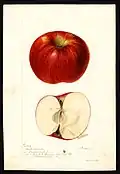 |
US | <1817 | W 87-93, H 67-78. Stalk 11–21 mm. Flesh coarse, juicy, subacid, fair to good. Use November - February. | Eating |
| Buff[4] | 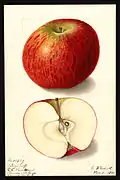 |
US | <1830 | Very large. Stalk 19 mm. Flesh, white, tender. Use November - March. | Eating |
| Bullock[28] | 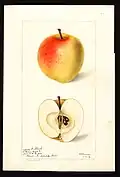 |
New Jersey, US | <1805 | W 59, H 55. Stalk 23 mm. Flesh firm, crisp, tender, juicy, aromatic, subacid, very good to best. Tree not large. Use October - January. | Eating |
| Bushey Grove[8][81] | Hertfordshire, England | 1897 | A greenish-yellow apple with red flush(25-75%). P Alexande x Dumelow. AM from RHS in 1922. W 78, H 66. Stalk short. Flesh white, juicy, acid. Pick late August. Use October - December. | Cooking, Pie | |
| Byfleet Seedling[8] | Surrey, England | 1915 | Large cooking apple W 96, H 76 mm. | Cooking | |
| Byford Wonder[7] | Herefordshire, England | <1893 | Yellow with russet dots. Very large. Tree very vigorous. AM from RHS in 1893. | Cooking | |
| Cabashea[82][28] | 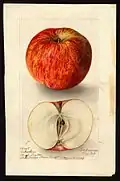 |
New York, US | <1851 | A large oblate apple. W 100, H 68. Stalk 19 mm. Use September - October. | Cooking |
| Čačanska pozna[83] | Serbia | Introduced 1971 | P Starking x Jonathan. W 79, H 66. We 200. Stalk medium. Diploid. Pick late September - early October. | ||
| Čadel[84] | Serbia | Introduced 1984 | P Golden Delicious x Jonathan. W 78-82. H 78-82. We 250-275. Stalk 45 mm. Flesh firm, crisp, juicy, acid. Pick late September - Early October. | ||
| Cal-King[5] | California US | 1942 | P unknown. | ||
| Calville Blanc d'hiver[8] | 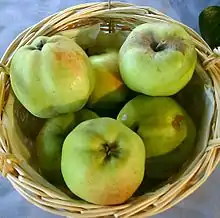 |
France | 1598 | Noted for unusual looks (somewhat lumpy on the side) but excellent reward when tried. Noted for having unusually high vitamin C content. Apple of choice for tarte tatin in France. W 75, H 65. Stalk variable. Flesh white, juicy, sweet, aromatic. Pick third week of October. Use November - March. | Cooking, Eating |
| Calville Rouge D`Automne[6] |  |
France | 1670 | A culinary apple of inferior quality in England. | Cooking, Eating |
| Calville Rouge D`Ete[6] | France | <1800 | A culinary apple of second-rate quality. | Cooking, Eating | |
| Calville Rouge D`Hiver[6][8] |  |
France | <1800 | A culinary apple of second-rate quality. W 75, H 76. Stalk long. Flesh white, soft, juicy, sweet. Pick early October. Use December - March. | Cider, Cooking, Eating |
| Calville Saint Sauveur[34] | .jpg.webp) |
France | 1839 | Yellow with red flush. W 74, H 64-71. Stalk 18mm. Pick October. Use December - February. | Eating |
| Cambusnethan Pippin[8] | Stirlingshire, Scotland | c1750 | A yellow apple with red flush(50-75%). W 70, H 52. Stalk medium. Flesh white, sweet, aromatic. Pick late September. Use October- December. | Eating, Cooking | |
| Cameo | 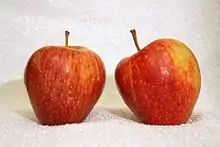 |
Washington State, US | 1980s | Existence owed to freak accidental crossing of two most popular apples in world: Red and Golden Delicious. Retains prongs on bottom of latter parent but has flavor more resembling Golden. | Eating |
| Campanino | .jpg.webp) |
Modena, Italy | before 1751 (documented) |
Fruits have firm, crisp flesh with a rather acid flavor | Cooking |
| Campfield(syn. Newark Sweeting)[3][28][4] | New Jersey, US | <1817 | A cider apple. Biennial. Use November - July. | Cider | |
| Cannon Pearmain[3] | 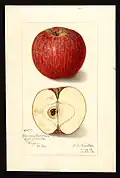 |
North Carolina ?, US | <1851 | A medium size, yellow apple with red flush. Flesh yellow, subacid, very good. Use December - March. | Eating |
| Capital[4] | 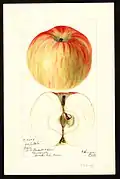 |
Indiana, US | <1850 | W 65, H 57. Stalk 11 mm. Flesh yellow, juicy, subacid. Use December - January. | Eating |
| Caraway Russet see Fenouillet Gris | |||||
| Carícia[10] | Brazil | Introduced 1995 | P Prima x Anna. Flesh subacid, good. Tree vigorous. | Eating | |
| Cardinal(syn. Kiarolkowski, Peter the Great)[85] | Russia | <1880 | AM from RHS in 1896. Flesh soft, white, juicy, sweet, aromatic. Use August - September. | Eating | |
| Carlisle Codlin[8] | England | <1830 | Yellow apple with no overcolour. H 58, W 65. Flesh juicy, subacid. Pick September. Use Oct. - November. | Cooking | |
| Carlough[28] | 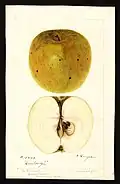 |
New York, US | <1899 | Flesh whitish, tender, juicy, subacid, good. Use November - April. | Eating |
| Carlton[5] | 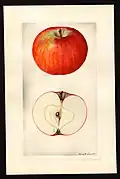 |
Geneva, New York, US | Introduced 1923 | P Montgomery x Red Astrachan. Ripens 1 month later than Red Astrachan. Flesh white, tender, juicy, subacid. Tree vigorous, annual bearer. | |
| Carola(syn. Kalco)[18] | .jpg.webp) |
Germany | 1962 | W 74-85, H 60, We 135-220. Stalk 5 – 20 mm. Pick September. Use September - December. | Cooking, Eating |
| Carolina Red June[59][28][3][4][syn. Red June, Georgia June] | Tennessee, US | c. 1810 | Very popular Civil-War-era Southern apple. Flesh juicy, brisk, subacid. Does beautifully in humid weather. Good choice for backyard gardener in subtropical climate, though hardy as far north as zone 5. Pick late July - early August. Use August - October. | Cooking, Eating | |
| Carpentin Reinette(syn. Carpentin)[34] |  |
France or Germany | <1800 | Gelb with red stripes. W 59, H 44. Stalk 15 mm. Use December - March. | Cooking. |
| Carroll | 1947 | Ripens early. | Eating | ||
| Carswell's Orange[8] | Surrey, England | 1938 | A yellow apple with red flush(25-75%). P Cox Orange x unknown. W 67, H 63. Stalk medium. Flesh white, juicy, aromatic. Pick mid September. Use September - November. | Eating | |
| Carter's Blue | 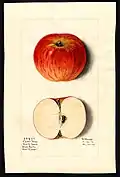 |
Alabama, US | 1840s | Medium to large, roundish oblate; skin green or greenish yellow washed with dull red with darker red broken tripes, covered with a heavy bluish bloom. Crisp, juicy, sugary, aromatic, mild subacid. Foliage also has a blue hue. Ripens September and keeps until November. Once widely grown in the American South, then thought extinct. Reintroduced to America in 1994 after being discovered at the National Fruit Trust in Kent, England, where it had been added in 1947 from a collection in Rhone, France, after it had been acquired around 1860 from the Fruitland Nursery in Augusta, Georgia.[86] | Eating, Cooking |
| Carver(sy. White Carver)[3] | 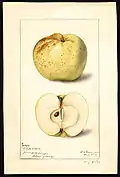 |
Pa. US | <1875 | Stalk short. Flesh yellow, juicy, tender, vinous, subacid. Tree productive. Use August. | Eating |
| Catline(syn. Gregson Apple)[3] | 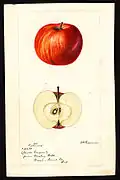 |
Maryland, US | <1875 | Below medium size. Flesh tender, juicy, sweet. Tree slow growth. Use October - December. | Eating |
| Catshead[8] | .jpg.webp) |
England | <1700 | Sharp flavor. Lumpy shape and electric green coloring. H 86, W 86. Known to have been a variety planted in early Virginia by settlers as well as native England. Extremely rare in native United Kingdom; occasionally still found growing in southern United States. | Cooking |
| Cauley[5] | Mississippi, US | Introduced 1942 | P unknown. A large apple. Flesh yellow, crisp, juicy. Tree yields heavily. | Cooking, Jelly | |
| Celestia[4] | 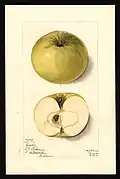 |
Ohio, US | <1850 | W 83, H 75. Stalk 21 mm. Flesh subacid, sprightly, spicy, aromatic. Use September | Cooking, Eating |
| Cellini[13][19][14][87] | 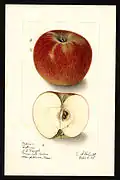 |
England | <1843 | W 70-86, H 56-74. Stalk 10 – 20 mm. Pick late September. Use October - December. | Eating, Cooking. |
| Champagnerrenette see [[Reinette de Champagne | |||||
| Champion, (syn. Shampion, Sampion) |  |
Czechoslovakia | c. 1960 | A cross between Golden Delicious and a Cox Orange Pippin. Attractive color. This tree bears attractive fruit, extra-large sized, deep red, juicy, and crisp. Keeps fresh for a long time. Starts bearing at a young age. | Eating |
| Champlain [88] | _(19557877458).jpg.webp) |
US | < | A grennish yellow apple. W 83, H 75. Stalk 21 mm. Flesh white, very tender, juicy, subacid. Quality: eating good, cooking excellent. Use August - October. | Eating, Cooking |
| Charlamoff[89][90] | 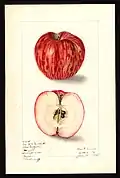 |
Russia | <1880 | Yellow with red flush. Tree small. Flesh white, coarse, juicy, subacid, good. Pick and use August. | Eating |
| Charlamowsky see Duchess of Oldenburg | |||||
| Charles Eyre[8] | Berkshire, England | Introduced 1911 | A greenish-yellow apple. W 102, H 90. Stalk short. Flesh white, soft, dry, acid. Pick mid September. Use September - November. | Cooking, Pie | |
| Charles Ross[7]agm[91][21] | Berkshire, England | 1890s | FCC from RHS in 1899. Orange to red. W 80, H 70. Stalk 10 mm. Best cooked early in season. Good flavor, and sweet when eaten later in season. Pick mid September. Use October - December. | Multi-purpose | |
| Chaxhill Red[92] | Gloucestershire, England | >1873 | A roundish oblate red apple. H 52, W 63. Stalk short and stout. | Eating, Cider | |
| Cheddar Cross[8] | England | Raised 1916, Introduced 1949. | Green Apple with red flush. H 50, W 60. Flesh yellow ,juicy, sharp. | Eating | |
| Cheese[3] | 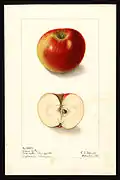 |
Pa. US | <1870 | Flesh white, tender, subacid. Good. Tree vigorous, bears annually. Use November - February. | Eating |
| Cheeseborough[4] | 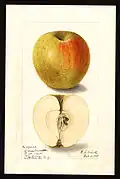 |
US | <1840 | One of the largest and one of the poorest of the russet apples. Flesh dry, subacid, sweet. Use November - December. | Cooking |
| Chelmsford Wonder[93][8][7][94] | _(14598039478).jpg.webp) |
Essex, England | c. 1870 | A large long keeping yellow-skinned apple with diffuse orange pink flush. FCC from RHS in 1891. [1]. H 61, W 75. Pick October. Use November - February. Still grown in Essex orchards including Lathcoats Farm Shop. | Cooking |
| Chenango[3] [syn. Chenango Strawberry][95][96] | 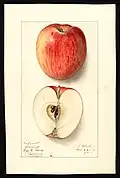 |
N.Y. US | <1850 | W 72, H 72. Stalk 14 mm. Flesh white, firm, tender, juicy, mild subacid, aromatic, good to very good. Use September - October. | Eating |
| Chester(syn. Chester Redstreak)[3] | 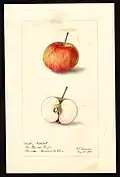 |
Pennsylvania, US | <1850 | Medium size. Flesh white, tender, juicy, subacid, aromatic. Use November - December. | Eating |
| Chestnut[5] | Minnesota, US | Introduced 1946 | P Malinda x unknown. Flesh nutlike flavor. Tree vigorous, productive. | ||
| Chiver's Delight[21] | Histon, Cambridgeshire, England | 1920s | Medium to large oblate apple. Red flush over greenish yellow skin. Crisp, juicy, sweet white flesh. Flavor can be variable but at its best is very well balanced. Grown by Chivers (now a brand of Premier Foods) for apple sauce. | Multi-purpose | |
| Chorister Boy[8] | Wiltshire, England | <1890 | A yellow apple with red flush. W 66, H 60. Stalk medium. Flesh white, juivy, subacid. Pick late September. Use November - December. | Eating | |
| Christmas Pearmain[8] | England | 1893 | A yellow apple with red flush(50-75%). W 63, H 67. Stalk short. Flesh yellow, crisp, subacid, aromatic. Pick early October. Use November - January. | Eating | |
| Clarke(sy. Clarke Beauty)[28] | 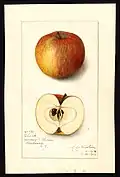 |
New York, US | <1900 | Flesh tender, juicy, subacid. Use October - January. | Eating |
| Claygate Pearmain[7] [8][21] | 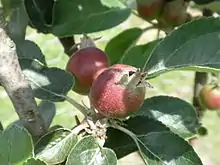 |
Surrey, England | 1821 | Suitable for northerly, cold, wet climates: rich, nutty flavor. FCC from RHS in 1921. W 67-70, H 59-67. Stalk 10–18 mm. Pick early October. Use December - February. | Eating |
| Clayton[4] | 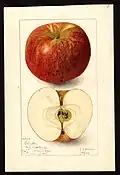 |
Indiana, US | <1850 | W 84, H 70. Stalk 14 mm. Flesh yellow, subacid. Use November - March. | Cooking |
| Cleopatra see Ortley | |||||
| Clivia[18] | 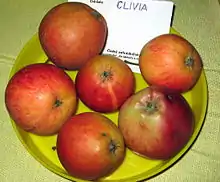 |
East Germany | 1964 | Geheimrat Dr. Oldenburg × Cox's Orange Pippin. W 64-80, H 56, We 100-183. Stalk 15 – 30 mm. Use December - April. | Eating |
| Close[14] | Virginia, US | Selected 1928, Introduced 1938 | A greenish - yellow apple with red stripes. H 72, W 75. Pick August. Use August. | Eating | |
| Cludius Herbstapfel[97] |  |
Germany | <1860 | A green apple. W 80, H 64. Flesh juicy, subacid. Pick September. Use September. | Eating |
| Cockle Pippin[8] | Surrey, England | c1800 | A greenish yellow apple. W 62, H 59. Stalk medium. Flesh, firm, white, dry, sweet. Pick early October. Use December - March. | Eating | |
| Coffelt[28] | 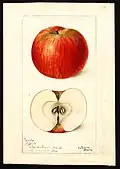 |
US | ? | Flesh whitish, firm, tender, juicy, subacid, good. Use January - May. | Eating |
| Cogswell(syn. Cogswell Pearmain)[3] |  |
Ct. US | c1755 | W 84, H 63. Stalk 16 mm. Flesh yellow, juicy, subacid, aromatic. Use December - March. | Eating |
| Collamer[98][99] | _(19557808128).jpg.webp) |
New York, US | ca 1895 | A sport of Twenty Ounce. W 105, H 95. Stalk 17 mm. | |
| Collins[28] | 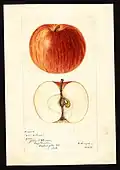 |
Arkansas | <1895 | W 78, H 59. Stalk 19 mm. Flesh white, crisp, firm, subacid, fair to good. Tree vigorous. Use January - June. | Eating |
| Colton[28] | 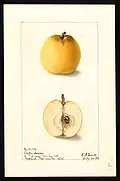 |
Mass. US | c1840 | A yellow apple. Flesh juicy, mild subacid. Use August. | Eating |
| Colvert[4] | 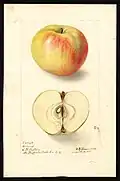 |
US | <1850 | A large apple. Flesh white, juicy, subacid. Use October - November. | Eating |
| Conard[5] | Missouri, US | Introduced 1935 | P Ben Davis x Jonathan. Ripens 1 week after Jonathan. Tree vigorous, resistant to disease. | Eating | |
| Constantine[100][101] | _(19557900590).jpg.webp) |
Europe | <1873 | Constantine is very similar to Alexander, but ripens later and keeps longer. W 91, H 69. Stalk 23 mm. Flesh, white, firm, coarse, tender, juicy, subacid, fair to good. Use September - November. | Eating |
| Cook's Favorite[4] | 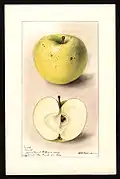 |
US | <1850 | Flesh yellow, subacid. Stalk long. Use September. | Cooking |
| Cooper[4][3][28] | Connecticut, US | <1796 | W 86, H 65. Stalk 18 mm. Flesh juicy, subacid, vinous, sweet. Good. Use October - December. | Eating | |
| Cooper Early White[3] | 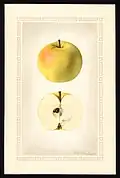 |
Illinois ? US | <1870 | Flesh white, crisp. Use September - October. | Eating |
| Cooper Market[3][28][102] | 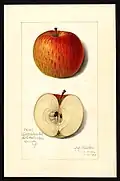 |
New Jersey ? US | <1804 | Tree vigorous. Flesh white, tender, subacid, fair to good. Use December - May. | Eating |
| Cornell Fancy[3] | 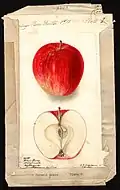 |
Pennsylvania, US | <1870 | Stalk medium. Flesh white, tender, crisp, juicy, subacid. Very good. Tree vigorous. | Eating |
| Cornish Aromatic[8][21] | Cornwall, England | very old | Large yellow. High-quality dessert apple. W 64-77, H 58-69. Stalk 18–21 mm. Pick mid October. Use December - March. | Eating | |
| Cornish Gilliflower[8][21] | 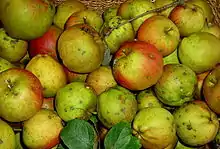 |
Cornwall, England | 1813 | Discovered as accidental seedling. Shy bearer. W68-70, H 68-70. Stalk 18 mm. Flesh yellow, sweet. Pick mid October. Use November - March. | Eating |
| Coronation[8] | Sussex, England | 1902 | A yellow apple with red flush(50-75%). W 81, H 63. Stalk long. AM from RHS in 1902. Flesh white, soft, dry, sweet. Pick mid September. Use September - December. | Cooking, Eating | |
| Cortland[14][103] | 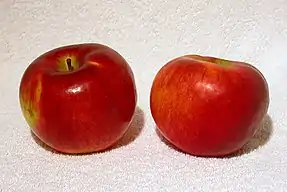 |
Geneva, New York, US | 1899. Introduced 1915. | Pale crisp flesh. W 73, H 57. Classic red coloration, nice crunch. P Ben Davis x McIntosh. Tree early and annual bearer, very hardy. Ripens in October in state of origin. | Eating |
| Cosmic Crisp | 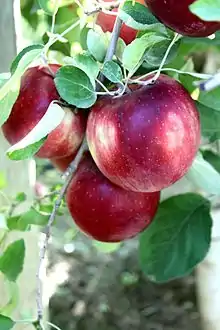 |
Washington, United States | 1997 | Became available commercially in 2019. A combination of Enterprise and Honeycrisp apples. | Eating |
| Cottenham Seedling[8] | Cambridgeshire, England | <1923 | P Dumelow x unknown. W 80, H 67. Stalk short to medium. Flesh white, firm, juicy, acid. Pick late September. Use November - March. | Cooking | |
| Coulon Reinette see Reinette Coulon | |||||
| Court Pendu Plat[21] | 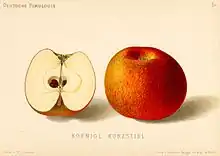 |
France | 1613 | Extremely old variety, may date from as early as Roman times. W 61, H 45. Stalk 10 mm. Popular during the Victorian era. Yellow to light green, flushed with red.Pick mid October. Use December - April. | Eating |
| Cowan's Seedling[92] | England | ? | A small apple, yellow with red flush. Stalk very short. Flesh juicy, sweet, pleasant flavour. Use October. | Eating | |
| Cowarne Quoining[92] | Herefordshire, England | 1826 | H 65, W 65. Stalk short and slender. Flesh juicy, sweet and of good flavour. Use January - March | Eating | |
| Cox's Orange Pippin[21][18][104] | 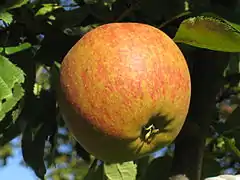 |
England | 1829 | One of the most celebrated apples in the United Kingdom, valued for its aromatic "orange" color and flavor. W 60, H 48, We 85-100. Stalk 10 mm. The fruit is widely sold commercially. Mainly grown in United Kingdom, Belgium and the Netherlands but also grown for export in New Zealand. Use October - February. | Eating |
| Cox Pomona(syn. Pomona)[8][105][106] | 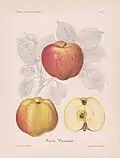 |
Buckinghamshire, England | c. 1825 | A large five crowned apple. W 88, H 67. Stalk 14 mm. Raised by Richard Cox. Parentage Alexander x unknown. Mainly grown in Denmark and Sweden. | Eating, Cooking |
| Cranberry Pippin[4][107] | 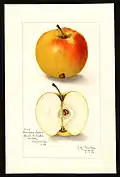 |
New York, US | <1840 | Large yellow apple with red flush. W 80, H 62-68. Stalk 10-15 mm. Flesh white, juicy, subacid. Use November - February. | Cooking |
| Crawford(syn. Crawford Keeper)[4] | 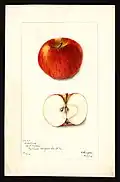 |
US | <1850 | Flesh yellow, tender, juicy, subacid. Use February - April. | Eating |
| Crawley Beauty[21][108] | England or France | <1870 | A pale green cooking apple. W 58, H 45. Stalk 15–20 mm. At maturity yellow with orange-red flush. Award of Merit from Royal Horticultural Society in 1912. Pick mid October. Use December - March. | Cooking | |
| Creek[3] | 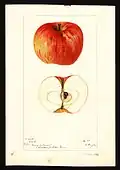 |
Pa. US | <1870 | Flesh white, tender, juicy, subacid. Very good. Tree vigorous. Use December- March. | Eating |
| Cripps Pink ('Pink Lady') | Australia | 1970s | Crisp, very sweet and slightly tart. Light red, pink and light yellow-green striped skin. | Cooking, Eating | |
| Crispin | 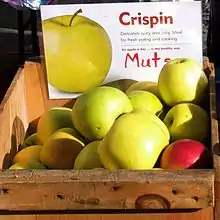 |
Japan | 1930 | See Mutsu | Eating |
| Crimson Delight | 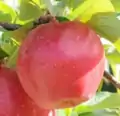 |
Washington, United States | Crimson Delight is a multi-purpose apple intended for snacking, baking and fresh recipes. The fruit size is medium to large with a firm texture and is crisp and juicy. | Eating, Baking etc. | |
| Crimson Gold | .jpg.webp) |
California | 1944 | A golf ball sized applecrab hybrid developed by Albert Etter who named it Little Rosybloom for its cute size and attractive ruby red flush. He died before completing the patent papers. Fruit was later rediscovered and renamed. Very crispy and keeps texture in baking. | Eating, Baking etc. |
| Crimson Queening[8] | England | <1831 | A grennins yellow apple flushed (50-75%) crimson. W 73, H 73. Stalk variable. Flesh greenish white, soft, sweet, juicy, subacid. Pick early September. Use September - October. | Cooking | |
| Crispin see Mutsu | |||||
| Criterion | New York | 1898 | One of parents believed to be Ben Davis, but very tart unlike parent. Dark red skin underlain with stripes. | Cooking, Eating | |
| Croncels[18] | 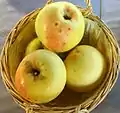 |
France | 1869 | Round oblong. Pale milky yellow with occasional slight flush. Flesh pale yellow, tender, very juicy. Use September, October. W 80, H 67, We 195. | Eating |
| Cullasaga[4] | 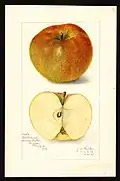 |
North Carolina, US | <1858 | Flesh yellow, tender, juicy, sweet flavor. Use January - April. | Eating |
| Curl Tail[8] | England | <1872 | A yellow apple. W 70, H 62. Stalk short. Flesh white, soft, dry, subacid. Pick mid September. Use October- December. | Cooking | |
| Dakota Beauty[5] | South Dakota, US | Introduced 1944 | |||
| Daniel[4] | 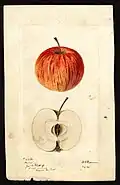 |
Indiana, US | <1850 | A delightful dessert apple. Flesh subacid, aromatic. Use September | Eating |
| Danziger Kantapfel[13] |  |
Germany | <1760 | A yellow apple with red overcolour. W 63, H 58 Pick October. Use October - December. | Cooking, Eating |
| D'Arcy Spice agm[109][21] | Tolleshunt D'Arcy, Essex, England | 1785 | A medium-sized apple with yellow-green skin, a red blush where exposed to the sun and covered with a spotty ochre russet. White flesh is aromatic, firm and crisp with noticeable hints of anise and clove. W 67, H 58-61. Stalk 12 mm. Pick late October. Use December - April. | Eating | |
| Davey[5] | Massachusetts, US | Introduced 1950 | P McIntosh x unknown. Tree bears earlier and more regularly than Baldwin, resistant to scab. | Eating | |
| Deacon Jones[110][111] | 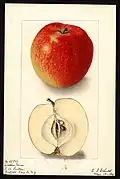 |
Pennsylvania, US | <1890 | Large oblong-conic, ribbed. Yellow with red flush. Tree vigorous. Flesh yellow, firm, coarse, crisp, tender, juicy, mild subacid, aromatic, fair to good. Use November - March. | Eating |
| Dean's Codlin[34] |  |
England ? | <1844 | A large apple W 91, H 74. Stalk 15 mm. Use December - March. | Cooking |
| Delawine[5] | Ohio, US | Introduced 1948 | P Delicious x Stayman Winesap. Flesh juicy and flavor of Stayman Winesap. Tree strong grower. | ||
| Delblush | 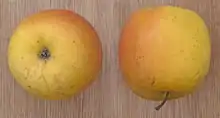 |
France | 1979 | Tentation delblush , Golden Delicious × Grifer |
Eating |
| Delcon[5] | Missouri, US | Introduced 1948. | P Conrad x Deliciious. Tree dwarf tendency, heavy producer. | Eating | |
| Delcorf[112] | 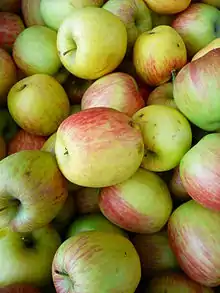 |
France | 1960 | Delbarestivale delcorf, Golden Delicious × Stark Jonagrimes |
Eating |
| Delfloga | France | 2008 | Delbardivine delfloga, Royal Gala Tenroy × Florina, scab resistant |
Eating | |
| Delflopion | Delbard, France | Sampion × Florina, scab resistant | Eating | ||
| Delicious[8] | 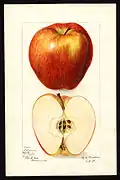 |
Iowa, US | c1880 | W 69, H 68. Stalk medium. Flesh white, juicy, sweet, atromatic. Pick mid October. Use December - March. | Eating |
| Delrouval | 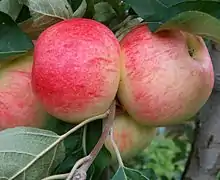 |
France | 1995 | Cybèle delrouval, Delcorf × Akane |
Eating |
| Deltana | France | 2010 | Delbard Celeste deltana, (Golden Delicious × Grive Rouge) × Florina, scab resistant |
Eating | |
| Democrat[3] | 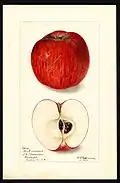 |
US | <1869 | A yellow apple striped and splashed with red. W 77, H 70. Stalk 24 mm. Flesh juicy, subacid. Very Good. Use December - March. | Eating |
| Detroit Red(syn. Detroit)[3][113] | 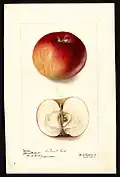 |
US ? | <1820 | Flesh, white, crisp, juicy, subacid.W 84, H 68. Stalk 10mm. Good. Use October - February. | Eating |
| Deutsher Goldpepping(syn. Pomme d`Or d`Allemange[34] |  |
Germany | <1833 | A yellow apple. W 59, H 47. Stalk 14 mm. Use January - April. | Eating, Cooking |
| Devonshire Quarreden[8][21] | England, France? | 1685 (documented) | Possible French parentage or ancestry. Crimson red peel. Juicy. W 51-64, H 38-48. Stalk 15 mm. Flesh greenish-white, crisp, juicy, sweet. Pick late August. Use late August - early September. | Eating | |
| Dewdney's Seedling[8] | Lincolnshire, England | c1850 | Large, irregular, late cooking apple. Flesh juicy, acid. W95, H80. Stalk very short. Pick late August. Use October - January. | Cooking | |
| Diamond Jubilee[7] | Kent, England | <1901 | A yellow apple. AM from RHS in 1901. Flesh firm, white, good. Use January - March. | Eating, Cooking | |
| Discovery agm[114][21] | 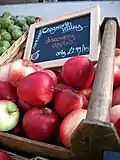 |
Essex, England | 1949 | P Worcester × Beauty of Bath. W 66, H 48. Stalk 10 mm. Sharp, sweet flavour. Fruits are sold commercially in the United Kingdom. Pick mid August. Use mid August - mid September. | Eating |
| Doctor[3][28] | 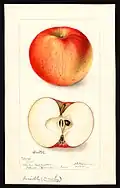 |
Pennsylvania, US | <1817 | Flesh tender, juicy, aromatic, subacid. Good. Use October - January. | Eating |
| Domine(syn. Hogan, Wells, Cheat)[3][115] | 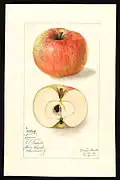 |
US | <1831 | W 74, H 56. Stalk 29 mm. Flesh exceedingly tender and juicy. Use December - April. | Eating |
| Domino[7] | Nottinghamshire ? England | ? | Oblong, rounded, irregular. Pale yellowish green. W 64 H 70. Stalk short. Flesh crisp, acid. | Cooking | |
| Domnesc(syn. Pomme de Moldavie, Herrenapfel)[11] | .jpg.webp) |
Moldova | <1800 | W 100, H 70-80, We 170-210. Flesh, juicy, sweet sour. Pick September. Use October - January. | Eating |
| Dorsett Golden[10] | 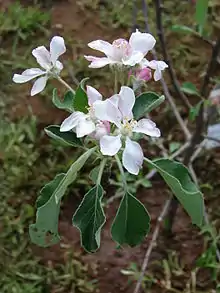 |
Bahamas | 1964 | Grown from chance seedling of Golden Delicious. Yellow with (10-40%) red flush. Flesh sweet, subacid, good. Tree vigorous. One of the most southerly apples grown in North America. | Eating |
| Double Red Baldwin[5] | New Hampshire | Discovered 1924. Introduced 1927. | Mutation of Baldwin. Darker red than Baldwin | Eating | |
| Double Red Delicious see Starking. | |||||
| Double Red Duchess see Red Duchess. | |||||
| Double Red McIntosh see McIntosh Rogers. | |||||
| Double Red Rome Beauty[5] | Washington, US | Discovered 1925, Introduced 1927 | Mutation of Rome Beauty. | Eating | |
| Double Red Wealthy[5] | New York, US | Discovered 1933, Introduced 1940 | Dark red mutation of Wealthy. | Eating | |
| Double Red Willow Twig[5] | Illinois, US | Discovered 1927, Introduced 1929. | Dark red mutation of Willow Twig | Eating | |
| Dougherty/Red Dougherty | .jpg.webp) |
Australia, New Zealand | 1930 | Red Dougherty is a recent mutation discovered in New Zealand from the old Australian Dougherty. | Eating |
| Downton Pippin[6] | Herefordshire, England | 1806 | A dessert apple of first-rate quality. Use November to January. H 44 W 54. Parentage: Orange Pippin x Golden Pippin. | Eating | |
| Drakenstein[10] | South Africa | Introduced 1981 | Round, bright red. P (Wemmershoek x Granny Smith) x Richared Delicious. Tree vigorous. | Eating | |
| Duchess of Oldenburg(syn. Charlamowsky, Borowinka)[8][13] |  |
Russia | 18th century | Has red stripes with splashes of green. Excellent resistance to freezing temperatures. Stalk 20 mm. W 71-76, H 58-68. | Cooking, Eating |
| Duchess's Favourite[21] | Surrey, England | c1800 | A yellow apple with red flush. W 58, H 61. Stalk 12 mm. Flesh white, acid. Pick late August. Use August - September. | Eating | |
| Dudley Winter(syn. Dudley)[116] | 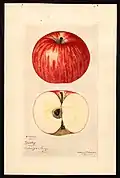 |
Castle Hill, Maine, US | 19th century | A medium-sized oblate apple with greenish-yellow skin covered with red stripes over a solid red blush. W 74, H 60. Stalk 12 mm. Flesh is firm but tender, juicy, aromatic and quite tart, becoming milder as it ages. Good for fresh eating and cooking; rated by many as one of the best for apple pies and sauces. Tree is a natural semi-dwarf, very hardy and bears heavily annually. | Cooking, Eating |
| Duke of Devonshire[8][21] | Lancashire, England | Raised 1835. Introduced 1875 | Dessert apple, resistant to scab and canker. W 61-69, H 54-56. Stalk 5 mm. Pick early October. Use January - March. | Eating | |
| Dülmener[18] | 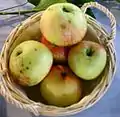 |
Germany | 1870 | W 83, H 68, We 195. Stalk 10–16 mm. Pick September. Use September - December. | Cooking, Eating |
| Dummellor's Seedling agm[117] also known as Dumelow's Seedling[118][21] | 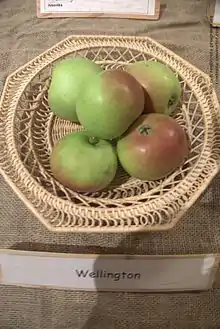 |
Shackerstone, Leicestershire, England | <1800 | Roundish-oblate apple with pale greenish-yellow skin strewn with large russet dots, occasionally covered with a delicate pinkish-orange blush. W 77, H 61. Stalk 11–14 mm. Flesh yellow-tinted white flesh, aromatic, firm, crisp, tart, and very juicy. One of the most widely grown culinary apples of Victorian England, esteemed for its fine flavour and good keeping qualities. Pick mid October. Use November - March. | Cooking |
| Dungay[92] | England | <1884 | An excellent cooking apple. W 76 H 63. Stalk 25 mm. Use October - December. | Cooking | |
| Dunning[5] | Geneva, New York, US | Raised 1923. Introduced 1938 | P Early McIntosh x Cox Orange. Flesh sweet. Pick early August. | Eating | |
| Dutch Codlin(syn. Chalmers Large, Glory of the West)[92] | Netherlands ? | 1783 | One of the best kitchen apples. Greenish yellow with red flush. Stalk 25 mm and thick. Eye small and closed. Flesh white and sub -acid. Use August to September. | Cooking | |
| Dutch Mignonne[119] | Holland | <1771 | Medium size round. Flesh, cream, crisp, juicy. Stem long. Use November - February | Eating Cooking. | |
| Dyer(syn. Pomme Royale)[120][121][122] | ? | ? | A yellow apple with brown flush. W 72, H 60. Stalk 20 mm. Tree vigorous. Flesh yellow, crisp, tender, aromatic, subacid, aromatic, very good to best. Use September - October. | Eating | |
| Dymock Red[92] | Gloucestershire, England | ? | A roundish or oblate red apple. H 41, W 54. Stalk very short. Pick late September. | Eating, Cider | |
| Egle | Lithuania | Eating | |||
| Eady's Magnum[8] | England | c1908 | W 91, H 73. Stalk short. Flesh white, juicy, acid. Pick mid October. Use December - March. | Cooking | |
| Early Chandler[3] | 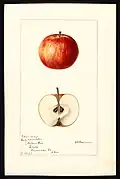 |
US | <1875 | Stalk short. Flesh yellow, tender, juicy, subacid. Too acid for eating. Use August. | Cooking. |
| Early Harvest(syn. July Pippin, Yellow Harvest, Tart Bough)[3][123][28][124] | 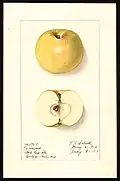 |
US | <1806 | W 58-85, H 39-70. Stalk 17–20 mm. Flesh white, crisp, tender, juicy, subacid, good to very good. Pick and Use July. | Eating |
| Early Joe[3][125][126][127] | 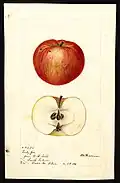 |
New York US | <1843 | W 61, H 46. Stalk 20 mm. Flesh whitish, tender, juicy, vinous flavor, very good to best. Tree is a slow grower. Use mid August - mid September. | Eating |
| Early Julien[6] | Scotland | <1800 | An excellent culinary apple. The tree is not a large grower. H 48, W 60. | Cooking | |
| Early McIntosh[5] | 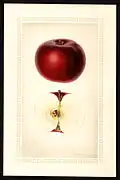 |
Geneva, New York, US | Introduced 1923 | P Yellow Transparent x McIntosh. Flavor excellent. Pick early August. | Eating |
| Early Nonpareil[92] | Norfolk, England | c1780 | W 57, H 45. Flesh crisp, aromatic, subacid. | Eating | |
| Early Pennock(syn. Shaker Yellow, Homony)[4] | 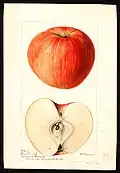 |
US | <1800 | W 79, H 70,. Stalk 12 mm. Flesh yellow, avid. Quality poor. Use July - August. | Cooking |
| Early Ripe[3][128] | 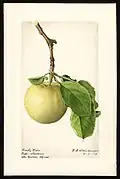 |
Pennsylvania ? US | <1867 | W 75, H 559. Stalk 15 mm. Flesh white, tender, juicy, subacid. Good. Tree productive. | Eating |
| Early Strawberry[3][129][28][130] | 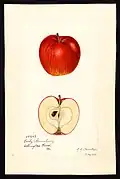 |
New York US | <1838 | W 58-63, H 49-52, Stalk 25–33 mm. Flesh white, tender, subacid, aromatic, very good. Use July - September. | Eating |
| Early Victoria[8] | Essex, England | 1899 (introduced) | Possibly from Lord Grosvenor × Keswick Cod. Also called Emmeth Early. Ripens in late July. Pale yellow fruit. | Eating | |
| Easter Orange[50][7] | England | <1897 | Round conical, deep golden yellow with flush and stripes of dark brown red. Flesh firm, yellow, of good flavour. AM from RHS in 1897. H 63, W 66. Use February - April. | Eating | |
| Ecklinville[8] | Ecklinville, Ireland | c. 1820 | Large, round, greenish-yellow. H 63, W 78. An excellent early cooker. Pick September. Use September - October. | Cooking | |
| Edelborsdorfer[97] |  |
Germany | <1600 | A green apple with red flush and russet. W 70, H 63. Pick October. Use December–March. | Eating, Cooking |
| Edelrother[34] | 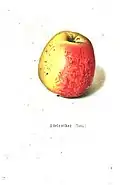 |
<1856 | Yellow with red flush. W 65, H 61. Stalk 16 mm. Use November - January. | Eating | |
| Edith Hopwood[131] | Essex, England | <1929 | Yellow with russet. Stalk very long. Use October-November. | Eating | |
| Edward VII[7]agm[132][21] |  |
Worcestershire, England | 1908 (introduced) | A large oblate-round apple with yellow-green skin and pinkish-brown blush. W 83, H 70. Stalk 6 mm. AM from RHS in 1903. Suitable for more northerly, cold, wet climates. White flesh is sharp and pleasant. Extraordinary keeper; apple ripens in autumn and will keep until Easter. P Possibly Blenheim Orange × Golden Noble. Pick mid October. Use December - April. | Cooking |
| Edwards[3] | 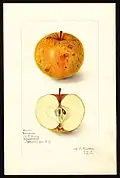 |
N.C. US | <1870 | A greenish yellow apple, lightly striped with red. Flesh juicy, firm. One of the best keepers. | Eating |
| Edwin Beckett[133][134] | England | <1915 | Green to yellow with red flush. W 100, H 114. | Cooking | |
| Egremont Russet agm[135][21][136] | 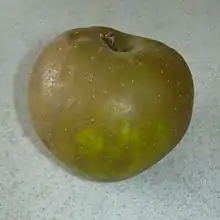 |
Sussex, England | 1872 | W 64 - 67, H 48-57. Stalk 6–10 mm. Brown russeting, nutty flavor. Excellent keeper. Resistant to scab, very prone to bitter pit. Pick late September. Use October - December. | Eating |
| Ein Shemer[10] | Israel | 1963 | P Zabidani × Golden Delicious. This variety ripens in June. Tastes tart, does not do well in cold weather. (Not the same as Anna (apple)) | Eating | |
| Elektra[18] |  |
Germany | W 68, H 58, We 95-100. Stalk 5 – 15 mm. Pick October. Use November - February. | Cooking, Eating | |
| Ellison's Orange[137][7] agm[138][21][139] |  |
Lincolnshire, England | 1911 | W 67, H 57. Stalk 15 – 35 mm. Cox's Orange Pippin × Cellini. FCC from RHS in 1917. Rich aniseed flavor. Pick mid September. Use September - October. | Eating |
| Elstar agm[140] | 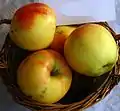 |
Netherlands | 1950s | Golden Delicious × Ingrid Marie. Medium-sized, mostly red with yellow showing. Often used in desserts due to its intense honey flavor. | Cooking, Eating |
| Emneth Early[141][7] agm[142][21] | Cambridgeshire, England | <1899 | W 64, H 61. Stalk 23 mm. Suitable for northerly, cold, wet climates. P Hawthornden x Keswick Codlin. A biennial crop that needs thinning. AM from RHS in 1899. Good disease resistance. Pick Late July to early August. Use July - August. | Cooking | |
| Empire[143] | 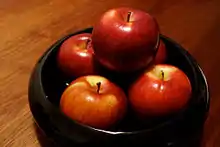 |
Geneva, New York, US | Introduced 1966 | P McIntosh x unknown. Lovely white subacid flesh. Tangy taste. Ruby red color. | Eating |
| Empire Red[5] | British Columbia, Canada | Introduced 1942 | A red apple. P unknown. | Cooking, Eating | |
| Empress[10] | Geneva, New York, US | Introduced 1988 | A dark red apple, fair. P Jonamac x Vista Bella. | (Eating) Cooking | |
| Encore[8][21][7] | Berkshire, England | 1906 | Large cooking apple. W 83-96, H 73-90. Stalk 10–15 mm. First Class Certificate from RHS in 1908. Pick mid October. Use December to April. | Cooking | |
| Engelsberger[144] |  |
Germany | 1854 | A German cider apple. Sugar-acid ratio 10:1. Juice yield 70-75%. Pick late September - Early October. | cider |
| English Codlin(syn. Common Codlin, Codlin, Quodlin)[7] | England | <1600 | Yellow with red flush and russet. W 82, H 64. Flesh, tender, white. acid, good. Stalk long. Use August - September. | Cooking | |
| English Russet[3][145] | 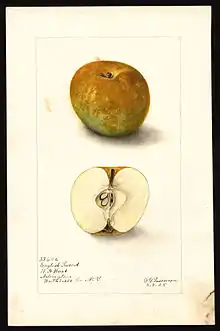 |
? | <1870 | W 69, H 62. Stalk 13 mm. Flesh yellowish-white, crisp, subacid. Good. Use January - May. | Eating |
| Enterprise | < | Illinois, US | 1993 | Classic North American red apple. Stores well up to six months. Makes very good candy apple. | Eating |
| Envy | 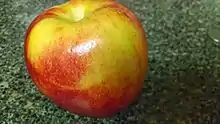 |
New Zealand | 2009 | Sweet and crispy, takes 4–8 hours after cutting to start browning. Royal Gala × Braeburn. | Eating |
| Epicure[8] | Bedford, England | 1909 | Yellowish apple with reddish blush. Good clean taste. Award of Merit from RHS in 1931. W 63, H 54. Stalk long. Needs thinning for size. Prone to bitter pit, canker. Pick mid August. Use August - September. | Eating | |
| Erickson[5] | Minnesota, US | Introduced 1923 | A large green apple. | ||
| Erwin Baur[18] |  |
Germany | 1955 | W 68-80, H 57, We 105-212. Stalk 15 – 20 mm. Pick October. Use December - March. | Cooking, Eating |
| Esopus Spitzenburg[3][28][146][147] | 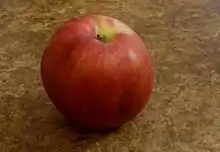 |
Esopus, New York, US | c. 1750 | Grown by Thomas Jefferson at Monticello. Named for creek near which first seedling found. Heirloom variety still available at farmstands in Northeast and portions of Virginia. Flesh yellow, firm, crisp, juicy, aromatic, subacid, very good to best. Difficult to grow for inexperienced planters. W 73-77, H 68-76. Stalk 19–24 mm. Use December - February. | Cooking, Eating |
| Etter's Gold[5] | California US | Introduced 1944 | Golden yellow. P unknown. Flesh crisp. Pick October. | ||
| Eva[10] | Brazil | A yellow apple red striped(70%). P Gala x Anna. Flesh sweet, subacid, good. Tree very productive. | Eating | ||
| Evagil[7] | England | Introduced 1863 | A golden yellow apple. Stalk very short. Flesh pale yellow, hard, dry. Use September - October. | Cooking, Eating | |
| Evening Party[3] | 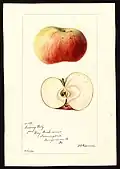 |
US | <1860 | W 68, H 52. Stalk 14 mm. Flesh juicy, vinous, aromatic. Use December - January. | Eating |
| EverCrisp | Indiana, US | 2008 | Described as Fuji x Honeycrisp | Eating | |
| Ewalt[4] | 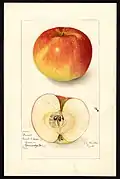 |
Pennsylvania, US | <1850 | A large apple, yellow with red flush. W 75, H 63. Flesh acid, aromatic. Use February - April. | Eating |
| Exeter Cross[8] | England | 1924 | P Worcester Pearmain x Beauty of Bath. W 59, H 47. Stalk variable. Flesh crisp, juicy, sweet. Pick early August. Use August. | Eating | |
| Exquisite (Laxton Exquisite)[8] | Bedford, England | 1902 | Award of Merit from RHS in 1926. W 70, H 67. Stalk short to medium. Flesh sweet, aromatic. P Cox Orange x Cellini. Pick late August. Use September - October. | Eating | |
| Fagerö[97][14] |  |
Sweden | <1860 | W 75-80, H 68. A red mutant of Grågylling. Use October - December. | Eating |
| Fallawater(syn. Tulpehocken)[4][148] | 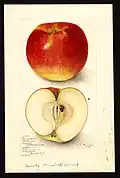 |
Pennsylvania, US | <1842 | W 88, H 70. Stalk 8 mm. Flesh greenish white, crisp, juicy, mild subacid, good. Use November - December. | Eating |
| Fall Harvey[28] | 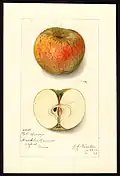 |
US | <1838 | Flesh whitish, crisp, juicy, subacid, high flavor. Use October - December. | Eating |
| Fall Jenneting(syn. Fall Jeneting)[28] | 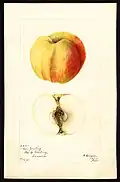 |
Connecticut, US | <1827 | Flesh yellow, crisp, tender, juicy, subacid. Tree strong grower. Use September - December. | Cooking |
| Fall Orange[149][150] | _(19123404444).jpg.webp) |
Mass. US | <1848 | Pale Yellow. W 85, H75. Stalk 17 mm. Flesh white , crisp, tender, juicy, subacid, aromatic. A poor shipper. Biennial. Quality: eating excellent, cooking very good. Use September - December. | Eating, Cooking |
| Fall Pippin[151][59][4][152] | 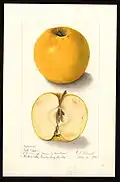 |
US | <1806 | Large yellow, roundish to roundish oblate. W 99, H 86. Stalk 22 mm. Flesh whitish - yellow, firm, fine, tender, very juicy, subacid, aromatic, very good. Pick September, use September - December. AS s. | Eating, Cooking |
| Fall Swaar(sy. Autumn Swaar)[4] | 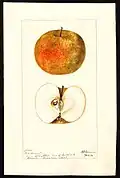 |
US | <1800 | W 70, H 58. Stalk 13 mm. Flesh yellow, juicy, mild subacid. Use September. | Cooking, Eating |
| Fall Wine(syn. Ohio Wine, Musk Spice, Sweet Wine)[3] | 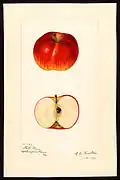 |
US | <1800 | W 75, H 56. Stalk 23 mm. Flesh yellowish, juicy, aromatic, mild, subacid, sweet. Use September - November. | Eating |
| Falstaff[153] | Kent, England | 1966 | A good pollinator. | Dessert | |
| Fameuse[8][4][3][28][154][155] | 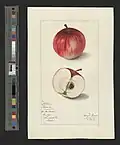 |
Canada | <1730 | Small apple, very sweet, flavour similar to McIntosh. Flesh white, tender, juicy, subacid, perfumed, very good. W 60-72, H 53-56. Stalk 11–17 mm. Pick late September. Use October - November.Of no value in Britain. | Eating |
| Family[3] | 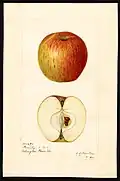 |
Georgia, US | <1860 | W 78, H 58. Stalk 20 mm. Flesh White, juicy, mild, pleasant, subacid. Use August - September. | Eating |
| Fanny[59][156][157] | _(19559280379).jpg.webp) |
Pennsylvania, US | <1869 | A bright red fruit of good dessert quality. W 63, H 50. Roundish slightly oblate. Tree vigorous. Flesh yellow, firm, fine, tender, juicy, mild subacid, good to very good. Use September - November. | Eating |
| Faurot[5] | 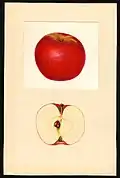 |
Missouri, US | Introduced 1935 | P Ben Davis x Jonathan. Tree disease resistant. | |
| Fearns Pippin[6] | London, England | <1780 | An excellent apple for eating and cooking. The tree is very hardy and a great bearer. W 64, H 53. Stalk medium. Picking late September - early October. In use from November to February. | Cooking, Eating | |
| Federal Pearmain(syn. Staaten Parmäne)[92] | England | <1831 | W 70, H 57. Yellow red streaked. Flesh vinous. | Eating | |
| Feltham Beauty[7] | Buckinghamshire, England | <1908 | Yellowish-green with red stripes and flush. W 76, H 70. P Cox Orange x Gladstone. Flesh, crisp, sweet, very good. Use August - September. | Eating | |
| Fenouillet Gris[6] | France | 1608 | A dessert apple of great excellence. H 50 W 64. Short stalk. Picking time October. Use November - February. | Eating | |
| Fiesta agm[158][21] | 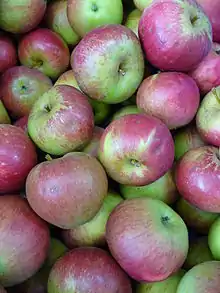 |
Kent, England | 1972 | Sometimes called Red Pippin. Claims both UK and US heritage: P Cox's Orange x Idared. W 58, H 51. Stalk 22 – 30 mm. Has flavour similar to the former but storage, colouring, and cold tolerance of the latter. Can be susceptible to scab and canker.Pick mid September. Use October - January. | Eating |
| Filippa[14] | 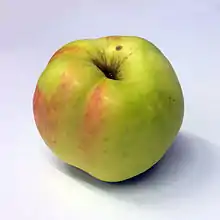 |
Denmark | 1893 | A yellow apple with some red overcolour. W 63, H 58. Pick September. Use September - December. | Cooking, Eating |
| Fillbasket[6] | England | <1875 | Name of two different apple cultivars. One from Lancashire and the other from Kent. | Cooking | |
| Fink(syn. Fink's Seedling)[4] | 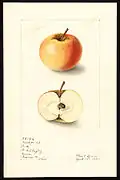 |
Ohio, US | <1847 | A small apple. Flesh whitish, juicy, subacid good to very good. Good keeping qualities (one year). | Eating |
| Fireside[5] | Minnesota, United States | Introduced 1943 | Very fragrant. Yellow with red striping. Sweet apple, very popular in upper Midwest. Use November - April. | Eating | |
| Fiskhill[159] | _(19559358679).jpg.webp) |
New York, US | <1869 | W 70-93, H 65. Stalk 16 mm. Tree vigorous. Flesh white, firm, coarse, juicy, mild subacid, fair to good. Use November - February. | Eating, Cooking |
| Flake's Fall[3] | Pa., US | <1869 | Yellow with red flush. W 95, H 73. Stalk 17 mm. Flesh juicy, subacid, aromatic. Use October - November. | Eating | |
| Flame 1.[143] | Essex, England | 1925 | W 67, H 56. Yellow, striped scarlet. Flesh, sweet, aromatic, subacid. | Eating | |
| Flame 2.[5] | Minnesota, US | Introduced 1943 | Crab apple. P unknown. | Ornamental | |
| Flamenco | .jpg.webp) |
United Kingdom | 1950–1999 | A columnar ornamental tree with delicious fruit | Eating |
| Flandrischer Rambour[34] |  |
? | <1800 | A yellow apple with red flush. W 93, H 67. Stalk 13 mm. Use November - January. | ? |
| Flickäpple[14] | Sweden | <1850 | A large cooking apple. Yellow with red stripes. H 55, W 80. | Cooking | |
| Florina | 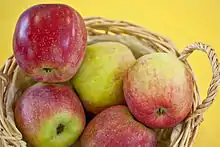 |
Angers, France | (Querina), scab resistant | Eating | |
| Flower of Kent[6] | Kent or Lincolnshire England | <1629 | A first-rate kitchen apple from October to January.W 89, H 70. Flesh crisp, subacid. This is the variety that inspired Sir Isaac Newton to consider gravity. | Cooking | |
| Flushing Spitzenberg[4] | 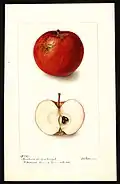 |
US | <1822 | Flesh white, yellow, juicy, crisp, mild, sweet, good. Use November - February. | Eating |
| Folwell[5] | Minnesota, US | Introduced 1922 | A large apple. P Malinda x unknown. | ||
| Foote(syn. Foote's Nonpareil)[3] | 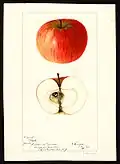 |
Mass. US | <1875 | Flesh firm, juicy, aromatic, subacid, very good. Trre vigorous, annual bearer. Use November. | Eating |
| Forge[8] | Sussex, England | <1851 | A yellow apple with red Flush. W 60, H 54. Stalk short. Flersh white, crisp, juicy, aromatic. Pick late September. Use October - November. | Eating | |
| Fortune agm[160] (Laxton's Fortune)[21] | England | 1904 | Cox's Orange Pippin × Wealthy. First Class Certificate from RHS in 1948. W 68, H 60. Stalk 25 mm. Prone to canker, good resistance to scab. Tendency to be biennial. Pick early September. Use September - October. | Eating | |
| Foundling(syn. Shirley, Groton)[4] | 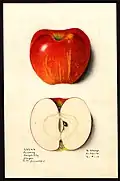 |
Mass. US | <1820 | A medium to large apple. Flesh white, tender, juicy, subacid, aromatic, very good. Use September. | Eating |
| Fourth of July(syn. Sibirian August, August Apple)[3] | 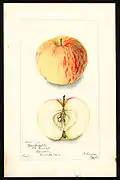 |
Germany | <1875 | Flesh white, juicy, subacid, good. Stalk short. Tree a strong grower. | Cooking, Eating |
| Fox Kernel(syn. Sack)[92] | Herefordshire, England | ? | Yellow with red stripes. H 70, W 70. | Cider | |
| Foxley[92] | England | c1800 | Very small. Stalk 25 mm. Raised by Thomas Andrew Knight. | Cider | |
| Foxwhelp[92] | Herefordshire, England | <1650 | Striped red and yellow. Flesh yellow with a rough acid flavour. W 63, H 63. Stalk 19 mm. | Cider | |
| Fraas Sommer-Calvill[34] |  |
Germany | c1850 | W 74, H 68. Stalk 15 mm. Use September - October. | Eating |
| Franklin[5] | Ohio, US | Introduced 1937 | P McIntosh x Delicious. | Eating | |
| Fred Hough[10] | Brazil | Introduced 1994 | Small to medium, red striped. Very low acid content. P NJ 76 x Coop 14. | Eating | |
| Freedom[144] | US | 1983 | |||
| French Pippin[3] | 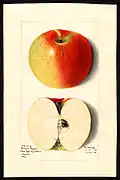 |
? | <1850 | Flesh yellowish, tender, subacid, good. Tree vigorous. Use October - January. | Eating |
| Freyberg[8] | New Zeeland | 1934 | P Golden Delicius x Cox Orange. W 65, H 56. Stalk long. Flesh white, juicy, sweet, aromatic. Pick early October. Use October - December. | Eating | |
| Freiherr von Trauttenberg[34] |  |
Germany | <1850 | W 69-71, H 65-76. Stalk 10 mm. Use November - February. | Cooking, Eating |
| Frieherr von Berlepsch[18] | 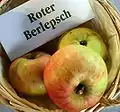 |
Germany | 1880 | 54x63mm. One of the best eating apples. High in Vitamin C. Picking September. Use October–December. | Eating |
| Frogmore Profilic[8] | Windsor, England | c1865 | A yellow apple with red flush. W 70, H 60. Stalk long. Flesh white, soft, juicy, acid. Pick late August. Use September - November. | Cooking | |
| Frostproof[5] | Virginia, US | Discovered 1930. Introduced 1947. | P unknown. Quality fair. Tree blooms 30 days later than most apples usually do. | Eating | |
| Frösåker[13] | 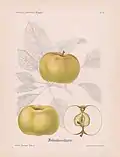 |
Sweden | <1900 | A yellow apple. W 58-63. H 45-50. Stalk 12mm. Pick October. Use November - January. | Eating |
| Fuji[161][10] |  |
Aomori, Japan | 1930s, Introduced 1962 | P Red Delicious × Ralls Genet. Dark red, conic apple. Sweet, crisp, dense flesh is very mildly flavoured. Keeps very well. One of the most widely grown apple varieties in the world. | Eating |
| Fuji Frey[10] | Brazil | Introduced 1995 | Bud mutation of Fuji. | Eating | |
| Fyan[5] | 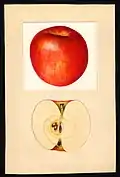 |
Missouri, US | Introduced 1935 | P Ben Davis x Jonathan. Ripens 2 weeks after Jonathan. Tree very vigorous, regular bearer, resistant to disease. | Eating |
| Gala, Royal Gala[8][21] | 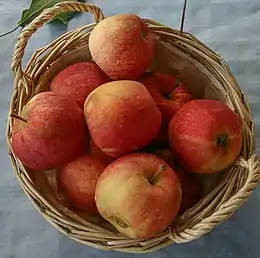 |
New Zealand | 1970s | A small to medium-sized conic apple. W 61, H 58. Stalk 25 mm. Thin, tannic skin is yellow-green with a red blush overlaid with reddish-orange streaks. Flesh is yellowish-white, crisp and grainy with a mild flavour. Cross of three of the world's best known apples: Kidd's Orange Red (a cross of Red Delicious and Cox's Orange Pippin) × Golden Delicious. One of the most widely available commercial fruit. Pick early October. Use October - January. | Eating |
| Galbraith Baldwin[5] | Massachusetts, US | Introduced 1948 | Mutation of Baldwin. Highly colored. | Eating | |
| Galícia[10] | Brazil | 1987 | P Gala x Anna. Flesh crisp, juicy. Tree very productive. | Eating | |
| Galloway[8] | .jpg.webp) |
Scotland | <1871 | Large eating and cooking apple. First Class Certificate from RHS in 1871. W 90, H 71. Stalk short. Pick late September. Use November–February. | Eating, Cooking |
| Ganges[92] | England | ? | A green kitchen apple. Use October - February. | Cooking | |
| Garden Royal[3] | 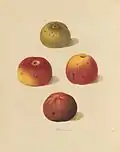 |
Sudbury, Massachusetts, US | <1847 | A medium-sized roundish-oblate, sometimes slightly conical apple. W 70, H 57. Stalk 22 mm. Greenish-yellow skin is striped and splashed with bright red, dull or grayish toward the stem; dots few, light and gray; cavity deep, basin shallow, slightly uneven. Flesh yellow, very tender, juicy, rich, mildly subacid and aromatic. Poor keeper. Upright habit, productive bearer, some biennial tendency. Use late August - September. | Eating |
| Garden Sweet[3] | 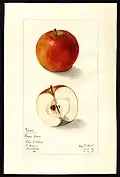 |
New England, US | <1875 | Stalk short and small. Flesh, yellowish white, tender, juicy, sweet. Tree hardy and productive. Use September - October | Cooking |
| Garretson's Early(syn. Somerset Harvest)[4] | 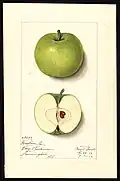 |
New Jersey, US | <1840 | Medium size. Stalk short. Flesh white, tender, juicy, subacid, good. Use July - August | Cooking, Eating |
| Gascoyne's Scarlet[8][18][21] | 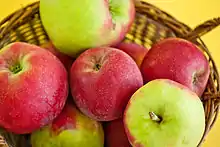 |
Kent, England | 1871 | Large red fruit. W 77, H 63, We 145. Stalk 15 – 25 mm. FCC from RHS in 1887. Pick mid September. Use October - December. | Eating, Cooking |
| Geheimrat Dr. Oldenburg[144] | 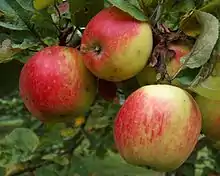 |
Germany | 1897 | Created at the Höheren Lehranstalt für Obstbau of Geisenheim in the Rheingau; Minister von Hammerstein × Baumanns Renette. | Eating |
| Gehrers Rambour[144] |  |
Germany | 1885 | A german cider apple. Sugar-acid-ratio 8:1. Juice yield 75-80%. Pick late October. | cider |
| Gelber Richard[13] | 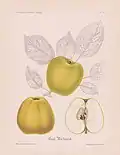 |
Germany | <1830 | A yellow apple. W 66, H 66. Stalk 10 mm. Pick October. Use November - March. | Eating |
| Georg Carpenter[8] | Surrey, England | 1902 | P Blenheim Orange x King of the Pippins. W 74, H 66. Stalk long. Flkesh white, juicy, sweet, aromatic. Pick mid September. Use October - December. | Eating | |
| George Cave[8][21] | Essex, England | 1923 | Pale green-yellow fruit with red flush. Early harvest. W 57, H 51. Stalk 15 – 20 mm. Pick August. Use August. | Eating | |
| George Neal[162][21] | Kent, England | 1904 | Pale green to yellow colour, will keep nicely until late autumn. Award of Merit from RHS in 1923. W 82, H 63. Stalk 10 – 20 mm. Good regular crops. Pick late August - early September. Use August - September. | Cooking | |
| Gestreifter Herbst-Calvill[34] |  |
<1670 | Gelb with red flush. W 67, H 69,. Stalk 12 mm. Use November - January | Cooking, Eating | |
| Gestreifter Winter-Calvill[163] |  |
Germany | <1840 | Yellow with red stripes. W 70, H 60. Pick October. Use November - February. | Eating, Cooking |
| Gideon[164][165] | 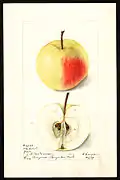 |
Minnesota, US | ca 1880 | Tree vigorous. Flesh yellow, soft, coarse, crisp, juicy, subacid, fair to good. Use October. | Eating |
| Gilpin(syn. Carthouse, Little Red Romanite.[4][3] | 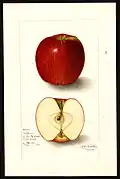 |
Virginia, US | <1850 | W 80, H 70. Stalk 17 mm. Flesh greenish-yellow, sweet, juicy. Pick October. Use December - May. | Cider, Eating |
| Gipsy King[92] | England | <1872 | A handsome dessert apple. W 64, H 45. Stalk 12 mm. Use October - December. | Eating | |
| Gladstone[21][166] | England | 1780, Introduced 1868 | W 63-79, H 54-62. Stalk 9–17 mm. A red apple. Pick late July - early August. Use July - August. | Eating | |
| Glanz Reinette[34] | 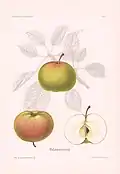 |
Germany ? | <1850 | A green apple with red stripes. W 58, H 50-53. Stalk 14 mm. Pick October. | Eating |
| Glockenapfel[144] |  |
Switzerland | 17th century | A medium-sized green-yellow elongate bell-shaped apple, sometimes takes on a reddish blush. Tart and juicy, stores well, taste improves with age. Excellent culinary variety; renowned for its use in Strudel. | Cooking, Eating |
| Gloria Mundi(syn. Pound)[6][167][168] | 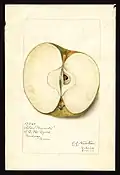 |
US | <1804 | An excellent green culinary apple. W 89, H 76. Stalk short. Flesh yellow, coarse, crisp, tender, juicy, mild subacid, fair to good. Pick mid October. Use October - December. | Cooking |
| Glorie van Holland[50] | Netherlands | c1890 | Flesh slightly acidic, slightly sweet. | Eating | |
| Glory of the West syn. Englischer Prahlrambour)[6] | England | <1800 | A culinary apple of first quality. W 82, H 72. Pick October. Use October - December). | Cooking | |
| Gloster (aka Gloster 69)[8] |  |
Germany | 1969 | Conical shape. Somewhat tart, ruby red color like parent Red Delicious. Good choice for backyard gardening. W 70, H 67. Stalk long. Pick late October. Use November -March. | Eating |
| Ginger Gold | 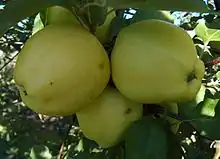 |
Virginia, US | 1960s | Tangy flavour, crunchy texture, pale green-yellow colour. Noted for being an extremely early bearer (Europe by September 1, California late July, Eastern US in August). | Cooking, Eating |
| Godfrey[5] | Manitoba, Canada | Introduced 1931 | P Patten Greening x unknown. A dark red apple. Flesh white, crisp, sweet. Tree vigorous. Use October - February. | ||
| Gogar Pippin(syn. Stone Pippin)[6] | Scotland | <1850 | A dessert apple of second rate quality. Use January - March. | Eating | |
| Golden Ball[3] | 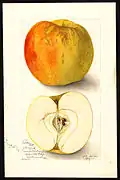 |
Conn. US | <1880 | A large apple. Flesh crisp, tender, subacid. Use December - March. | Eating |
| Golden Delicious[169][18][170] | 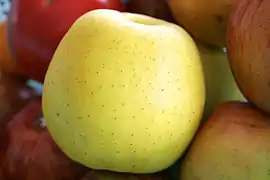 |
Clay County, West Virginia, US | 1914 | One of the most popular varieties in the world. Due to its regular size, even colour and storage qualities the fruit is widely sold commercially. Uniform light green-yellow coloration. Flesh firm, crisp, tender, juicy, mild subacid, aromatic, very good to best. A good pollinator. W 63-72, H 58-62, We 145. Stalk 20 – 30 mm. Pick October. Use October - May. | Eating, Cooking |
| Golden Harvey(syn. Brandy Apple)[6][7] | England | <1821 | A yellow apple with russet H 52, W 49. One of the richest and most excellent dessert apples, it is also one of the best for cider. Use December - May. | Eating, Cider | |
| Golden Knob(syn. Old Lady, Old Maid)[6][7] | England | <1850 | Orange-brown with russet. A good late keeping dessert apple. Flesh firm, subacid, good. Leaf large, very dark. H 35, W 42. Use December - March. The tree is a strong grower. | Eating | |
| Golden Monday[6] | England | <1850 | A kitchen apple. Flesh sugary, briskly flavoured. Use October - December. | Cooking | |
| Golden Noble agm[171][18][21] |  |
England | 1820 | Tree is short and stocky. Produces mint green fruit with blush of pink. W 60-90 , H 50-80, We 150-250. Stalk 5-15mm. Good disease resistance. Pick early October. Use October - January. | Eating |
| Golden Nonpareil[6] | England | <1850 | A first rate dessert apple. Flesh juicy, sugary with a rich flavour. Use December - February. | Eating | |
| Golden Orange | Italy | 1979 released 1996 |
PRI 1956-6 × Ed Gould Golden. Resistant to scab. Moderate vigour, spreading habit and medium-late blooming season; fruit is moderately large (207 g) and symmetric, skin is smooth, no russeting. Ripens some days after Golden Delicious; fruit is very attractive; large, good storage ability. | Eating | |
| Golden Reinette see Orleans Reinette | |||||
| Golden Russet[172][173] |  |
New York | 1845 (documented) | A medium-sized heavily russeted light green apple, occasionally with a reddish blush. W 73, H 72. Stalk 12 mm Crisp, fine-grained flesh is rich, sugary and very sweet. Excellent dessert apple, keeps very well. Makes extraordinary cider, known as the "Champagne of cider apples." Use December - April. | Cider, Cooking, Eating |
| Golden Spire[7] | Lancashire, England | 1850 | A golden yellow apple. An old Northern English variety. Flesh pale yellow, juicy, soft. P Keswick Codlin x Manks Codlin. W 64, H 82 Unusually tall and oblong with a tart flavour. | Cooking (Cider, Eating) | |
| Golden Supreme | Idaho, US | 1960 | Eating | ||
| Golden Sweet[59][4][3][28][174] | 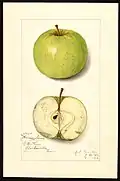 |
Connecticut, US | <1832 | W 76-79, H 59-63. Stalk 23–30 mm. A yellow apple. Fleshyellow, firm, tender, juicy, very sweet, aromatic, good to very good. BB. Use August - September. | Eating |
| Goldrush[175] | _jm94416.jpg.webp) |
Indiana, US | 1980 | The fruit has a complex spicy flavor with high acidity and sweetness. Acidity moderates in cold storage, with exceptional quality after 2 to 3 months. | Eating |
| Goldspur | 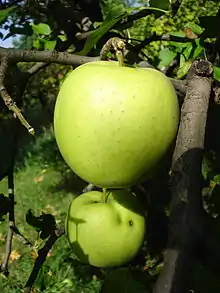 |
US | 1960 | A sport of 'Golden Delicious'. | Eating |
| Goodwood Pippin[176] | Goodwood, Sussex, England | <1896 | Yellow striked with red. Round to conical. The stalk is set in a narrow, rather deep russety cavity. W 82, H 82. AM from RHS in 1896. | Cooking | |
| Goosebery Pippin(Ronalds´)[6] | Cheshire, England | <1875 | A very excellent dessert apple; ripe in November. Small fruit, small tree. | Eating | |
| Gordon | Whittier, California, United States | 1977 | A low chill hour cultivar developed by Robert B. Gordon in Whittier, CA from unknown parentage. Blooms over long period in Southern CA - from April to early June. Bears mature fruit from August to October. Fruit is green with red striped overcolor. Ripe at approximately 50% red coverage. Fruit is dual purpose, for eating and baking with sweet-tart flavor. | Eating & Cooking | |
| Gradirose | Languedoc-Roussillon, France | 2004 | Created by Pépinières Grard. Early dessert apple with pink blush. Ripens in September and stores well. Very productive. | Eating | |
| Gragg (aka Red Gragg or Winter Queen) | North Carolina, US | 1860 | Originated on the farm of James Gragg in Caldwell County, NC about 1860. Valued by North Carolina growers for its fine cooking qualities, crispness and long storage ability. The conical shaped fruit is red in colour with moderately conspicuous dots. Ripens in October and is a great keeper. | Cooking, Eating | |
| Grågylling[13][14] |  |
Europe | <1800 | W 64-68, H 54-60. Stalk 12 – 20 mm. Flesh juicy, subacid, fair to good. Pick early October. Use November - January. | Eating, Cooking |
| Granges Pearmain[50] | Middlesex, England | <1829 | Rather large, round, a little flattened. Colour yellow with dull red flush and broken stripes. Flesh pale yellow, very crisp and juicy and excellent flavour. Use December–May. | Cooking, Eating | |
| Granny Smith[161] | 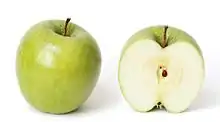 |
Australia | 1868 | This is the apple once used to represent Apple Records. W 64, H 61. Stalk 17–25 mm. A favourite variety, widely sold in the UK. Also noted as common pie apple. Lime green colouring. Extremely tart.Pick mid October. Use January - April. | Cooking, Eating |
| Grantonian[7] | Nottingham, England | <1883 | Yellowish-green with brown flush. W 76, H 64. Flesh firm, subacid. FCC from RHS in 1883. Use till March. | Cooking | |
| Graue Herbst Reinette[34] | 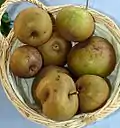 |
<1800 | W 84-95, H 64-72. Stalk 14 mm. Use November - December. | Cooking, Eating | |
| Graue Portugiesische Reinette[34] | Portugal | <1798 | W 65 - 69, H 46-50. Stalk 14 mm. Use December - April. | Cooking, Eating | |
| Grauer Kurzstiel[34] |  |
France | <1794 | W 69, H 52. Stalk 8 mm. Use December - April. | Cooking, Eating |
| Gravenstein[177][21][18][28][178] | 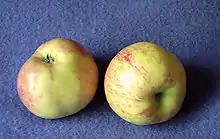 |
Gråsten, Jutland, Denmark | <1800 | An early yellow-green apple, often with red stripes. W 73-90, H 61-70. We 130. Stalk 10 – 25 mm. Tree large, vigorous. Flesh yellow, firm, fine, crisp, juicy, aromatic, subacid, very good to best. Exceptional cooking apple, especially for applesauce and pies. Poor keeper; becomes soft quickly. German immigrants introduced this variety to California's San Joaquin Valley in the mid-19th century. Has many sports. Pick late August. Use September - December. | Cooking, Eating, Pie |
| Green Cheese[3] | 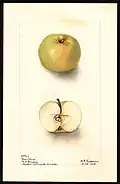 |
North Carolina or Georgia, US | 18th century | A very old southern apple thought to have originated in North Carolina or Georgia but its true origin is uncertain. The fruit is oblate to oblique in shape. W 76, H 55. The skin is deep green in colour, turning pale yellow when fully ripe. The yellowish flesh is sweet, crisp, tender and juicy. | Eating |
| Greendale[5] | Geneva, New York, US | Introduced 1938 | P McIntosh x Lodi. A green apple. | Eating, Cooking | |
| Green Newtown see Newtown Pippin | |||||
| Green Seek No Further[3] | 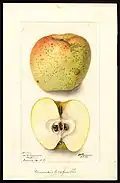 |
L.I. US | <1855 | Flesh white, crisp, tender, juicy, subacid, very good. Stalk short. Tree slow in growth. Use October - January. | Eating |
| Greensleeves agm[179][21] | .jpg.webp) |
Kent, England | 1966 | Golden Delicious × James Grieve; good garden apple, with a pleasant but unexceptional flavour. W 64-67, H 57-60. Stalk 20–22 mm. Likely named for famous Renaissance era song. Can be susceptible to scab. Pick late September. Use September - November. | Eating |
| Greenup's Pippin (syn. Yorkshire Beauty, Greenup's Apfel)[34][6] |  |
Yorkshire, England | <1800 | A first rate early culinary apple. Flesh tender, juicy, and with an agreeable acidity. W 60-77, H 46-74. . Use October - December. | Eating, Cooking |
| Grenadier agm[180][21] | .jpg.webp) |
England | 1862 (documented) | Possibly one of the strangest of all British apples: it is ribbed and lumpy with a tough coat, looking as though it has taken a beating. W 83, H 63. Stalk 10–12 mm. Grenadier cooks down to cream-coloured puree with a superb apple flavour. Makes an excellent apple jam. Poor keeper. Reliably heavy annual bearer. First Class Certificate from RHS in 1883. Good disease resistance. Pick mid August. Use August - October. | Cooking |
| Grimes Golden(syn. Grimes Golden Pippin)[181][182][8][79][183] | 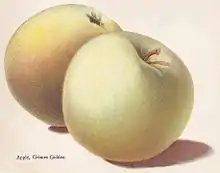 |
Brooke County, West Virginia, US | 1804 | A medium-sized roundish to slightly oblong apple. W 74, H 63. Stalk 23 mm. Greenish-yellow skin, ripening to a clear yellow, stem cavity sometimes russeted, covered with yellow or russet dots. The yellowish-white flesh is crisp and tender, with a rich, spicy, sugary-sweet flavour. A good all-purpose dessert and cooking apple, Grimes also makes a strong single-variety cider. Excellent keeper. Grimes Golden is the parent of the ubiquitous Golden Delicious. Relatively rare among apples, Grimes Golden is self-fertile. Original tree discovered near a known orchard of John Chapman (Johnny Appleseed). Use December - March. | Cider, Cooking, Eating |
| Grosh[3][184][185] | 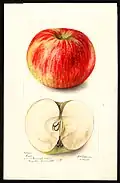 |
Pa. US | <1855 | Flesh white, loose, soft, juicy,aromatic, subacid, good to very good. Tree vigorous, an annual bearer. Use September - January. | Cooking |
| Grove[5] | 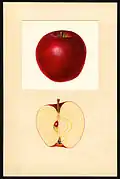 |
Missouri, US | Introduced 1935 | P Ingram x Delicious. Tree blooms late, resistant to scab. | |
| Grüner Stettiner(syn. Grüner Winterstettiner)[186] | 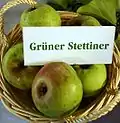 |
Germany or Poland | <1800 | A green apple. W 75, H 55. Stalk 11-15 mm. Flesh whitish-yellow, juicy, subacid. Quality good. Pick October. Use January - April. | Cooking, Drying, Juice |
| Guelph[8] | .jpg.webp) |
Berkshire, England | <1912 | Medium to large sized apple for use in October to December. First Class Certificate from RHS in 1913. | Eating |
| Gunilla Bohuslän[97] | 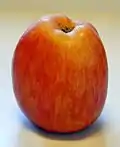 |
Sweden | <1900 | W 98, H 98. Stalk 21 mm. Use October - March. | Eating, Cooking |
| Haas(syn. Fall Queen)[187][188] | Missouri, US | <1875 | Fruit oblate-conic, ribbed, yellow with red flush. Tree large, vigorous. W 86, H 63. Stalk 20 mm. Flesh white, juicy, aromatic, subacid, poor. Use October - November. | ||
| Hagloe[4] | 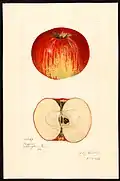 |
New Jersey, US | <1817 | Stalk short. Tree healthy, vigorous, productive. Flesh whitish, juicy, acid. Use August. | Cooking |
| Halberstädter Jungfernapfel[34] |  |
Germany | <1885 | W 80, H 74-80. Stalk 12 mm. Flesh juicy, sweet, very good. | Cooking |
| Hambledon Deux Ans[8][21] | Hampshire, England | c1750 | A yellow apple with red flush. W 78, H 64-67. Stalk 10–15 mm. Flesh white-yellow, dry, sweet, subacid, aromatic. Prone to bitter pit. Pick late September. Use November - April. | Eating | |
| Hammerstein(syn. Minister von Hammerstein)[18] |  |
Germany | 1895 | W 60 - 85, H 50 - 65, We 100-180. Stalk 15 – 25 mm. Pick October. Use January - April. | Cooking, Eating |
| Hampus[97][14][13] | 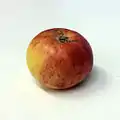 |
Holland or Sweden | <1820 | W 66-70, H 47-50 . Stalk 19– 26 mm. Flesh juicy, sweet. Pick late August - early September. | Eating |
| Hanaskogsäpple[14] | 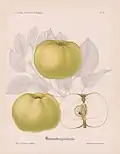 |
Sweden | 1873 | A yellow apple. W 61, H 54. Pick September. Use September. | Eating |
| Haralson[5] | 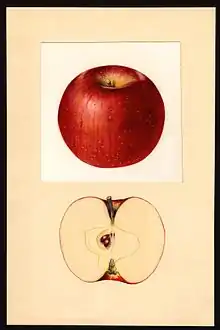 |
Minnesota, US | Introduced 1923 | P Malinda x unknown. Red colour and large, moderately conspicuous dots. Crisp and juicy with a tart flavour. Excellent choice for pies. | Cooking, Eating |
| Harberts Renette(syn. Harbert)[13][18] |  |
Germany | <1820 | Yellow with red flush. W 87, H 78. Stalk 15–20 mm. Triploid. Pick October. Use December - January. | Eating, Cooking |
| Harrison (syn.Harrison Cider)[3] | 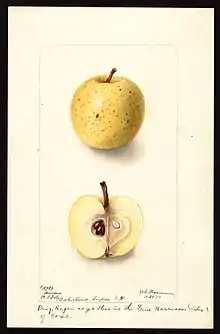 |
New Jersey, US | 1770 | Yellow skin, sometimes red-blush, black spots, small size, sweet, rich and dry. | Cider |
| Harvey[21][8] | England | 1629 | A green apple. W 76-93, H 68-81. Stalk 12 – 18 mm. Flesh white-yellow, dry, sweet. Pick mid September. Use September - January. | Cooking | |
| Hatsuaki[10] | Japan | Introduced 1976 | P Jonathan x Golden Delicious. Flesh juicy, sweet, good. | Eating | |
| Hauxapfel[144] |  |
Germany | 1925 | A German cider apple. Sugar-acid-ratio 9:1. Pick late October. | Cider |
| Havelgold[189] | Germany | P: Undine x Auralia. Flesh sharp and aromatic. Pick October. Use December - February. | Cooking | ||
| Hawaii | 1945 (introduced) | Noted for pineapple-like taste. | Eating | ||
| Hawley[3][190][191][192] | 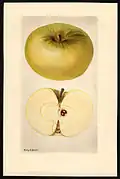 |
N.Y. US | <1855 | W 86, H 72. Stalk 17 mm.Flesh whitish, tender, juicy, subacid, very good. Tree vigorous, bears annually. Susceptible to scab. Pick September. Use September. | Eating |
| Hawthornden[14] | 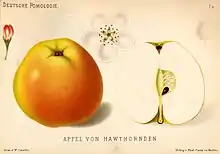 |
Scotland | c1780 | W 73, H 52. Stalk 20–25 mm. Use October–November. | Cooking |
| Hector Macdonald[7] | Berkshire, England | introduced 1906 | Pale yellowish-green. W 76, H 64. Flesh very crisp, juicy, acid. AM from RHS in 1904. Use October - February. | Cooking | |
| Helios[18] | .jpg.webp) |
Germany | W 65, H 60, We 115. Stalk 20 – 30 mm. Pick August. Use August. | Cooking, Eating | |
| Herefordshire Beefing[8] | Herefordshire, England | <1800 | A yellow apple with red flush. W 76, H 63. Stalk short. Flesh greenish white, subacid. Pick early October. Use November - January. | ||
| Herefordshire Pearmain (syn. Royal Pearmain, Old Pearmain)[4][6][3] | 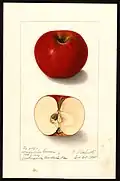 |
England ? | <1800 | W 75, H 61. Stalk 11 mm. Flesh vinous, crisp, juicy spicy, aromatic, subacid, very good. Use December - February. | Eating, Cooking |
| Herefordshire Russet |
|
Kent, England | 2002 | Cox's Orange Pippin x Idared. Rich, aromatic flavour. Pick early October, stores until January. Crops well. | Eating. |
| Herma[18] | .jpg.webp) |
Germany | W 84, H 71, We 250. Stalk 20 – 25 mm. Pick October, Use December - March. | Cooking, Eating | |
| Herrings Pippin(syn. Herring's Seedling)[193][50][21][7][194] | Lincolnshire, England | 1908 | Large round conical, rather ribbed, greenish yellow with red flush and stripes. Flesh pale yellow with spicy aromatic flavour. H 68-76, W 83. Stalk 5 – 10 mm. P Cox Orange x Cellini. Pick early September Use September - November. | Eating, Cooking. | |
| Herrnhut(syn. Schöner von Herrnhut)[12][18] |  |
Saxonia Germany | 1880 | A greenish yellow apple with red flush. W 64, H 58, We 95. Stalk 15 – 25 mm. Pick September. Use October - December. | Cooking, Eating |
| Herzogin Olga[34] |  |
Germany | <1860 | W 72-80, H 61-65. Stalk 27 mm. Pick late August. Use September. | Cooking (Eating) |
| Heta[31] | Finland | Introduced 1996 | A red apple roundish to conical. P Lobo x Huvitus. Pick late September. | Eating | |
| Heusgen's Golden Reinette(syn. Peter Heusgen's Gold-Reinette)[8] | Germany | 1877 | A yellow apple with red flush. W 70, H 60. Stalk medium. Flesh yellow, crisp, subacid. Pick Early October. Use December - March. | Eating, Cooking | |
| Heyer 12[5] | Saskatchewan, Canada | Introduced c1940 | A greenish yellow apple. Very cold-tolerant. Flesh juicy, acid. Use mid August - October. | Eating | |
| Hibernal[195][196] | Russia | <1870 | Fuit large, oblate-conic, yellow with red flush. Tree vigorous. Flesh yellow, firm, coarse, juicy, subacid, fair to good. Use September - January. | ||
| Hiester(syn. Heaster, Heister)[3] | 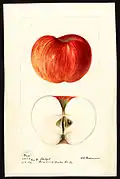 |
Pennsylvania, US | <1875 | Flesh white, crisp, juicy, subacid, good. Tree vigorous, productive. Use November - March. | Eating |
| Higby Sweet(syn. Lady Blush)[3] | 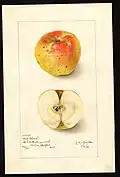 |
US | <1875 | W74, H 62. Stalk 18 mm. Flesh white, tender, juicy, sweet, very good to best. Tree early and good bearer. Use November - January. | Eating |
| High Canons[7] | England | Introduced 1887 | Yellow with red flush. W 76, H 64. FCC from RHS in 1884. Flesh extremely crisp, acid, cooking well. Use till April. | Cooking | |
| Hightop Sweet[197][198] | Plymouth, Massachusetts, USA | >1640 | Frog green-yellow skin with an occasional pink blush. Ribbed. May have some tiny white spots on the skin. | Eating, cooking | |
| High View Pippin[199] | Weybridge, Surrey, England | 1911 | Small to medium sized apple for use November to March. Award of Merit from RHS in 1928. | Eating | |
| Hildesheimer Goldrenette[200] |  |
Lower Saxony, Germany | <1889 | A green apple with red flush. W 74, H 66. Stalk 14 mm. Flesh whitish-yellow, juicy, subacid. Quality: eating good. Pick October. Use December - March. | Eating |
| Himmelstalund[14] |  |
Sweden | <1870 | W 75, H 58. Flesh juicy, aromatic. Use October - November. | Eating |
| Histon Favourite(syn. Chiver's Seedling)[8][201] | Cambridgeshire, England | <1883 | W 77, H 68. Stalk variable. Flesh soft, juicy, sweet. Pick late September. Use October - December. | Eating, Cooking | |
| Hoadley[202] | _(19557967008).jpg.webp) |
US | <1894 | W 91, H 65. Stalk 22 mm. Flesh white, crisp, tender, juicy, subacid, good. Use September- November | Cooking |
| Hoary Morning[8] | Somerset ? England | <1819 | Yellow with red stripes. Flesh, white, dry. Pick mid September. Use October - December. | Cider, Cooking, Eating | |
| Hog Island Sweet[3][28] | 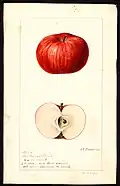 |
N.Y. US | <1857 | Flesh yellow, juicy, crisp, tender, aromatic, very sweet, good to very good. Stalk short. Use September - October. | Eating |
| Holiday[203] | Ohio, US | Introduced 1964 | P Macoun x Jonathan. Pick October 10 (in Ohio). | Eating, Cooking, Baking | |
| Holland Pippin(syn. Summer Pippin, Pie Apple)[4][3][204][205] | 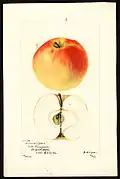 |
Ontario, Canada ? | <1820 | W 77, H 58. Stalk 17 mm. Seeds sometimes imperfect. Flavor not agreeable for eating. Flesh white, crisp, tender, very juicy, subacid, good to very good. One of the very best kitchen apples. Use October - November. | Cooking, Pie |
| Holland Winter[206][207] | ? | ? | A green apple. W 85, H 69. Stalk 12 mm. Tree vigorous. Flesh white, firm, crisp, , juicy, subacid, good. Use December - May. | Eating | |
| Holstein[21] | 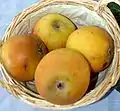 |
Germany | 1918 | An apple with a Cox-like flavour. W 67-73, H 67. Stalk 9–15 mm. Flesh crisp, juicy. Pick late September. Use November - January. | Eating |
| Honeycrisp | 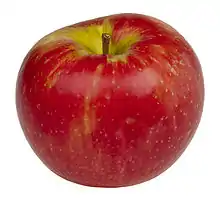 |
Minnesota, US | 1960 | Has excellent eating and keeping qualities. Mottled red and yellow colour. Very crisp white flesh is slightly tart with a strong honey-like sweetness. Quality varies from apple to apple. Developed by the University of Minnesota and best suited to cool climates. P Haralson x Keepsake. | Eating |
| Honeygold | %252C_National_Fruit_Collection_(acc._1976-002).jpg.webp) |
Minnesota, US | 1969 | Sweet tasting fruit. Tree has very showy, light pink blossoms in spring. | Eating |
| Hook[208] | _(19559384279).jpg.webp) |
US | <1880 | A yellow apple. W 91, H 83. Stalk 16 mm. Flesh white, tender, juicy, mild subacid, aromatic, very good. Use October- November. | Eating |
| Hoover(syn. Wattaugah)[3] | 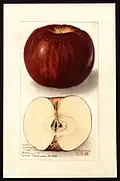 |
South Carolina, US | <1850 | W 79 H 63. Stalk 29 mm. Flesh yellowish, tender, juicy, subacid. Use November- February. | Eating |
| Horace[5] | Ontario, Canada | Selected 1912 | P Langford Beauty x unknown. A medium size highly colored, striped apple. Most nearly resembles Fameuse. Use September - November. | ||
| Hormead Pearmain[50][7] | Hertfordshire, England | <1826 | Medium conical, greenish yellow with ligt brown flush. Flesh crisp, very juicy and pleasant. H 64, W 73. AM from RHS in 1900. Use December - May. | Cooking | |
| Horse(syn. Haas, Yellow Hoss)[3][4] | 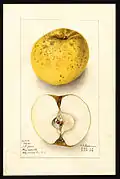 |
North Carolina, US | <1850 | W 81-83, H 71-72. Stalk 21–22 mm. Flesh yellow, tender, pleasant, subacid. Use last of July and first of August. | Cooking, Drying |
| Houblon[8][7] | Berkshire England | <1901 | P Peasgood Nonsuch x Cox Orange. W 71, H 60. Stalk long. Raised by Charles Ross. Award of Merit from RHS in 1901. Pick late September. Use October - January. | Eating | |
| Hounslow Wonder[209] | England | <1910 | Orange-yellow with scarlet flush and stripes. Stalk short. AM from RHS in 1910. Use September - October. | Eating | |
| Howgate Wonder agm[210][21][211] | Isle of Wight, England | 1960 | Makes a lot of juice. W 86, H 72. Flesh creamy-white, firm. P Annie Elizabeth x Peasgood Nonsuch.Pick early October. Use October to March. | Cooking | |
| Hubbard's Pearmain[6] | Norfolk, England | <1800 | One of the richest flavoured dessert apples. Use: November to April. H 57, W 62. | Eating | |
| Hubbardston Nonsuch(syn. John May, Hubbardston, Old Town Pippin)[79][4][28] | 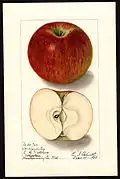 |
Mass. US | <1860 | W 78-86, H 70-77. Stalk 17–28 mm. Flesh yellow juicy. Use October - January. | Eating |
| Humboldt[5] | California, US | Introduced 1944 | P Transcedent x unknown. | ||
| Hunt's Duke of Gloucester[6] | Gloucestershire, England | c1820 | A desert apple of first rate quality, in use from December to February | Eating | |
| Hunt's Early[7][212] | England | ca 1800 | Yellow with brown-red flush. W 64, H 46. P Margaret x Reinette de Hollande.Flesh soft, pale yellow, good. Pick mid August. | Eating | |
| Idagold[5] | Idaho, US | Introduced 1944 | P Esopus Spitzenburg x Wagener. | Eating | |
| Idajon[5] | Idaho, US | Introduced 1949 | P Wagener x Jonathan. Ripens 10 days before Jonathan. | Eating | |
| Idared agm[213][18][21] | 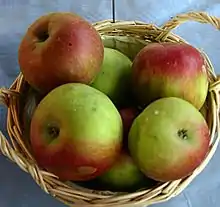 |
Moscow, Idaho, US | Selected 1935, Introduced 1942 | A medium-sized deep red apple. Crisp white flesh is tart and juicy, and can be somewhat bland if eaten out of hand, however, Idared is an exceptional cooking apple. Flesh keeps is shape, and the flavour becomes much stronger with cooking. An excellent keeping apple, Idared remains hardy and durable in proper storage for as long as 8 months. Idared is a cross between Jonathan and Wagener developed at the University of Idaho.W 65-90, H 50-75, We 150-180. Stalk 18-30mm. Prone to canker, scab, very prone to mildew. Pick end of October. Use December - April. | Cooking, Eating |
| Imperatriz[10] | Brazil | Introduced 1997 | P Gala x Mollie's Delicious. Flesh sweet, subacid. | Eating | |
| Improved Blaxtayman 201.[5] | Washington, US | Introduced 1944 | Mutation of Stayman Winesap | ||
| Ingol[144] | 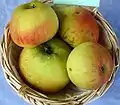 |
Germany | 1954 | A red apple. We 184. Pick late September. Use October - January. | Eating |
| Ingrid Marie[18][14] | .jpg.webp) |
Denmark | 1910 | A medium size (90-180 gram) red apple. W 75, H 55. We 90-180. Stalk 12 – 25 mm. P Cox Orange x Cox Pomona. Picking September. Use November–February. The most popular eating apple in Sweden. | Eating |
| Irish Peach[13][21] | Kilkenny, Ireland | 19th century | Excellent for baking. Early harvest. H 48-55, W 61-65. Stalk 15 mm. More difficult to find within land of origin due to primary use for export to UK. Hardy, tastes very good straight off tree. Pick late August. Use August - September. | Cooking, Eating | |
| Jacobs Sweet[214] | 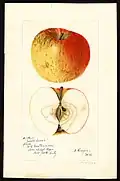 |
Massachusetts, US | ca 1860 | A round yellow apple. Flesh yellow, firm, tender, crisp, juicy, aromatic, very sweet, good. Use October - April. | Eating |
| Jakob Fischer[144] | Germany | 1903 | A yellow apple with red flush. Pick September. Use September - October. | Eating | |
| Jakob Lebel(syn. Jacques Lebel)[18][13] | 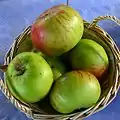 |
Amiens, France | 1825 | A very large apple W 82 - 94, H 63 - 73. We 185. Stalk 10 – 25 mm. Pick September - October. Use October - December. | Cooking |
| James Grieve agm[215][13][18][21] |  |
Edinburgh, Scotland | 1893 | Good taste, but poor keeper (bruises easily). H 60-65, W 70-80. We 140. Stalk 15–33 mm. AM from RHS in 1897. FCC from RHS in 1906. Prone to scab, canker, resistant to mildew. Pick early September. Use September - October. | Cooking, Eating |
| Jaspi[31] | Finland | Introduced 1980 | A red apple. P Lobo x Huvitus. Flesh sweet, subacid, aromatic, good. Pick September. Use September - October. | Eating | |
| Jazz (Scifresh) | 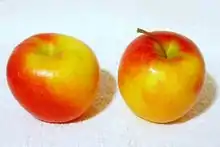 |
New Zealand | 2007 (launched) | Bright red round apple with subtle yellow under-striping. Tart to sweet, dense and very crunchy with effervescent texture. From sweet Royal Gala × firm, tart Braeburn. Widely sold commercially in the UK. | Eating |
| Jefferies[216][4][217][218] | 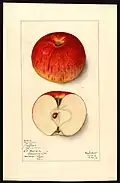 |
Pennsylvania, US | <1849 | W 73, H 53-57. Stalk 16 mm. Flesh yellowish-white, juicy, crisp, tender, subacid, aromatic, very good. Use August - December. | Eating |
| Jersey Sweet[219][4][220][221] | 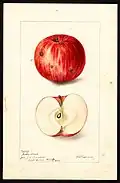 |
US | <1820 | W 72-90, H 67. Stalk 13-17 mm. Flesh yellow, tender, juicy, aromatic, very sweet, good to very good. Use August - October. | Baking |
| Jewett Red[222][223] | 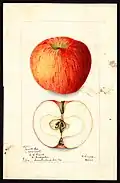 |
New Hampshire, US | <1850 | Yellow with red flush. W 65, H 57. Stalk 10 mm. Flesh yellow, tender, juicy, aromatic, mild subacid, good to very good. Use October - February. | Eating |
| John Standish[8][21] | Berkshire, England | Raised 1873, Introduced 1921. | Yellow-white flat-round apple, 50-75% flushed.W 63, H 54-57. Stalk 15–23 mm. AM from RHS in 1922. Pick mid October. Use December - February. | Eating | |
| Jonagold agm[224][18][10] | 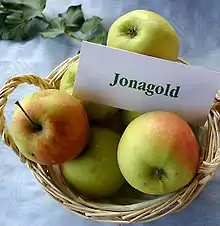 |
Geneva, New York, US | 1968 | P Golden Delicious x Jonathan. Popular in Europe and land of origin. W 60-90, H 60-85. We 150 - 200. Stalk 15 – 35 mm. Several highly coloured strains are available. Widely sold commercially in the United Kingdom. Pick October. Use October - March. | Eating, Cooking |
| Jonamac[10] | Geneva, New York, US | 1972 | P McIntosh x Jonathan. | Eating | |
| Jonared[5] | Washington, US | Discovered 1930. Introduced 1934 | Mutation of Jonathan. | ||
| Jonathan[225][21][13][226] | 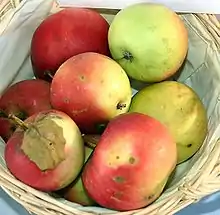 |
New York | 1820s | Tart taste. Mostly red apple with patches of lime green. W 67, H 58-61. We 95 -110. Stalk 8 – 18 mm. Does well in cooler areas; some frost resistance. Pick early October. Use November - April. | Cooking (Pie), Eating |
| Jonagrimes[5] | Indiana, US | Introduced 1920´s. | P unknown. A yellow apple streaked with red. Ripens two weeks ahead of Jonathan. | Eating, Cooking | |
| Jonwin[5] | California, US | Introduced 1944 | P Jonathan x Baldwin. Ripens same as Jonathan. | ||
| Joybells[8] | Surrey, England | 1914 | Pale yellow, 25-75% flushed red. Flesh crisp, juicy and sweet, with pleasant flavour. AGM from RHS in 1922. H 63, W 77. Stalk variable. Pick late September. Use October - March. | Eating | |
| Judson[227] | _(19559330359).jpg.webp) |
Iowa, US | <1899 | Greenish yellow with red flush. W 99, H 85. Stalk 16 mm. Flesh white, firm, crisp, juicy, fair to good. Use October - December. | Eating |
| Julita Gylling[19] |  |
Sweden | ? | Yellow with red flush. W 69, H 61. Stalk 10 – 30 mm. Pick September. Use October - December. | Cooking, Eating |
| B.C. Canada | Introduced 1939 | P McIntosh x Grimes Golden. Flesh cream-colored, firm, crisp, juicy. Matures 3 weeks later than McIntosh. Use until February. | |||
| Junaluska | North Carolina, US | c. 1815 | Once thought to be extinct but rediscovered in 2001 in rural North Carolina. Native American origin. Named for Cherokee chief Junaluska, leader in Battle of Horseshoe Bend, believed to have planted original tree. Extremely russeted and ugly apple but very hardy tree with superior taste to commercial varieties. | Cooking, Cider, Eating | |
| Junami |  |
Switzerland | c. 2010 | A cross between Idared and Maigold with Elstar. Beautifully round, fresh and fruity taste with a crunchy bite. | Cooking, Eating |
| June Wealthy[5] | Ohio, US | Introduced 1947 | P Wealthy x unknown. A dark red apple. Ripens with Yellow Transparent. | ||
| Juno[18] | Germany | W 79, H 62, We 190. Stalk 15 – 22 mm. Flesh, juicy, aromatic, subacid. Pick October. Use January - May. | Eating, Cooking, Juice | ||
| Junost[31] | Russia | 1938 | A yellow apple. P Gulkanel x Transparante Blanche. Flesh juicy, sweet, good. Pick September. | Eating, Cooking | |
| Jupiter agm[228] | 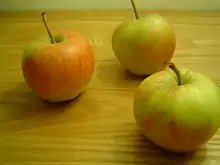 |
North Carolina, US | c. 1815 | A large, round, slightly conic apple. W 64, H 58. Light yellow-green skin with a red-orange blush and stripes. Strong apple flavour is well-balanced between sweet and sharp. Cross of Cox's Orange Pippin and Starking Delicious (a sport of Red Delicious), apple retains Cox's flavour, but tree is easier to grow. | Eating |
| Kaiser Wilhelm[18] |  |
Germany | 1864 | A large apple(170 gram), Harberts Reinette x unknown. Use November–March. | Eating, Cooking |
| Kalemčica[11] | Montenegro | A green apple. Russet in stalk cavity. W 70, H 48, We 76. Stalk short to medium. Flesh cream colored, juicy, sweet. Disease resistant. Pick September. Use September - March. | Eating, Cooking, Cider | ||
| Kalmar Glasäpple[13] | 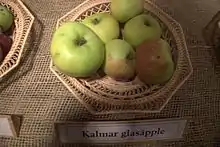 |
Sweden | 18th century[229] | The body is light yellow, and the taste is a mix of acidity and sweetness. H 65, W 78. Stalk 8 - 15mm. Harvesting may begin in early October and it is typically fully ripe in early December. | Cooking, Eating |
| Kalterer Böhmer[230] |  |
South Tyrolean, Austria | <1900 | A yellow apple with red flush (75%). W 70, H 55. Flesh, white, subacid, aromatic, good. Pick October. Use November - February. | Eating, Cooking |
| Kanzi (Nicoter) | 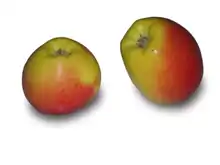 |
Belgium | 1991 | Gala × Braeburn. Crunchy, juicy, sweet, slightly tangier than Gala. | Eating |
| Karapash[11] | Albania | Yellow to green with red stripes. W 60-70, H 60-70, We 110-150. Stalk short to medium. Flesh white, juicy, sweet, subacid, aromatic. Sensitive to apple scab. Pick late October. | Eating | ||
| Kardinal Bea[144] |  |
Germany | 1930 | A German cider apple. Sugar-acid-ratio 15:1. Pick October. Use October - February. | Cider |
| Karmijn de Sonnaville | 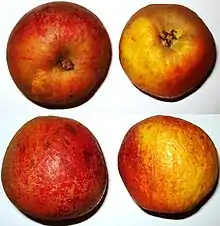 |
Wageningen, Netherlands | 1949 | Yellow ground colour when ripe, with red flush, and russet depending on the season. Large apple, though shape can be irregular. | Cooking (Apple Juice), Eating |
| Katy (apple)(syn. Katja)[21] | .jpg.webp) |
Sweden | 1947 | Early eating apple with red skin and pale cream flesh. W 66, H 60. Stalk 21 mm. Well suited to Northern European climate. Pick early September. Use September - early October. | Eating |
| Kavlås[14][13] |  |
Sweden | <1820 | W 80-87, H 70-79. Stalk 20– 30 mm. Flesh juicy, sweet, subacid, good. Pick early October. Use October - December. | Eating |
| Kendall[5] | Geneva, New York | Introduced 1932 | Large, dark red. P McIntosh x Zusoff | Eating | |
| Kent see Malling Kent | |||||
| Kentucky Long Stem[3] | 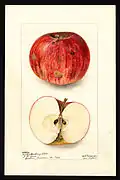 |
Kentucky, US | <1850 | Flesh greenish white, sweet, subacid. Use December - March. | Eating |
| Kerry Pippin[8] | County Antrim, Ireland | c. 1805 | Pale to golden yellow flesh. Delightful spicy taste. Well suited to Ireland's moist, cool climate. W 54, H 54. Stalk short - medium. Pick late August. Use August - September. | Eating | |
| Keswick Codlin (syn. Keswick)[21] [231][232] | _(19738799652).jpg.webp) |
England | Introduced 1790 | A yellow apple. W 74, H 67. Stalk 9 mm. Flesh yellowish white, soft, acid. Pick late August. Use September - October. | Cooking |
| Kidd's Orange Red agm[233] | New Zealand | 1924 | Cox's Orange Pippin × Delicious. Yellow skin with orange red flush. W 67, H 64. Chewy rather than crunchy. | Eating | |
| Kim[14] |  |
Sweden | 1955 | Yellow apple with red overcolour. W 71, H 66. P Cortland x Ingrid Marie. Pick October. Use December - March. | Eating, Cooking |
| King Albert[234] | England | <1936 | Large yellow striped with scarlet. Stalk short. | Cooking | |
| King David[235] | England | <1936 | Yellow with red stripes. P Jonathan x Winesap. Use October - November. | Cooking, Eating | |
| King Georg V[8][236] | Isle of Wight, England | 1898 | P Cox Orange x unknown. W 69, H 60. Stalk variable. AM from RHS in 1927. Flesh white, crisp, juicy, subacid with pineapple flavour. Pick mid October. Use November - March. | Eating | |
| King Harry[7][237] | England | <1892 | Pale yellow with russet. Oval-conical. W 64, H 70. Flesh firm, yellow, good. AM from RHS in 1892. Use October - November. | Cooking | |
| King of the Pippins(syn.Reine des Reinettes or Golden Winter Pearmain)agm[238][18] | .jpg.webp) |
France | <1800 | Suitable for more northerly (southerly in the Southern Hemisphere) areas with higher rainfall. W 67, H 57-6, We 110. Stalk 10 – 20 mm. Pick September - October. Use October - February. | Eating, cooking |
| King of Tomkins County[7](syn. King Apple, Toms Red, Tommy Red)[3][4] | 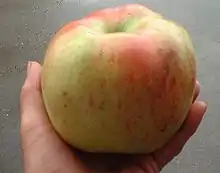 |
N.J. US | W 74-87, H 60-70. Stalk 19–22 mm. Flesh juicy, tender, vinous, aromatic. AM from RHS in 1900. Triploid. Use December - March. | Eating | |
| King Russet agm[239] | United Kingdom | Russetted form of 'King of the Pippins' | Eating | ||
| King's Acre Bountiful[7] | Herefordshire, England | <1904 | Creamy white. W 70, H 57. Stalk short. AM from RHS in 1904. Tree very fertile. Use October - November. | Cooking | |
| King's Acre Pippin[8][21] | England | 1897 | P Sturmer Pippin x Ribston. W 73 - 82, H 67-72. AM from RHS in 1897. Stalk 17 mm. Flesh white, juicy, aromatic. Pick mid October. Use December - March. | Eating | |
| Kingston Black agm[240] | 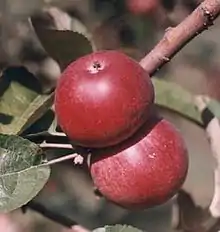 |
Small yellow fruits, heavily flushed with deep red. Does not bear or store well. Fruits November | Cider | ||
| Klockhammarsäpple[14] | Sweden | <1860 | A small yellow apple with red stripes. H 54, W 62. | Eating, Cooking | |
| Knobby Russet (syn. Knobbed Russet; Old Maid's ;Winter Apple)[6] | .jpg.webp) |
Sussex, England | 1819 | Green and yellow, with rough and black russet. Unusually irregular, warty and knobbly surface. In use from December to March. | Cider, Eating |
| Konfetnoje(syn. Konfetnaja)[31] | Russia | ? | A yellow apple with some red stripes. P Papirova x Korobovka. Flesh pear like aroma. Pick mid - late August. | Eating | |
| Konsta[31] | Finland | Introduced 1997 | A red apple. P Lobo x Antonovka. Flesh white, subacid, aromatic. Pick mid October. | Eating, Cooking | |
| Koritschnevoje[31] | Russia | <1850 | A yellow apple with red stripes. Pick September. Use September - October. | Eating | |
| Koritschnevoje Ananásnoje[31] | Russia | <1840 | Medium size round, green with yellow stripes. Pick September, Use September. | Cooking, Eating | |
| Koru | Nelson, South Island, New Zealand | 1998 | Red and yellow, with yellow spots. Usually regular, with smooth surface. This is a "found" cross between Fuji and Braeburn, from a garden where some rotten Fuji apples had been thrown. Said to have balanced tartness & sweetness, said to have flavors of orange, vanilla, honey, & spice (whatever "spice" means). | Cider, Cooking Eating | |
| Kosztela | Poland | 16th century | Eating | ||
| Krstovača[11] | Montenegro | Yellowish green with red flush. W 67, H 68, We 180. Stalk medium. Flesh, firm, sweet, juicy. Disease resistant. Pick October. Use October - April. | Eating, Cooking | ||
| Krupnaja[11] | Montenegro | A greenish-yellow apple. W 74, H 61, We 180. Stalk short to medium. Flesh creamy white, firm, juicy, tasty. Pick early September. Use September - October. | Eating, Cooking | ||
| Kuqula (syn. Mollekuqja)[11] | Albania | A yellow apple with red covering (75%). W 50-60, H 60-65, We 80-100. Flesh yellowish white, subacid, sweet, aromatic. Resistant to Venturia ineaqualis and Codling Moth. Pick early October. A good keeper. | Eating | ||
| Lacker[4] | 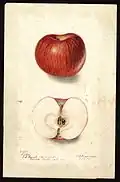 |
Pennsylvania, US | <1800 | Flesh white, juicy, subacid, aromatic. Use January - March | Eating |
| Lady[241][242][243] | 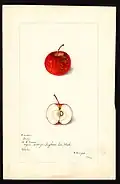 |
France | <1800 | A small apple. W 46, H 33. Stalk 5-6 mm. Flesh white, firm, crisp, tender, juicy, aromatic, mild subacid, good to very good. Use December - May. | Eating |
| Lady Alice |  |
Washington, US | 1979 | Medium-sized, roundish oblate with thin yellow-green skin with an orange blush and bright red stripes. Crisp yellowish-white flesh is sweet with hints of honey and almond. Don Emmons purchased a neglected orchard of Red Delicious near Gleed, Washington, in 1978. While cultivating between trees, a disc from the plow hit the base of a tree. The injury caused a new shoot to grow from the rootstock (likely a seedling grown from a pip). The shoot was allowed to grow and bear fruit which Mr. Emmons named for his mother, Alice.[244] | |
| Lady Henniker[21][7][245] | Thornham Hill, Suffolk, England | 1840-1850 | Large, oblong, ribbed. Flesh: Sweet and spicy, firm, rather coarse textured. H 70, W 73. Use November - January. | Eating, Cooking | |
| Lady's Sweet(syn. Pommeroy, Roa Yon)[3][246][247][248] | 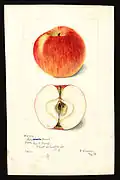 |
US | <1860 | Yellowish-green with red flush. W 80, H 70. Stalk 14-20 mm. Flesh crisp, tender, juicy with a delicious perfumed flavor, very good to best. Use December - May. | Eating |
| Lady Sudely[8][21][7] | 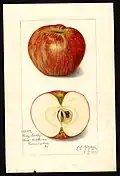 |
Petworth, England | 1849, introduced 1885 | A golden yellow apple with 50-100% red flush. W 67-74, H 57-67. Stalk 5-10mm. Flesh: Creamy white, juicy and subacid. Pick mid August. Use August - September | Eating |
| Lagatorka[11] | Montenegro | Yellow with red stripes (90%). W 74, H 60, We 149. Stalk medium. Flesh very juicy, acid, good. Pick early October. Use October - March. | Eating | ||
| Lakeland[5] | Minnesota, US | Introduced 1950 | A red apple. P Malinda x Unknown. | Eating | |
| Lancaster Greening(syn. Lancaster Pippin)[3] | 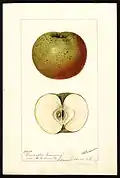 |
Pennsylvania, US | <1870 | A green apple with russet. Flesh yellow, juicy, pleasant, subacid. Use December - May. | Eating |
| Landsberger Reinette[6][18][249] |  |
Gorzow Wielkopolski, Poland | 1840 | An excellent apple for eating or cooking. Use from October to December. W 87, H 78, We 130. Stalk 14 mm. | Cooking, Eating |
| Lane's Prince Albert[7][8][13][18]agm[250][21] | 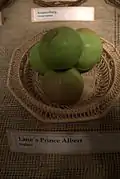 |
Berkhampstead, Hertfordshire, England | 1841, introduced 1857 | Green with orange blush. Makes a good apple crumble for Christmas: peak ripening happens in winter. W 65-85, H 60-70, We 115-200. Stalk 10-20mm. Resistant to scab, very prone to mildew, prone to canker. P Russet Nonpareil x Dumelow's Seedling. Pick early October. Use December - March. | Cooking |
| Langeland[13] | Denmark | <1800 | H 80, W 64. Prone to canker. | Eating | |
| Langley Pippin[50][7] | Chelsea, Buckinghamshire, England | Medium , tall, conical, brightly striped red. Flesh yellowish, soft and well flavoured. P Cox Orange x Gladstone. Use August. | Eating | ||
| Lansingburgh.[4] | 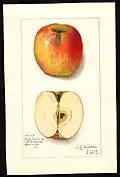 |
Ohio ? US | <1810 | Flesh firm, subacid. Use November - May. | Cooking, Eating |
| Large Bough see see Sweet Bough | |||||
| Late Strawberry(syn. Autumn Strawberry)[3][251][252][253] | 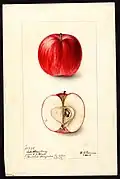 |
Aurora, N.Y. US | <1848 | Whitish with red flush. W 73-79, H 63-69. Stalk 22-24 mm. Flesh, yellow, fine, crisp juicy, vinous, subacid, very good. Use October - December. | Eating |
| Lawver[3][28] | 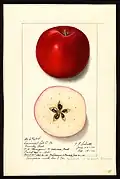 |
Kansas ? US | <1850 | W 61, H 46. Stalk 15 mm. Biennial. Flesh white, firm, crisp, aromatic, subacid. Stalk medium. Use January - May. | Eating |
| Laxton's Advance see Advance | |||||
| Laxton's Early Crimson[50][21] | Bedfordshire, England | Raised 1908. Introduced 1931. | H 51-63, W 51-67. Stalk 17 – 21 mm. A green apple flushed with brownish purple. Flesh very sweet, little acidity. P Worcester Pearmain x Gladstone. Pick Early August. Use August. | Eating | |
| Laxton's Epicure agm[254][21] | Bedfordshire, United Kingdom | 1909 | Aromatic sweet fruit, tendency to biennial habit, bruises easily. H 49-54, W 58-63. Stalk 30–35 mm. Yellow flesh with streaks of red and orange. Pick late August. Use August - September. | Eating | |
| Laxton's Exquisite see Exquisite | |||||
| Laxton's Favourite[50] | Bedfordshire, England | Raised 1925, Introduced 1951. | Sweet crisp, juicy flesh.A yellow apple totally flushed and steaked with orange red. Pick late August. Use September - October. | Eating | |
| Laxton's Fortune see 'Fortune' | |||||
| Laxton's Herald[53] | Bedfordshire, England | 1906 | Yellow skinned flushed almost completely with red stripes. Pick late August. Use September. | Eating | |
| Laxton's Imperial[255] | England | 1926 | Yellow with red flush. P Cox Orange x Allington. | Eating | |
| Laxton's Leader[255] | Bedfordshire, England | 1905 | A small apple. H 46, W 57. P Gladstone x Worcester Pearmain. Pick August. Use August. | Eating | |
| Laxton's Pearmain[255][256] | Bedfordshire, England | 1897 | Cellini x Cox Orange Pippin. H 54, W 67.Raised by Laxton brothers. | Eating | |
| Laxton's Peerless[53] | Bedfordshire, England | 1900 | A large yellow skinned apple with scattered russet. H 72, W 86. Flesh crisp, acid. Pick mid. September. Use September - November. | Eating | |
| Laxton's Pioneer[53] | Bedfordshire, England | 1934 | Large yellow apple almost completely covered with ared flush and stripes. H 67, W 82. Pick late September. Use October - November. | Eating | |
| Laxton's Royalty[257] | Bedfordshire, England | Raised 1908, Introduced 1932. | Yellow with red flush. H 50, W 63. Cox like aroma. Flesh sweet and juicy. P Cox Orange x Court Pendu Plat. | Eating | |
| Laxton's Superb[18] | .jpg.webp) |
Bedfordshire, England | 1897 | P: Cellini × Cox's Orange Pippin. Classic old Victorian, British apple. Green with dull red flush. Firm texture, but not very good juice producer. Prone to scab. Biennial. W 65, H 55, We 105. Stalk 10 – 30 mm. Pick October. Use October - March. | Eating |
| Laxton's Triumph[255] | Bedfordshire, England | Raised 1902. Introduced 1930. | Yellow with red flush. H 48, W 60. P King of the Pippins x Cox Orange. Flesh aromatic, sharp. Pick October. Use November - January. | Eating | |
| Laxton's Victory[53] | Bedfordshire, England | 1926 | A yellow apple with brown flush. H 56, W 64. Flesh sweet and aromatic. Pick early September. Use September - October. | Eating | |
| Lemon Pippin[6] | England or France | <1744 | A medium sized apple. Flesh: firm, crisp, and briskly flavoured. A small tree. | Cooking, Eating | |
| Lewis Incomparable[8] | England | <1800 | Greenish yellow with(25-75%) orange-red flush. W 80, H 73. Stalk short. Flesh greenish-white, dry, subacid. Pick early October. Use December - February. | Cooking, Eating, Pie | |
| Liberty |  |
New York | 1978 | Very disease-resistant. Very similar appearance to McIntosh, relatively short storage life in air. | Eating |
| Limbertwig[4] | 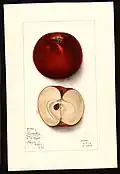 |
US | <1800 | W 78, H 65. Stalk 8 mm. Flesh subacid, rich, aromatic. Use March - April. | Cooking, Eating. |
| Limelight | Kent, England | 2000 | Greensleeves type; abundant cropping and a compact tree. A pale green apple with a smooth finish and occasional pink blush. Crisp flesh and disease resistant tree. | Eating | |
| Linsenhofener Renette[144] | Germany | A green apple with red flush. Flesh juicy, subacid. Pick October. Use November - January. | Cooking | ||
| Liveland Raspberry (syn. Lowland Raspberry)[258] | 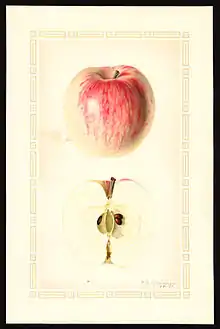 |
Livland Governorate | before 1870 (documented) |
A white apple with red flush. Flesh very tender, sweet. Pick August. | Eating |
| Ljutaĉa (syn. Kiseljaĉa)[11] | Montenegro | A green apple. Russet in stalk cavity. W 69, H 51, We 111. Stalk medium. Flesh creamy green, juicy, subacid. Pick late October. Use December - June. | Eating, Cooking | ||
| Lobo[14] | 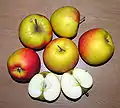 |
Ottawa, Canada | 1897.Selected 1906. Introduced 1930 | A McIntosh-style apple. P McIntosh x unknown. Yellow with red overclour. W 73, H 67. Pick October. Use October - March. | Eating |
| Loddington[8][259] | Kent, England | c1820 | FCC from RHS in 1877. W 89, H 79. Stalk short. Flesh, soft, juicy, subacid. Pick late September. Use October - December. | Cooking | |
| Lodgemore Nonpareil (syn. Clissold's Seedling)[6][7] | Lodgemore, Gloucestershire, England | 1808 | This is a dessert apple of great excellence. Flesh crisp, greenish, sweet, juicy, very good. Use from February to May. | Eating | |
| Lodi[8] | 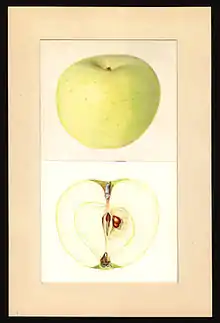 |
Ohio, US | 1911 Itroduced 1924 | Fruit pale yellow flushed with deeper yellow. P Montgomery x Yellow Transparent. H 70, W 70. Resistant to scab. Tangy taste. Use July -August. | Eating |
| London Pippin[34] |  |
England | 1580 | Yellow with red flush. W 74, H 53-55. Stalk 15mm. Pick October. Use January - March. | Cooking, Eating, Cider |
| London Sweet[3] | 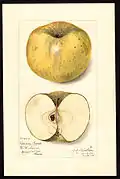 |
Dayton, Ohio, US | <1860 | A yellow apple. Stalk short. Flesh whitish, juicy, tender, sweet, aromatic, good to very good. Tree vigorous, productive. Use November - February. | Eating |
| Longfield,[28] | 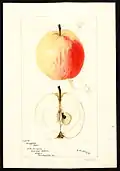 |
Russia | <1870 | W 70-83, H 67-75. Stalk 14-22 mm. Flesh, greenish, crisp, tender, juicy, subacid, aromatic, good to very good.
Use September - October. |
Eating |
| Long Island Russet[3] | 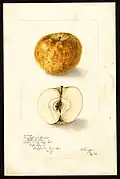 |
Long Island, US | <1820 | Flesh yellowish, dry, sweet. Use October - February | Cider |
| Longstart[92] | England | 1851 | A very excellent culinary apple. H 44, W 51. Stalk 25 mm. Use October - December. | Cooking | |
| Lord Burghley[6][119][21] | England | Raised 1834, Introduced 1865 | Small yellow with brown crimson flush, flesh soft, highly aromatic. W 57-67, H 44-61. Stalk 15 – 20 mm. An excellent winter dessert apple. Tree small. Pick mid October. Use Jan-April. | Eating | |
| Lord Derby[8][21][7][260] | Stockport, Cheshire, England | 1862 | Yellowish green apple. W 83, H 70. Stalk 5 – 6 mm. Strong ribbing. P Forester x Woodford. Flesh pale yellow, subacid. likes cooler weather. Pick late September. Use November - December. Subjet to brown rot. | Cooking | |
| Lord Grosvenor[50][8][21] | England | 1872 | Large conical, pale creamy yellow, cooks to a white froth. Enormous cropper, must be thinned. H 64-82, W 74-88. Stalk 25–28 mm. Pick mid August. Use August - September. | Cooking | |
| Lord Hindlip[8][21][7][261] | Worcestershire, England | <1896 | Late, high-quality dessert apple for use in December to March. W 64-73, H 73-77. Stalk 15 – 20 mm. Flesh crisp, white, juicy, subacid. First Class Certificate from RHS in 1898. Pick early-mid October. Use December - March. | Eating | |
| Lord Kitchener[262] | England | <1900 | A green apple with red flush, smaller than Peasgood Nonsuch. P Peasgood Nonsuch x unknown. | Eating, Cooking, Baking | |
| Lord Lambourne agm[263][21] | 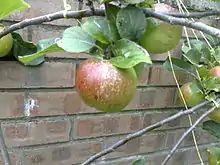 |
England | 1907 | James Grieve apple × Worcester Pearmain. Round shape. Orange flush with hint of russet. W 64, H 51. Stalk 15 – 20 mm. Strong acid flavour. Good for domestic cultivation. Award of Merit from RHS in 1923. Pick late September. Use September - November. | Eating |
| Lord Raglan[92] | England | ? | An excellent cooking apple. Yellow with red flush. Use March - April. | Cooking. | |
| Lord Suffield[8][34][7] | Middleton, Lancashire, England | c.1836 | A very large cooking apple for use in August–September. W 76-83, H 75. Stalk short - medium. Green apple, no flush. This variety is often subject to canker and rotting on the tree. Pick mid August. Use Aug. - Sep. | Cooking | |
| Loudon Pippin[3] | 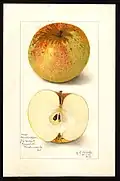 |
Va. US | <1870 | A large oblate apple., yellow with red flush. Stalk short. Flesh yellowish, tender, juicy, subacid, good to very good.. Use December - February. | Eating |
| Lowell[4][264][265] | 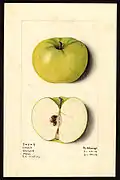 |
US | <1848 | W 83, H 75. Stalk 22 mm. Flesh greenish-yellow, juicy, subacid, aromatic, good to very good. Use August - September. | Eating, Cooking, Drying |
| Lucombe's Seedling[92] | Exeter, England | 1831 | A culinary apple of first rate quality. H 69, W 88. Stalk short and thick. Flesh white, juicy, pleasantly flovoured. Use October - January. | Cooking | |
| Luiken[144] | 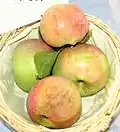 |
Germany or France | <1900 | A yellow apple with red flush. Pick September. Use September - November | Cooking |
| Luisenapfel(syn. Prinzessin Luise)[18] | Canada | 1860 | W 70, H 66, We 110-200. Stalk 15 – 22 mm. Pick October. Use October - January. | Cooking, Eating | |
| Lujanca[11] | Moldova | Yellow with purple to red stripes (90%). Flesh firm juicy, subacid. Biennial. Thinning is necassary. W 62, H 74, We 75-90. Stalk 20 mm. Disease resistant. Pick late September. Use October - December. | Eating, Cooking | ||
| Lundbytorp[72] | Denmark | c1900 | A green apple with red overcolour. H 68, W 74. | Eating | |
| Lunow[18] | Germany | 1920 | Green apple with red flush. H 58, W 70, We 115. Picking October. Use January - April. Biennal | Cooking | |
| Luxemburger Reinette(syn. Reinette des Vergers)[34] |  |
? | <1850 | A green apple with red flush. W 71 H 55. Stalk 12 mm. Use February - July. | Eating, Cooking |
| Maayan[10] | Israel | Introduced 1967 | P (Calville St. Sauver x Damascus) x Delicious. Flesh juicy, sweet, acid. | Eating | |
| Mabbott's Pearmain[92] | Maidstone, England | 1883 | Yellow with red flush. H 56, W 56. Stalk very slender. Flesh juicy, sweet , highly flavoured. Use October - December. | Eating | |
| Maclean's Favourite[92] | Colchester, England | 1820 | A very excellent dessert apple. H 49, W 62. Pick early October. Use October - January. | ||
| Macoun[18] | 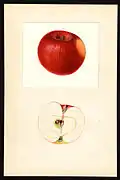 |
Geneva, New York | 1909/1923 | Cold-tolerant. Crunchy. P McIntosh x Jersey Black. Does very well in salads. W 71, H61, We 100-160. Stalk 10-15mm | Eating |
| Madresfield Court[8] | England | <1915 | AM from RHS in 1915. Tree is a shy cropper. W 80, H 81. Stalk medium. Flesh greenish-white, juicy, sweet, aromatic. Pick late September. Use October - December. | Eating | |
| Maglemer[13] | .jpg.webp) |
Lolland, Denmark | <1800 | Yellow with red stripes. W 62, H 58. Pick late September. Use November - January. | Eating |
| Magog[28] | 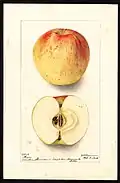 |
Vermont US | <1876 | W 80, H 75. Stalk 19 mm. Flesh firm, juicy, aromatic, subacid, good. Use October - January. | Eating |
| Maiden's Blush[59][28][266][267] | 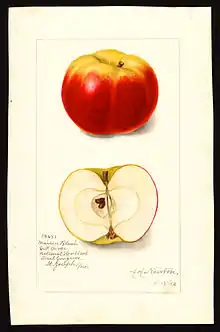 |
Burlington, New Jersey, US | <1817 | W 86, H 69. Stalk 19 mm. A thin-skinned, flattened apple. Pale yellow-green skin has a telltale crimson blush on the side that faced the sun. Flesh white, crisp, very juicy, subacid, good. Susceptible to scab. Heavy annual bearer. Good cooker. Excellent variety for drying because the flesh remains white and bright. Use September - November. | Cooking, (Eating) |
| Maidstone Favourite[50][7] | Kent, England | <1913 | Flat, even, most delightfully striped with carmine. P Alexander x Beauty of Bath. Flesh crisp, sweet and aromatic. H 48, W 54. AGM from RHS in 1913. | Eating | |
| Maikki[31] | Finland | Introduced 1980 | A red apple. P Melba x Huvitus. Flesh white, sweet, subacid, aromatic. Pick late August. | Eating | |
| Make[31] | Finland | Introduced 1980 | A yellow apple with red flush. Flesh juicy, sweet, subacid. P Atlas x Gul Höstkalville. Pick mid September. | Eating | |
| Malinda | 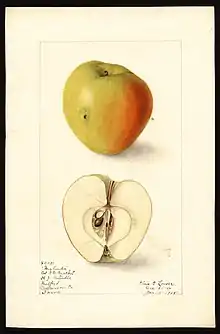 |
Vermont, US | 1860 | Small, conical with sheep's nose; deep, rich yellow with red spots possible. Dry, dense, substantive flesh; mild, pear-like flavour. Tree good in climates with heavy snowfall. | Cooking, Eating |
| Malling Kent[21] | Kent, England | Raised 1949, Introduced 1974 | Parentage Cox's Orange x Jonathan. Size H 58-67, W 64-67. Good keeping properties. | Eating | |
| Malmbergs Gylling[14] |  |
Sweden | <1900 | W 75, H 58. Stalk short to medium. Flesh juicy, subacid, fair to good. Pick September. Use October - November. | Cooking |
| Mangum[4] | 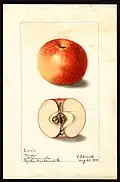 |
Southern US | <1850 | Flesh yellow, tender, juicy, subacid. Use October - November. | Eating |
| Manitoba[5] | Manitoba, Canada | Introduced 1931 | A yellow apple. P Duchess of Oldenburg x unknown. Flesh white, crisp, juicy, sicy flavor, subacid. Use November - February. | Eating | |
| Manitoba Spy[5] | Manitoba, Canada | Introduced 1931 | Large red. P Patten Greening x unknown. Use November - February | Cooking | |
| Manks Codlin[13] | 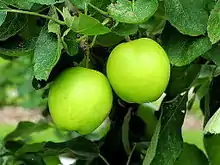 |
Isle of Man | 1815 (First fruited) | Pale yellow medium-sized fruit with occasional flush of red. H 50, W 55. Stalk 15 mm. Hardy. Heavy producing. Use November - December. | Cooking |
| Mann[28] | 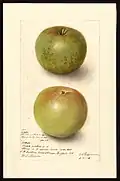 |
New York, US | <1872 | W 84, H 65. Stalk 19 mm. Biennial. Flesh yellowish, juicy, crisp, subacid, fair to good. Use December - April. | Eating |
| Mannington's Pearmain[119] | Sussex, England | 1770 | Flesh yellow soft juicy. Old dessert apple, of no great merit. W 67-69 H 58-66. Stem long. Pick early October. Use November - March. | Eating, Cooking | |
| Mantet[14] |  |
Manitoba, Canada | Selected 1928. Introduced 1929 | Yellow apple with orange overcolour. P Tetofsky x unknown. H 75, W 75. Pick August. Use August. Does not do well in warm climates. | Eating |
| Margaret Pratt[5] | Ontario, Canada | Introduced 1938 | Resembles Red Astrakan. P unknown. | Cooking | |
| Margil[21] | 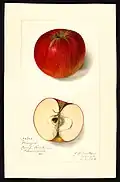 |
London ? | 1750s | Highly flavoured apple held in very high esteem by connoisseurs. H 51-60 W 54-66. Stalk 13 – 18 mm. Slightly conical in shape, dull green skin with an orange-red blush, some russeting. The yellow flesh is firm, crisp, sugary, and as pomologist Robert Hogg said, "with a powerful and delicious aromatic flavour." The very small tree is weak and slender and bears light crops. Because it flowers early, it is susceptible to frost damage. Pick October. It keeps well. Introduced to Brompton Park Nursery from Versailles by Henry Wise in the early 18th century. Pick early October. Use October - January. | Eating |
| Martin 1.(syn. McLellan)[3][268] | 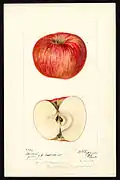 |
Conn. US | <1870 | Yellow with red flush. W 73, H 56. Stalk 6-16 mm. Biennial. Flesh, white, juicy, vinous, sweet, very good. Use December - March. | Eating |
| Martin 2.[5] | Louisiana | Introduced 1943 | Yellow with red flush. P unknown | Eating | |
| Mattamusket[3] | 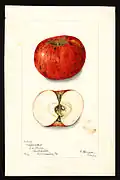 |
North Carolina US | <1870 | Flesh whitish yellow, crisp, subacid, good. Tree vigorous, productive. Use December - March. | Eating |
| Mauss Reinette(syn. Love Beauty, Reinette de Multhaupt, Svanetorpsäpple)[13] | 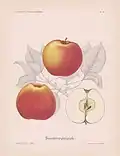 |
Germany | <1874 | A yellow apple with red flush. W 62, H 52. Flesh juicy, subacid. Pick October. Use November - December. | Eating |
| May Queen[50][7] | .jpg.webp) |
Worcester, England | 1800s | Large, oblate, often russetted yellow apple with bright red blush and stripes. Crisp, greenish-yellow flesh, rich, nutty flavour. Similar texture to Ribston Pippin, and in a good year, its equal in flavour. In bad years it can be rather dry and harsh. Excellent keeper. Heavy annual bearer. AGM from RHS in 1892 H 51, W 62. Use January - May. | Eating |
| McAfee(syn. McAfee Nonsuch, McAfee Red)[3] | 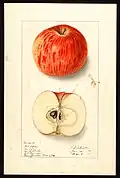 |
Kentucky, US | <1870 | Once thought to be gone forever, rediscovered in 2018 in Idaho.[269] Flesh whitish, crisp, subacid, good to very good. Stalk short. Tree very prolific and will produce huge crops of apples when mature. Use December - March. | Eating |
| McIntosh[161][270][271] | 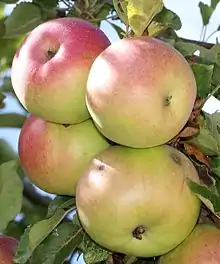 |
Ontario, Canada | 1811 | A popular, cold-tolerant eating apple in North America. W 73-88, H 67. Stalk 15 mm. Flesh white, very tender, juicy, subacid, aromatic, very good. Use October - December. | Cooking (applesauce), Eating, Pies |
| Mc Intosh Rogers(syn. Red McIntosh)[144][21] | New York, US | 1930. Introduced 1932 | A red mutant of McIntosh. W 70, H 67. Stalk 10 – 20 mm. Pick mid September. Use October - December. | Cooking, Eating. | |
| McLellan see Martin 1. | |||||
| Mc Mahon[28] | 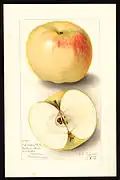 |
Wis. US | c1860 | W 94, H 76,. Stalk 29 mm. Flesh white, tender, juicy, subacid, fair to good. Use October - January. | Eating |
| Mecklemburger Königsapfel(syn. Roter Brasil)[13] | 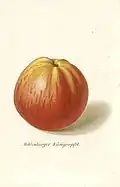 |
Germany | 1773 | W 65 H 60. Pick October. Use December - March | Cooking, Eating |
| Medina[5] | 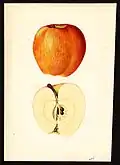 |
Geneva, New York | Introduced 1922 | P Deacon Jones x Delicious. | Eating |
| Mela Carlo(syn. Mela Carla, Male Carle)[6] | Italy | <1817 | A dessert apple of the most exquisite flavour. H 68, W 68. Flesh is as melting as that of the Doyenné pear. Pick October. Use December - March. | Eating | |
| Melba[14] | 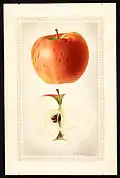 |
Ottawa, Canada | Raised 1898, Introduced 1909 | Green apple with red overcolour. W 73, H 61. | Eating |
| Melon American[6][28] | .jpg.webp) |
Connecticut | 1800 | A first rate dessert apple. W 68-86, H 61-70. Stalk 18–39 mm. Flesh juicy, sweet and vinous. Use December. | Eating |
| Melon German(syn. Melonenapfel, Flaschapfel, Nonnetitte, Prinzenapfel, Pomme de Prince)[13] | 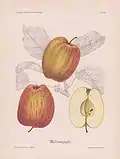 |
Germany | <1788 | An oblong apple. Flesh subacid with a pleasant aroma. W 69, H 79. Stalk 12–25 mm. Pick October. Use December - March. | Eating |
| Melrose 1. (syn. White Melrose)[6] | Scotland | <1800 | H 76, W 82. Flesh marrow like, with a sweet and sub-acid flavour. Use October - January. | Eating, Cooking | |
| Melrose 2.[5][10] | 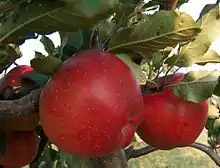 |
Ohio, US | Selected 1937. Introduced 1944 | P Jonathan x Delicious. Flavour improves in storage. Coarse flesh. Biennial. Pick October. Use December - April. | Eating |
| Mere de Menage (syn. Bellefleur de France)[13][21] | 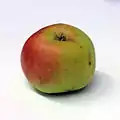 |
France or Ukraine | <1800 | Large flat-round apple. H 67, W 77-86. Stalk: Very stout(4-5mm) and short(10-15mm). | Cooking |
| Merton Beauty[21] | England | 1932, Introduced 1962 | W 56-63, H 45-51. Stalk 20–27 mm. P Ellisons Orange x Cox Orange. A greenish-yellow apple flushed with red. Pick early September. Use September - October. | Eating | |
| Merton Charm[8][21] | Surrey, England | Released 1962 | H 47-51, W 57. Stalk 10 – 15 mm. P McIntosh x Cox Orange. AM from RHS in 1960. Pick September. Semi-weeping habit, heavy crops of small fruit unless thinned. Pick mid September. Use September - October. | Eating | |
| Merton Delight[272] | England | Introduced 1953 | P Cox Orange x Golden Russet. Flesh, tender, crisp sweet to subacid. | Eating | |
| Merton Joy[272] | England | 1946 | W 63, H 51. P (Cox Orange x Sturmer Pippin) x Cox Orange. Flesh soft, sweet, aromatic. | Eating | |
| Merton Knave[21][272] | England | 1948 | Greenish yellow with red flush. P Laxton's Early Crimson x Epicure. W 55 - 70, H 48-62. Stalk 12 – 30 mm. Flesh faily juicy with strong aroma. Pick mid September. Use September. | Eating | |
| Merton Pippin[272] | England | Introduced 1948 | A large apple. P Cox Orange x Sturmer Pippin. Flesh subacid. | Eating | |
| Merton Profilic[272] | England | 1914 | W 61, H 50. Flesh sweet, subacid. P Northern Greening x Cox Orange. | Eating | |
| Merton Russet[272] | England | 1921 | W 57, H 54. P Sturmer Pippin x Cox Orange. Flesh sweet, subacid. | Eating | |
| Merton Worcester[21] | England | 1956 | W 58, H 55. Stalk 12 – 20 mm. P Cox's Orange Pippin × Worcester Pearmain. AM from RHS in 1950. Developed at John Innes Institute. Pick early September. Use September - October. | Eating | |
| Metzger[5] | Seattle, Washington | Selected 1938. Introduced 1948 | P Delicious x Unknown. Pick early August. | Eating | |
| Mexico[4] |  |
Connecticut, US | <1850 | Round medium size apple. Crimson red. Stalk long to medium. Flesh white, juicy, subacid. Use August - September. | Eating |
| Michaelmas Red[8] | England | 1929 | W 64, H 56. P McIntosh x Worcester Pearmain. Flesh soft, juicy, sweet, vinous. Pick mid September. Use October - December. | Eating | |
| Michal[10] | Israel | Introduced 1967 | P (Calville St. Sauveur x Damascus) x Delicious. Flesh juicy, sweet, subacid. Tree productive. | Eating | |
| Middle Green[7] | England | <1903 | Yellow streaked with red. W 63, H 51. AM from RHS in 1903. Flesh, soft, yellowish, sweet, good. Use December - February. | Eating | |
| Milam[4] | 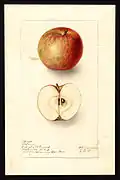 |
US | <1820 | W 69, H 62. Stalk 20 mm. Flesh white, tender, crisp, juicy, subacid or sweet. Use December - January. | Eating |
| Miller's Seedling[8][21] | Berkshire, England | 1848 | Sweet apple. H 44-54, W 60-63. Stalk 18–26 mm. Flesh white, juicy, sweet. AM from RHS in 1906. Pick mid August. Use August - September. Tree prefers chalky soils. | Eating | |
| Millicent Barnes[8] |  |
Chester, England | 1903 | A yellow apple flushed with red. W 69, H 63. Flesh lacks flavour. Pick mid September. Use October - December. | |
| Milton[5] | 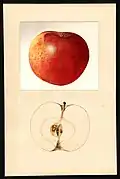 |
Geneva, New York | Introduced 1923 | P Yellow Transparent x McIntosh. | Eating |
| Milwaukee[28] | 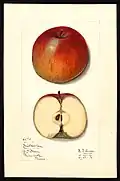 |
Wis. US | <1899 | W 80, H 65. Stalk 18 mm. Flesh whitish, firm, crisp, tender, juicy, subacid, fair to good. Use October - January. | Cooking |
| Minister[4] | 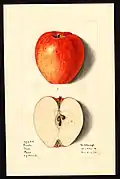 |
New England, US | <1850 | Tree healthy, vigorous, early bearer. Flesh, yellowish, juicy, acid. Use September - October. | Cooking |
| Mio[14] | 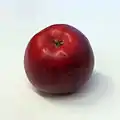 |
Sweden | 1932 | Yellow with red flush. W 62, H 53. P Worcester pearmain x Oranie. Pick September. Use September - October. | Eating |
| Miss Baron[7] | England | <1885 | A golden-yellow apple. Tree vigorous. Flesh yellow, tender, subacid. Use October - January. | Cooking | |
| Missouri Pippin[273][274] | 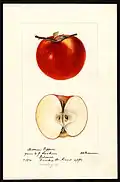 |
Missouri, US | ca 1840 | Tree vigorous. Flesh yellow, firm, brisk, subacid, fair to good. Use October - January. | Eating |
| Miss Phillimore[255][7] | England | Introduced 1900 | Yellow with red flush. P Gladstone x Lord Burghley. Flesh tender, sweet. AM from RHS in 1899. Use October. | Eating | |
| Mollie's Delicious[10] | New Jersey, US | 1966 | Conical shape, pinkish red colour. P (Golden Delicious x Edgewood) x (Gravenstein x Close). Flesh crisp, sweet, good. Lasts long in refrigeration. Good aftertaste. | Eating | |
| Monarch[21][7] | Essex, England | Raised 1888, Introduced 1918 | Large round-conical apple. Flesh: Coarse-textured, juicy, tender sharp. Biennial tendency. H 58-70, W 73-80. Pick mid September. Use November - January. | Cooking | |
| Monmouth[28] | 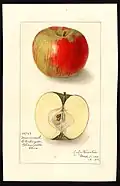 |
N.J. US | <1848 | W 78-85, H 65-68. Stalk 13–19 mm. Biennial. Flesh yellowish, firm, grisp, tender, juicy, aromatic, good to very good. Use December - March. | Eating |
| Monroe[5] | Geneva New York | Introduced 1949 | A red apple. P Jonathan x Rome Beauty. | Eating | |
| Moore Extra[3] | 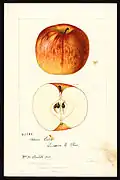 |
Ohio, US | <1870 | Flesh yellow, juicy, tender, subacid, very good. Stalk short. Tree vigorous, not an early bearer. Use December - March. | Eating. |
| Moore's Sweeting see Black Sweet | |||||
| Morden 347[5] | Manitoba, Canada | Introduced 1941 | P Martha x Dolgo. Flesh orange-yellow, firm, crisp, juicy. Tree hardy, vigorous. Pick late August. | Eating, Cooking | |
| Morden 352[5] | Manitoba Canada | Introduced 1945 | P Dolgo x Haralson. Flesh white, firm, crisp, juicy, sweet, subacid. Tree very hardy. Pick late September. | Eating, Cooking | |
| Mother (American Mother) [275]agm[276][21][28][277][278][279] | 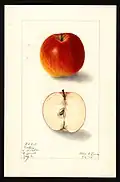 |
Massachusetts, US | 1840 | Medium-sized yellow apple with crimson stripes and darker red blush.H 60-80, W 63-77. Stalk 13 – 23 mm. Flesh fine, tender, juicy, mild subacid, aromatic, very good to best. The fruit has a balsamic aroma with a suggestion of vanilla. Cropping can be a bit irregular, if not completely biennial. A late flowering variety that avoids frost. Some resistance to scab. . Pick late September. Use October - December. | Eating |
| Munson(syn. Meachem Sweet, Rag Apple)[28] | 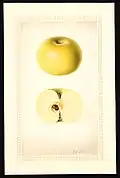 |
Massachusetts ? US | <1849 | W 68, H 55. Stalk 14 mm. Flesh yellowish, tender, juicy, sweet, good to very good. Use late September - December. | Eating |
| Munson Sweet(syn. Orange Sweet, Ray Apple, Meachem Sweet)[4] | 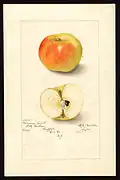 |
New England, US | <1850 | W 74, H 59. Stalk 18 mm. Tree vigorous, productive, a regular bearer. Flesh juicy, very sweet. Use September - February. | Baking |
| Murray[144] | Canada | 1980 | |||
| Muscadet de Dieppe | Normandy, France | c. 1750 | Commonly used in making Calvados brandy. Yellowish green apple with red striping or reddish pink blush. Too tart to eat. | Cider | |
| Musch[144] | Belgium | 1872 | Pick September. Use November - December. | Eating | |
| Musk see Carlisle Codlin | |||||
| Muster[4] | 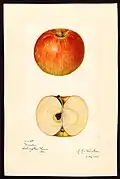 |
Indianapolis, US | <1850 | Flesh yellow, juicy, subacid, aromatic. Use November - January. | Cooking, Eating |
| Mutsu[21] |  |
Aomori Prefecture, Japan | 1930 | Known as "Crispin" in the United Kingdom. W 73-77, H 70-73. Stalk 22–30 mm. P Golden Delicious × Indo. Pick mid October. Use December - February. | Eating |
| My Jewel | Watsonville, California | c. 1940[280] | Originated as a chance seedling, a cross between Winter Banana and Golden Delicious.[281] Yellow colour. October harvest. Still used in cider blends by Martinelli's)[282] | Eating, Cooking, Cider | |
| Nanny[6][7] | Surrey or Sussex, England | 1842 | A dessert apple of excellent quality. Flesh greenish yellow, tender. H 69, W 76. Pick September. Use October. | Eating | |
| Nathusius Taubenapfel[34] | 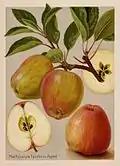 |
Germany | 1824 | A conical apple. W 67, H 62. Stalk 11 mm. Use December - April | Eating |
| Nelson Codlin[6] | England | <1850 | Large yellow. A first rate culinary apple. Use September - January. | Cooking | |
| Newell-Kimzey (Airlie Red Flesh) | Airlie, Oregon | 1961 | A medium to medium -large, conic apple. Light yellow-green skin with white dots, occasionally with red-orange blush on one side.Light pink to deep red flesh is crisp, sweet and moderately tart. | Eating, pies | |
| Newfane[5] | 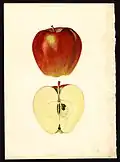 |
Geneva, New York, US | Introduced 1927 | P Deacon Jones x Delicious. Flesh, tender, juicy. Ripens with Delicious. | Eating |
| Newton Wonder[8][21] | 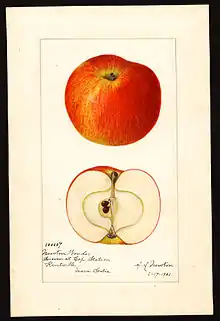 |
Derbyshire, England | <1887 | A yellow apple flushed with red. FCC from RHS in 1887. W 89-92, H 70-73. Stalk 10–15 mm. Medium round and even, beautifully striped and flushed. Very good cooker. Cooks to juicy, brisk, well-flavoured purée, but with less acidity than Bramley. Prolific bearer, can be harvested in winter. Pick mid October. Use November - March. | Cooking. |
| Newtown Delicious[5] | Washington, US | Introduced c1937 | P Yellow Newtown x Delicious. Tree vigorous, heavy bearer. | Cooking (Eating) | |
| Newtown Pippin (Albemarle Pippin)[283][8][284][285] | 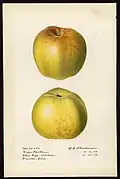 |
Queens County, New York | 1759 | Best known colonial apple in North America. Known favourite of Ben Franklin and Thomas Jefferson. Medium to large, often irregularly shaped apple. Greenish-yellow, dotted, often russeted. W 78 H 60-65. Stalk 15 mm. Tough skin, flesh cream to greenish-white, very quickly browning. Flesh yellow, firm, crisp, moderately fine-grained, aromatic, subacid, best. Biennial habit, slow to come into bearing. Good keeper, improves with storage. Prized for its clear juice in cider making. Two sports, Green Newtown Pippin and Yellow Newtown Pippin, differ only in skin colour. Pick late October. Use November - March. | Cooking, Eating, Cider |
| Newtown Spitzenburgh[3][286][287] | 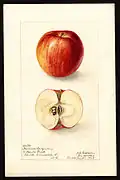 |
Newtown, Long Island, US | 1817 | W77, H 59. Stalk 17 mm. Flesh yellow, crisp, tender, vinous, subacid. Use October - February. | Eating |
| Nickajack(syn. Caroline, Berry, Aberdeen, Trenham, Alleghany, Chaltram Pippin)[3][288][289] | 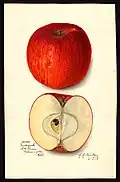 |
North Carolina, United States | c. 1810 | Native American origin, believed to be originally grown by Cherokee along banks of Nickajack Creek. Only grown in Appalachians, favourite of later settlers for desserts. Rusty red colour with sweet, crisp taste. W 84, H 67. Stalk 12 mm. Use December - April. | Cooking, Eating |
| Nonpareil[8][21] | France | 1500s | A yellowish green apple. W 58-65, H 48-52. Stalk 18–28 mm. Pick mid October. Use December - March. | Eating | |
| Nordhausen(syn. Schöner von Nordhausen)[18] |  |
Germany | 1892 | W 69, H 57, We 130. Stalk 6 – 13 mm. Pick October. Use January - April. | Cooking |
| Norfolk Beauty[21][7][290] | Norfolk, England | introduced 1902 | Pale cream in colour when cooked. W 80-87, H 67-71. Stalk 8 – 10 mm. P Harvey x Hawthornden. FCC from RHS in 1902. Pick early September. Use October - December. | Cooking | |
| Norfolk Beefing(syn. Catshead Beaufin, Taliesin)[6][7][291] | Norfolk, England | ca 1800 | H 63 W 78. Stalk short. Flesh with a brisk and pleasant flavour. Pick October. Use January - June. | Baking | |
| Norfolk Pippin see Adams Pearmain | |||||
| Norfolk Royal[21] | England | 1908 | A truncate conical apple. Flesh crisp, juicy and well-flavoured. H 67, W 70. Stalk 8 – 15 mm. Pick late September. Use September - February. | Eating | |
| Norman's Pippin[50] | Belgium | <1900 | Conical grey green with russet, flesh mellow, of fine flavour. AGM from RHS in 1900. H 51, W 63. Use Jan. - March. | Eating | |
| Northern Greening[50][7] | Yorkshire, England | 1826 | Medium, oval, conical, pea green to pale yellow, with red stripes and faint brown flush. Flesh tender, greenish, acid. Growth vigorous. Pick mid October. Use December - April. | Cooking | |
| Northern Spy[292][8][293][294] | 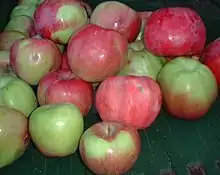 |
New York | c. 1800 | Tart, firm, stores very well. Tree large, vigorous. Flesh yellow firm, tender, crisp, juicy, aromatic, subacid, very good to best. Noted for being excellent choice for making American-style apple pie. W 81, H 72. Stalk 20 mm. Sometimes used as a rootstock. Pick mid October. Use November - March. | Cider, Cooking, Eating |
| North Western Greening[28][295] | 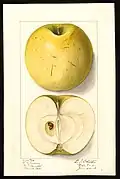 |
Wisconsin, US | <1872 | W 86, H 79. Stalk 15mm. Biennial. Flesh yellowish, crisp, firm, juicy, subacid, fair to good. Use January - April. | Cooking (Eating) |
| Nova Easygro | Canada | 1975 | |||
| Nu-Jon[5] | Washington, US | Introduced 1949 | P unknown. A large red striped apple. | ||
| Nutmeg Pippin[8] | England, UK | 1920 | A conical apple W 54, H 50. Flesh juicy, nutty flavour. Pick late September. Use December - March. | Eating | |
| Nyack[4] | 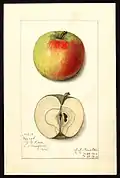 |
New York, US | <1850 | Flesh white, juicy, acid, rich. Use December. | Eating |
| Oakland[28] | 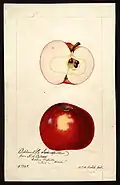 |
Michigan, US | <1883 | W 72, H 58. Stalk 22 mm. Biennial. Flesh white, tender, juicy, sweet, crisp, good. Use November - February. | Eating |
| Oberdieck's Taubenapfel[34] | 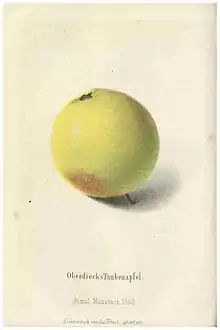 |
Germany | <1860 | A conical apple. W 57, H 60. Stalk 12 mm. Use December -February. | Eating |
| Ogden[5] | Geneva, New York, US | Introduced 1928 | P Zusoff x McIntosh. Flesh white, aromatic, sweet. | Baking | |
| Ohio Nonpareil[4] | 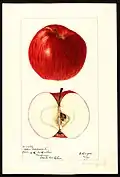 |
Ohio, US | <1853 | W 95, H 73. Stalk 10 mm. Flesh yellow, juicy, subacid. Tree vigorous, healthy. Use September - December. | Cooking, Eating, Drying |
| Ohio Pippin[4] | 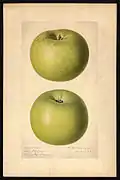 |
Ohio, US | <1867 | W 99, H 74. Stalk 13 mm. Tree healthy, vigorous. Flesh Yellowish, tender, juicy, acid to subacid. Use December - January. | Cooking |
| Oldenburg[144] |  |
Germany | 1897 | A yellow - green apple with red flush. Pick September. Use October - December. | Eating |
| Oldenburg 2 see Duchess of Oldenburg | |||||
| Oliver[28] | 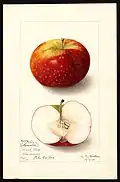 |
Arkansas | <1873 | W 69, H 57. Stalk 10 mm. Flesh whitish, crisp, tender, juicy, subacid, swee, good to very good.
Use December - March. |
Eating |
| Ontario[18][8][144][7][296][297] |  |
New York, US | 1874 | A large apple W 75 H 58. We 191. greenish-yellow with purple flush. P Wagener x Northern Spy. High in Vitamin C. Pick mid October. Use November - April. | Eating |
| Opal |  |
Czech Republic | 1999 | Firm, fine to medium grained, medium juicy, full flavoured, sweet, mild-subacid. Golden Delicious × Topaz.[298] | Eating |
| Opalescent[28][299] | 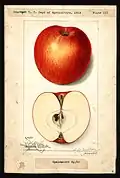 |
Ohio, US | <1899 | W 98, H 92. Stalk 20 mm. Flesh juicy, subacid, aromatic, good to very good. Use November - February. | Eating |
| Orin | .jpg.webp) |
Fukushima, Japan | 1952 | Sweet and distinctive fragrance. Notes of pineapple. Medium hardness. Golden Delicious × Indo. | Eating |
| Oriole[5] | Minnesota, US | Introduced 1949 | P unknown. Flesh tender, juicy, aromatic, subacid. | Cooking, Eating | |
| Orleans[5] | 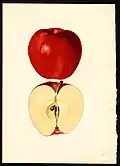 |
Geneva, New York, US | Introduced 1924 | P Deacon Jones x Delicious. | |
| Orleans Reinette(syn. Golden Reinette)[21] |  |
Orleans, France | <1776 | Medium flat, rich red and golden russet. Triploid. Reliable bearer. W 62, H 58. Stalk 6–20 mm. Extraordinary complex flavour, similar to Blenheim Orange, but not related. Pick mid October. Use Dec. - Feb. | Eating |
| Ortley(syn. White Bellflower, Cleopatra)[4][8][300] | 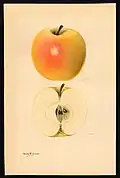 |
New Jersey, US | <1850 | A large yellow apple with red flush. W 71, H 70. Flesh yellowish, crisp, tender, juicy, acid to subacid, very good. Tree vigorous, very productive. Pick late October. Use November - January. | Cooking, Eating |
| Osceola[4] | 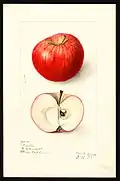 |
Indiana, US | <1850 | W 84, H 72. Stalk 13 mm. Flesh, yellow, juicy, subacid. Use January - March. | Eating |
| Oskaloosa(syn. Jack, Apple)[3] | 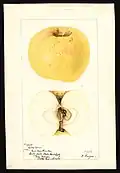 |
Iowa, US | <1850 | Flesh juicy, subacid. Tree moderate grower, early but not an abundant bearer. Use November. | |
| Owen Thomas[53][21] | Bedfordshire, England | 1897 Introduced 1920 | H 51, W 57-63. Stalk 7 – 15 mm. Green wit orange flush. P Cox Orange x Gladstone. Pick mid August. Use late August - early September. | Eating | |
| Ozark Gold | Missouri, US | 1970 | Light green with pink blush. Has taste with notes of honey. | Eating | |
| Pacific Rose |  |
New Zealand | 1995 | Extremely crisp, sweet apple. Also grows well in California. | Eating |
| Pam's Delight | Bedfordshire, England | 1958 | A medium-sized apple with a red blush. Flesh is crisp, juicy and sweet-tasting.[301] | Eating | |
| Paragon[302] | 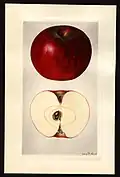 |
Tennessee, US | ca 1830 | Tree vigorous. Flesh yellow, firm, tender, juicy, aromatic, mild subacid, good to very good. | |
| Park(syn. Park Spice, Park Apple)[3] | 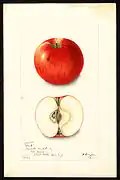 |
N.Y. US | <1870 | Flesh yellowish, firm, juicy, subacid, aromatic, very good. Stalk short. Tree very productive. Use December - March. | Eating |
| Paroquet[7] | Berkshire, England | <1899 | A red apple with russet. W 64, H 57. Stalk short. AM from RHS in 1899. Flesh yellowish, tender, fair. Use October - January. | Eating, Cooking | |
| Parry White[28][303] | 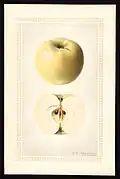 |
Pennsylvania ? US | <1872 | W 59-71, H 62. Stalk 18 mm. Flesh white, tender, juicy, subacid, good. Use late August - October. | Eating |
| Patten[28] | 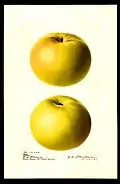 |
Wis. US | <1869 | W 85, H 70. Stalk 10-17 mm. Flesh tender, juicy, subacid, good. Use October - January. | Cooking |
| Patricia[5] | 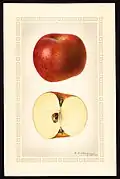 |
Ontario, Canada | Selected 1920 | P McIntosh x unknown. Tree heavy bearer. | Eating |
| Paula Red | 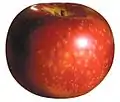 |
Kent County, Michigan, US | 1960s | Firm white flesh; McIntosh mutation. | Eating |
| Pawpaw(syn. Western Baldwin, Rubicon, Ball Apple)[3] | 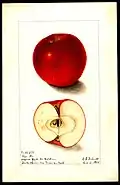 |
Michigan, US | <1875 | Flesh yellowish, juicy, firm, brisk, subacid, very good. Stalk medium. Tree hardy, a regular bearer. Use December - June. | Eating |
| Payette[5] | Idaho | Selected 1936. Introduced 1944. | A red apple. P Ben Davis x Wagener. | Eating | |
| Peacemaker[50] | Berkshire, England | <1913 | Round and smooth, with crimson flush and stripings. Resembles Charles Ross in general charasteristics. AGM from RHS in 1913. H 57, W 69. | Eating | |
| Peach-Pound Sweet[3] | N.Y. US | <1875 | W 72, H 54. Stalk 16 mm. Flesh juicy, sweet. Very good. Use September - November. | Eating | |
| Pearl[8] | Essex, England | 1983 | Yellow apple flushed with red on 50%. W 68, H 64. Pick late September - early October. Use October - November. | Eating | |
| Pease(syn. Walter Pease, Pease Walter)[28] | 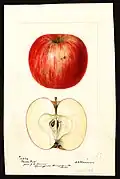 |
Conn. US | <1895 | W 88, H 67. Stalk 11 mm. Flesh whitish, crisp, tender, juicy, aromatic, subacid, good to very good. Pick late September - early August. Use October - January. | Eating |
| Peasgood's Nonsuch agm[304][21] |  |
England | 1858 | W 83 - 92, H 70-76. Stalk 8 mm. A very large yellowish-green apple, deepening to orange-yellow, flushed and striped red with some russet patches. Flesh is sweet and juicy. Good eating and superb for cooking. Large, hardy and heavy cropping tree. Apples can weigh up to half a kilogram, and are famously large enough to make a pie from a single apple. Pick mid September. Use September - December. | Cooking, Eating |
| Peck's Pleasant(syn. Waltz Apple)[3][305][306][307] | 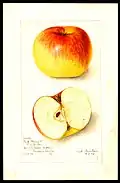 |
Connecticut ? US | Yellow with red flush. W 85, H 64-68. Stalk 9-13 mm. Flesh juicy, subacid, highly aromatic, very good to best. Use November - March. | Eating | |
| Pederstrup[13] | Denmark | <1850 | A medium size cooking apple. Stalk 10 mm. H 60 W 72. | Cooking | |
| Pekka[31] | Finland | Introduced 1999 | A dark red apple. Flesh subacid, sweet. P Lobo x Huvitus. Pick mid September. Use September - October. | Eating | |
| Pennock(syn. Romanie, Big Romanie, Pennock's Red Winter)[4] | 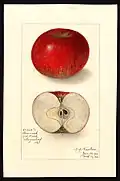 |
Pennsylvania, US | <1840 | Stalk short. Flesh yellow, subacid. Quality poor. Tree vigorous, very productive. Use December. | Cooking |
| Perry Russet[4] | 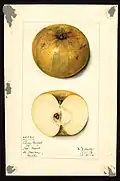 |
US | <1850 | W 86, H 64. Stalk 18 mm. Flesh yellow, acid. Use December - January. | Cooking, Eating |
| Petteri[31] | Finland | Introduced 2003 | A dark red appel. P Lobo x Huvitus. Flesh subacid, aromatic. Pick late August. | Eating | |
| Pewaukee[308][309] | 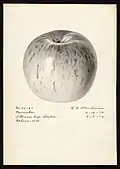 |
Wisconsin, US | ca 1870 | Tree vigorous. W 68, H 58. Stalk 10 mm. Flesh white, firm tender, juicy, aromatic, subacid, fair to good. Use November - April. | Eating |
| Pfirsichroter Sommerapfel[34] | 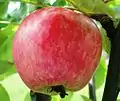 |
France | <1830 | Yellow with red flush. W 62, H 50. Stalk 15-20mm. Pick August. Use August. | Eating |
| Pickard's Reserve[4] | 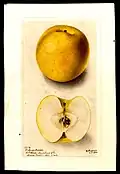 |
Indiana, US | <1850 | W 82, H 65. Stalk 13 mm. Flesh whitish-yellow, tender, juicy, subacid, aromatic. Use December - January. | Cooking, Eating |
| Pilot[18] |  |
Germany | Developed 1962, introduced 1988 | A conical apple, yellow with red flush. H 55-65, W 65-70, We 120. Pick October. Use February - July. | Eating |
| Pine Golden Pippin[8] | UK | 1861 | A golden yellow apple with russet. W 69, H 63. Pick early October. Use November - February. | Eating | |
| Pink Pearl[5] | .jpg.webp) |
California, US | Introduced 1944 | Noted for having bright pink flesh. P Surprise x unknown. Sweet. Possibly has crab apple in its ancestry. Makes cider have a reddish tint if pressed. Pick September. | Eating |
| Pinova[18] |  |
East Germany | 1965, introduced 1986 | Bred in Germany over an 18-year period. Marketed as "Piñata" in the United States. Fragrant smell, thin skin and balanced sweet and tart flavour profile. From Clivia × Golden Delicious. H 50-60, W 60-65, We 125. Pick October. Use December - May. | Cooking, Eating |
| Pirja[31] | Finland | Introduced 1980 | A red apple. P Huvitus x Melba. Flesh subacid. Pick early August. | Eating | |
| Piros[12] | 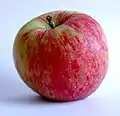 |
Germany | 1985 | A green apple with red flush. P Helios x Apollo. Pick early August. Use August. | Eating |
| Pitmaston Pineapple[8] |  |
Moseley, Worcester, England | 1785 | Pitmaston Pineapple is a dessert apple known since 1785. Small oblong apples with a yellow-green russeted skin. W 53, H 49.Tender flesh is an intense nutty, honeyed flavour with, as the name suggests, tropical undertones and some balancing acidity. Trees are biennial but produce heavy crops in the 'on' year. Pick mid September. Use October - December. | Eating |
| Pixie agm[310][21] | England | 1947 | Resistant to scab and mildew. W 64, H 51. Stalk 20 mm. Flesh intensely aromatic, Cox-like flavour, but sharper. FCC from RHS in 1972. Pick early-mid October. Use December - March. | Eating | |
| Pomme Grise[4][3][311][312] | 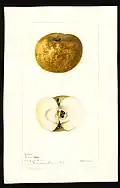 |
? | <1850 | W 61-63, H 45-50. Stalk 12–14 mm. Flesh yellow, juicy, aromatic, subacid, delicious. Use January - March | Eating |
| Pomme Royale see Dyer | |||||
| Pommerscher Krummstiel(syn. Krummstiel, Krummstengel, Gestreifter Römerapfel)[313] |  |
Vorpommern, Germany | <1798 | A yellow apple with red stripes. W 65-80, H 65-80. Stalk 20-25 mm. Flesh greenish-white, juicy, subacid. Quality: cooking good, eating fair. Pick October. Use November - February. | Cooking |
| Ponyik alma(syn. Poinikapfel)[314] | Hungary | <1872 | A green yellow apple with brown overcolour. H 57, W 76. Pick October. | Eating | |
| Potts Seedling[8] | Cheshire, England | c1849 | A yellow apple. W 81, H 67. Stalk variable. Flesh greenish white, soft, acid. Pick early September. Use September - October. | Cooking, Juice | |
| Poorhouse[3] | 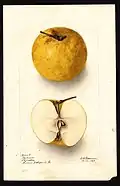 |
Kentucky, US | <1880 | Flesh yellow, juicy, subacid. Very good. Use December. | Eating |
| Porter's[4][315][316] | 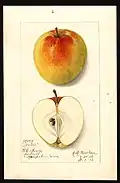 |
Massachusetts, US | <1850 | W 72, H 72. Stalk 23 mm. Smallish, squat, deep golden yellow colour with red blush and firm, Flesh yellow, fine-grained, aromatic, subacid, good to very good. Tree vigorous, healthy, productive. Use August - October. | Eating, Cooking or Cider. |
| Pott's Seedling[8] | England | 1849 | Pale green to yellow colour and white flesh. W 81, H 67. Pick September. Use September - October. | Cooking | |
| Pound Sweet(syn. Briar Sweet)[317] | 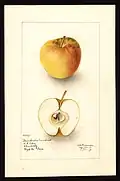 |
Manchester, Connecticut, US | 1834 | Amber coloration. Used mostly for making apple butter. Russets. Does well in moderate cold. Suitable to areas with snowy winters. | Cooking |
| Priestly[3] | 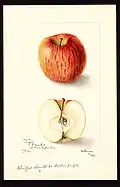 |
Pennsylvania, US | <1870 | Flesh white, juicu, aromatic. Tree vigorous, productive. Use December - March. | Eating |
| Prima | 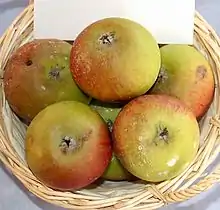 |
United States | 1958 | Resistant to scab and most diseases | Eating |
| Primate(syn. Scott, Powers, July Apple)[3][28][318][319] | 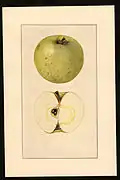 |
US | <1830 | W 72-94, H 62-76. Stalk 16–25 mm Tree hardy, very productive. Flesh white, tender, subacid, very good or best. Pick late August. Use September - October. | Eating |
| Primicia[10] | Brazil | 1982 | P D1R101T117 x D1R103T245. Flesh juicy, subacid, fair. | Eating | |
| Princesa[10] | Brazil | Introduced 1988 | P NJ 56 x Anna. Flesh sweet, subacid. | Eating | |
| Pristine | 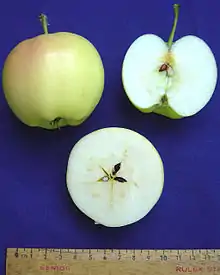 |
Indiana, United States | 1994 | Resistant to most diseases | Eating |
| Primula[144] | Poland | ||||
| Pryor Red[3] | 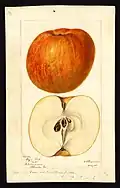 |
US | <1850 | W 80, H 62. Stalk 17 mm. Flesh yellow, tender, juicy, subacid. Use January - March. | Eating |
| Pumpkin Sweet[3][28][320][321] | 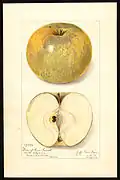 |
Conn. US | <1834 | A very large sweet apple. W 77, H 71. Stalk 17 mm. Biennial. Flesh white, firm, crisp, juicy, very sweet, peculiar flavor. Quality good for baking. Use September - October. | Baking, (Cooking) |
| Queen[8][21] | .jpg.webp) |
Essex, England | Raised 1858 Introduced 1880 | Large cooking apple for use in September - December. FCC from RHS in 1880. H 57-64, W 78-89. Stalk 18 mm. Pick late August. Use September - December. | Cooking |
| Quince(syn. Cole's Quince)[4] | 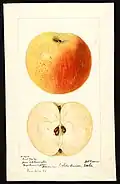 |
US | <1850 | A medium size ribbed apple. Flesh yellowish-white, juicy, aromatic, subacid. Use November - January. | Cooking |
| Quinte[14] | Canada | 1964 | A red oblong apple. W 68, H 65. P Crimson Beauty x Red Melba. Pick August. | Eating | |
| Quittenförmiger Gulderling[34] | 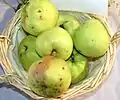 |
Germany | <1830 | W 62-78, H 56-80. Stalk 6 mm. Use November - February. | Cooking |
| Råby Rubin[97] |  |
Sweden | c1960 | A small greenish-yellow apple with red flush. Flesh juicy, subacid, aromatic, good. Pick October. Use October - December. | Eating |
| Ragan(syn. Ragan's Red)[3] | 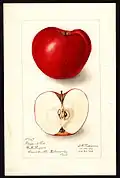 |
Ind. US | <1870 | A green apple striped with red. Flesh yellowish-white, pleasant, juicy, spicy, subacid. Tree hardy, vigorous. Use October - November. | Eating |
| Rainha[10] | Brazil | 1975 | P Golden Delicious x Valinhense. Flesh sweet, subacid. | Eating | |
| Rajka | 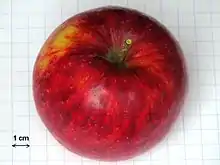 |
Czechoslovakia | Scab-resistant cross of Rezista × Rome | Eating | |
| Ralls Genet(syn. Ralls )[322][323] | 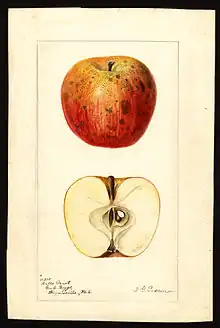 |
Virginia, US | ca1800 | Biennial. W 73, H 67. Stalk 16 mm. Flesh white firm, crisp, tender, juicy, subacid, very good. Use November - April. | Eating |
| Rambo(syn. Romanite of New Yersey, Bread and Cheese)[4] | 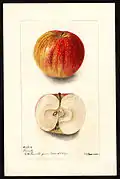 |
US | <1850 | W 78, H 60. Stalk 15 mm. Flesh greenish-white, tender, juicy, subacid, aromatic, vinous. Use October - December. | Cooking, Eating |
| Rambour de Flandre see Flandrischer Rambour | |||||
| Rambour d'Hiver(syn. Rambour Rouge, Rambour Doux)[324] | 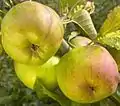 |
France | 1628 | A green apple with red stripes. H 55-85, W 75-105 We 280. Stalk 16–19 mm. | Eating, Cooking |
| Rambour Franc(syn. Lothringer Rambour, Müschens Rosenapfel)[34] | 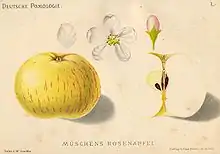 |
France | 1665 | Yellow green with red flush. W 87-112, H 60 -86. Stalk 11mm. Pick September. Use October - November. | Eating, Cooking |
| Rambour Papeleu[34] |  |
Crimera, Ukraine | 1850 | Green with red flush H 67, W 77. Pick October, Use October - December | Eating, Cooking |
| Ramsdell (syn. Ramsdell Sweet, Hurlbut)[4] | 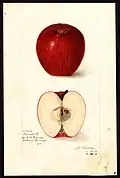 |
Connecticut, US | ca 1838 | W 90, H 89. Stalk 14 mm. Flesh yellow, firm, tender, juicy, very sweet, good to very good. Use September - December. | Baking |
| Reanda[12] | Germany | 1993 | A red apple resistant to scab and fire-blight. Pick September. Use October–January. | Eating, Cooking | |
| Red and Green Sweet[28] | 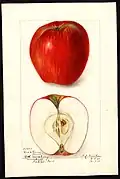 |
US | <1817 | Stalk short to medium. Flesh white, tender, juicy, sweet. Use August - September | Eating |
| Red Astrachan[6][325][326][327] |  |
Russia or Sweden | c. 1800 | Extremely resistant to frost. H 76, W 82. Flesh white, fine, crisp, tender, juicy, subacid, aromatic, good to very good. The tree does not attain a large size. Pick and use in August. | Cooking |
| Red Canada(syn. Poland, Richfield Nonsuch)[3][328][329][330] | 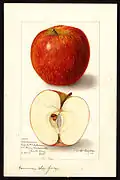 |
US | <1820 | W 74-81, H 61-67. Stalk 17-21 mm. Flesh white, tender, crisp. Very good. Use January - May. | Eating |
| Red Delicious[161][21] | 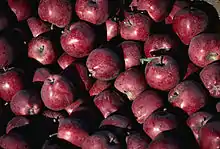 |
Iowa, US | c. 1870 | Unmistakable for its acutely conic shape, dark red colour and telltale bumps on bottom. W70, H 70. Stalk 19–22 mm. Flavour is sweet and mild. Extremely poor choice for cooking or cider; tastes terrible in pies. Original seedling known as "Hawkeye." Rights bought by Stark Brothers in 1893. First marketed as "Delicious" or "Stark's Delicious," name changed to "Red Delicious" in 1914 when Stark bought the rights to Mullin's Yellow Seedling, changing that apple's name to "Yellow Delicious". Red Delicious has many sports and ranks as the world's most prolific apple. Pick mid October. Use December - March. | Eating |
| Red Duchess[5] | New York, US | 1914. Introduced 1937 | A red mutant of Duchess. | ||
| Red Falstaff agm[331] | Falstaff sport with red/orange flush to the skin, late, prolific | Eating | |||
| Redgold[5] | Washington | Selected 1936, Introduced 1946 | P Golden Delicious x Richared Delicious. | Eating | |
| Red Graham[5] | Michigan | Introduced 1936 | Mutation of Northern Spy. | Cooking | |
| Red Gravenstein[332] | 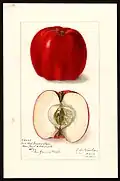 |
Washington, US | c1908 | A red sport of Gravenstein | Eating, Cooking, Pie |
| Red June(syn. Carolina Red June)[28]<ref[3][4][333] | 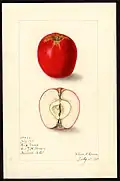 |
North Carolina, US | <1848 | Flesh white, fine, tender juicy, subacid, good to very good. W 55-65, H 57-67. Stalk 13 – 20 mm. Use August - October. | Eating |
| Red Prince |  |
Weert, Netherlands | 1994 | Medium-sized, conic, uniform deep red skin. White flesh is crisp, sweet and juicy, with hints of cherry and almond. Excellent keeper. Chance seedling (a natural cross of Jonathan and Golden Delicious) discovered in 1994. Marketed throughout Europe, in 2001, Global Fruit in Ontario became exclusive growers of the variety in North America.[334] | Eating, Cooking |
| Red Russet[3] | 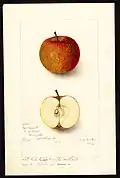 |
N.H. US | <1875 | Stalk short. Flesh yellow, crisp, tender, subacid. Very good. Use January - April. | Eating |
| Red Sauce[5] | 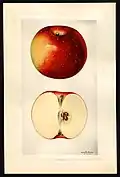 |
Geneva, New York, US | 1917 Introduced 1926 | P Deacon Jones x Wealthy. Flesh subacid. Use October. | Cooking |
| Red Spy[5] | 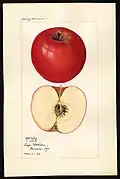 |
New York, US | Introduced 1923 | Mutation of Northern Spy. | Cooking |
| Red Stripe[4] | 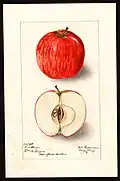 |
Indiana ?, US | <1850 | Stalk short. Flesh whitish, tender, acid, juicy. Use July - August. | Cooking, Eating |
| Red Winesap[5] | 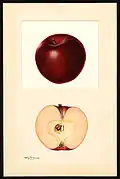 |
Washington, US | Introduced 1930 | P unknown. | |
| Reglindis[12] |  |
Germany | 1990 | Yellow with red flush. Sugar 10.6% Acid 0.83% Juice yield 80%. Pick September. Use October–November. | Cooking. Juice |
| Reinette Coulon[335] |  |
Belgium | 1856 | W 80-90, H 65-75. Pick late October. Use December - March. | Cooking |
| Reinette de Breda see Breda Reinette | |||||
| Reinette de Bretange[34] | 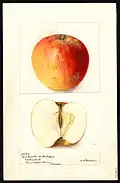 |
France | <1850 | W 73, H 55. Stalk 8 mm. Flesh sweet, crisp. Use November - February. | Eating, Cooking, Cider |
| Reinette de Champagne[12][34] |  |
France | 1770 | A green apple.W 66-79. H 48-58. Stalk 16 mm. Pick October. Use February - May. | Cooking (Eating) |
| Reinette de Montmorency[34] | 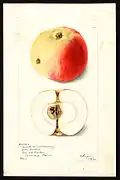 |
? | <1800 | A gelb apple with red flush. W 70, H 56. Stalk 13 mm. Flesh juicy, sweet. Use January - May. | Cooking, Eating |
| Reinnete Diel[6] | Belgium | <1840 | A beautiful dessert apple of first quality. W 50, H 56. Use December - March. The tree is a healthy and vigorous grower. | Eating | |
| Reinette Dippedalle[34] | .jpg.webp) |
France | <1850 | Green with red flush. W 57, H 45. Stalk 10mm. Use December - April. | Cooking, Eating. |
| Reinette du Canada[18][7] | 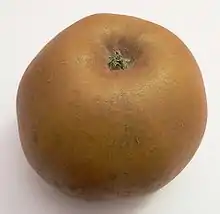 |
Normandy, France | 1771 | Despite its name, it is an old French cultivar of domesticated apple. It is a reinette type of golden apple, with much russeting, which keeps shape in cooking. AM from RHS in 1901. If stored for some time it gets softer and is good to eat. W 90-100, H 70-80, We 170. | Eating, Cooking |
| Reinette Franche[6] | 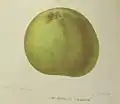 |
France | <1700 | A dessert apple of first-rate quality. H 64, W 80. Use November - April. The tree is a free grower, but subjet to canker. | Eating |
| Reinette Grise[6] | France | <1800 | A very fine desser apple. H 63, W 76. Use November - May. The tree is a healthy and vigororus grower, and an excellent bearer. | Eating | |
| Reinette Middelburg[34] |  |
Netherlands | <1850 | Yellow conical. W 56-65, H 52-62. Stalk 10 mm. Use December - April. | Cooking, Eating |
| Reinette Rouge Etoilée[8] |  |
Belgium or Netherlands | 1830 | Round red apple.No ribs. H 56, W 62. Stalk short and stout. Flesh, dry subacid. Use October - November. | Eating |
| Reinette Simerenko see Wood's Greening | |||||
| Reka[12] | Germany | 1984, Introduced 1993 | A green apple with red flush. Pick September. Use September - October. | Eating | |
| Relinda[12] | Germany | 1993 | A scab resistant red apple. P Undine x F3. Picking October. Use December - March. | Eating, Cooking | |
| Renown[7] | 1908 | A conical uneven apple, covered with red flush. P Peasgood Nonsuch x Cox Orange. AM from RHS in 1908. Flesh pale yellow firm, good. Raised by Charles Ross. | Cooking, Eating | ||
| Rescue[5] | Saskatchewan, Canada | Introduced 1933 | P Blushed Calville x unknown. Pick late August. | Eating | |
| Retina[12][336] | Germany | 1991 | A red apple. P Apollo x F3. Pick September. Use October. Resistant to scab. | Eating, Cooking | |
| Rev. W. Wilks[337][8][21] | Slough, Buckinghamshire, England | 1904, Introduced 1908 | P Peasgood's Nonsuch x Ribston Pippin. Pastel green with a light pink flush. Very disease-resistant. W 89, H 76. Stalk 10 – 16 mm. Cooks to a light, pale puree, hardly needing any sugar. AM from RHS in 1904. FCC from RHS in 1910. Nearly resistant to apple scab and apple canker. Pick early September. Use September - November. | Cooking | |
| Rewena[12] |  |
Germany | 1991 | A green apple with purple overcolour (up to 80%) Resistant to scab, powdery mildew and fire-blight. P BV 67,47 x F3 Pick August. Use September. | Eating, Cooking |
| Rheinischer Krummstiel[34] |  |
Germany | <1830 | W 62-69, H 67-71. Stalk 7 mm. Flesh juicy, sweet. Use December - April | Cooking |
| Rheinische Schafsnase[34] |  |
Germany | <1886 | W 84, H 80-83. Stalk 15 mm. Flesh juicy, sweet. Use December - February. | Cooking |
| Rhode Island Greening(syn. Burlington Greening, Russine, Bell Dubois, Jersey Greening)[3][28][338] | 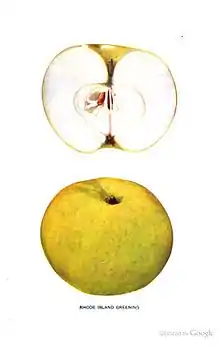 |
Newport, Rhode Island, US | 1650s | Extremely old variety for United States, second only to Roxbury Russet in age. W 81-93, H 65-74. Stalk 16–24 mm. Grass-green colour with some possible russeting near stem. Bred to keep over winter; will store well. Occasional reddish pink blush. Flesh yellow, firm, crisp, tender, juicy, subacid, very good. Excellent choice for pies and strudels when used for baking. Use November -February. | Cider, Cooking |
| Ribston Pippin(syn. Formosa Pippin, Travers Pippin)[7] agm[339][21][340][341][342] | 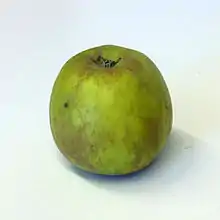 |
Knaresborough, North Yorkshire, England | 1708 | An irregularly-shaped and sometimes lopsided apple, usually round to conical and flattened at the base with distinct ribbing. W 70, H 58. Stalk 10 mm. Skin is yellow with an orange blush and red streaked with russet dots. Yellow flesh is firm, fine-grained, crisp, juicy, aromatic and with a pear-like flavour, subacid, very good. The original Ribston Pippin sprouted in 1708 from one of three apple pips sent from Normandy to Sir Henry Goodricke, 4th Baronet of Ribston Hall at Knaresborough. The original tree stood until 1835. It then sent up a new shoot and, on the original roots, lived until 1928. Pick early October. Use Nov. - Jan. | Eating |
| Richard's Graft(syn. Red Spitzenberg, Strawberry, Derrikinan)[4][28] | 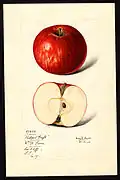 |
New York, US | <1852 | W 75, H 59. Stalk 20 mm. Biennial. Flesh yellowish-white, tender, juicy, aromatic, subacid, very good. Tree medium size. Use September - October. | Eating |
| Richared Delicious[5] | 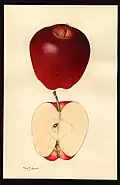 |
Washington | Introduced 1926 | Mutation of Delicious | Eating |
| Ridge[4] | 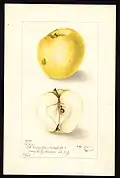 |
US | <1850 | A large apple. Flesh yellowish, juicy, crisp, sweet, aromatic. Tree a good grower and bearer. Use March - April. | Eating |
| Ringstad[13] | 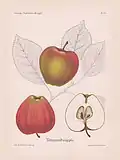 |
Sweden | c1800 | A yellow apple with red overcolour. W 73, H 60. Pick September. Use October - November. | Eating |
| Risäter[13] | 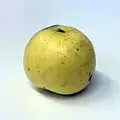 |
Sweden | c1800 | A yellow apple. W 68, H 58. Flesh subacid. Pick September. Use October - November. | Eating, Cooking, Cider |
| Rival[7][50][21] | Berkshire, England | 1900 | Round, flattened and somewhat uneven-shaped apple. A fairly good cropper, keeping well into December. Raised by Charles Ross. AM from RHS in 1900. H 58-63, W 73-76. Stalk 10 mm. Pick late September - early October. Use October - December. | Eating, Cooking | |
| Rivers Early Peach[7] | A yellow flat conical apple. W 88, H 70. Flesh white, sweet, aromatic, dry. Stalk short. Raised by Mr. Rivers. Pick mid- August. | Eating | |||
| Rock Pippin(syn. Ridge Pippin, Lemon)[4] | 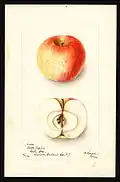 |
US | <1850 | W 75, H 75. Stalk 15 mm. Flesh yellow, dry, acid. Use December - March. | Cooking |
| Rolfe[28] | 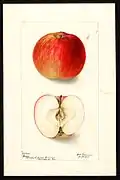 |
Maine, US | <1857 | Stalk short to medium. Flesh whitish, tender, juicy, sweet. Use August - September. | Eating |
| Roman Stem[28] | 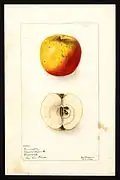 |
New-Jersey, US | <1800 | Flesh juicy, aromatic, subacid, very good. Use October - December. | Eating |
| Rome Beauty[343][7][344][345] | 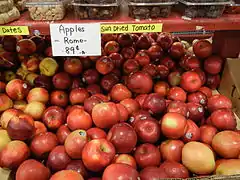 |
Rome, Ohio, United States | Introduced 1848 | Rounded, deep red, and very glossy. W 82-86 H 70-74. Stalk 28 mm. Flesh yellow, firm, crisp, juicy, aromatic, mild subacid, good. Develops an extraordinary depth and richness when cooked. Use November - May | Cooking, Eating |
| Ronk[28] | 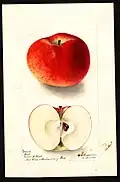 |
Indiana, US | 1860 | An apple of the Vandevere type. Use October - January. | Eating |
| Rosemary Russet[7] agm[346][21] | United Kingdom | First recorded 1831 | Flat conical, yellow with brick red flush, flesh crisp, yellow. Regular cropper. Flesh, juicy, sweet, sharp, like 'Ashmead's Kernel'. W 64-70, H 55. Stalk 24–28 mm. Pick late September Use November - March. | Eating | |
| Rosenhæger Danish[29] | Denmark | <1795 | A green apple with red overcolour. H 48-55, W 53-60. Use October - November. | Eating | |
| Rosenhäger Swedish[13] | Sweden | <1800 | A yellow apple with red overcolour. H 50, W 68. Use November - December. | Eating | |
| Ross Nonpareil[7][50] | Ireland | 1802, introduced to England 1920 | Small , round, even, covered russet with dark crimson markings. Flesh soft, rich nonpariel flavour. Use Nov. - Jan. | Eating | |
| Roter Ananas[29] | Germany | 1854 | A red conical apple. W 58, H 56. Stalk 20mm. Pick September. Use September–October. | Cooking, Eating | |
| Roter Eiserapfel[347] | 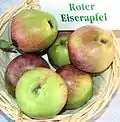 |
Europe | <1700 | A green apple with red flush. W 75-80, H 68-75. Stalk 5-15mm. Flesh very hard. Quality: cooking good, juice good. Use December - July. | Cooking, Juice |
| Roter Stettiner(syn. Roter Winterstettiner)[348] |  |
Germany or Poland | <1800 | Greenish-yellow with red flush. W 75, H 55. Stalk 11-15 mm. Flesh yellowish-white, juicy, subacid. Pick October. Use January-June. | Cooking, Drying, Juice |
| Roter Trierer Weinapfel[12] |  |
Germany | <1880 | A red apple for juice and cider. Pick October. Use November - March. | Juice, Cider |
| Rother Jungfernapfel[34] |  |
Bohemia, Germany | <1800 | A small apple. W 49, H 46. Stalk 20 mm. Use November - January. | Eating, Cooking |
| Rother Winterhimbeerapfel(syn. Oberländer Winterhimbeerapfel, Zigeunerapfel)[14] | Hungary | <1850 | A red apple. W 66, H 55. Flesh juicy, aromatic. Pick October. Use November - March. | Eating | |
| Roundway Magnum Bonum[7][6] | Roundway Park, Devizes, Wiltshire, England | 1864 | Very large apple. A first-rate culinary or desert apple. Flesh greenish-yellow, dry, sweet pear-like flavour. | Eating, Cooking | |
| Rouville[144] | Canada | 1983 | |||
| Roxbury Russet(syn. Boston Russet, Putnam Russet, Warner Russet, Sylvan Russet, Belpre Russet, Marietta Russet, Howe's Russet)[349][79][28][350] | 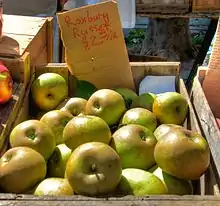 |
Massachusetts, United States | c. 1640 | First tree a chance seedling grown in Roxbury, Massachusetts, now a neighborhood of Boston. Oldest known variety of apple in America, planted by Pilgrim Fathers as foundation stock for Massachusetts Bay Colony. Knobbly, russetted coat gives green skin a bronze tinge. Flesh cream coloured flesh, firme, coarse, tender, juicy, subacid good to very good. W 70-89. H 57-76, Stalk 12–26 mm. Excellent keeper; resistant to fireblight. Mild flavour. Multi-purpose apple that is a wonderful choice for pies, eating fresh, or cider. Still available in New England farmer's markets; commercial interest recently renewed in this cultivar because of its past use as a cider apple. Use January - June. | Cooking (pies), Eating, Cider. |
| Royal Gala see Gala | |||||
| Ros Picant | Romania | 19th century | Characterized by its distinct, faintly spicy flavor. Green and yellow, mostly used for making cider and Pálinka. | Cider, cooking, Eating | |
| Royal Jubilee(Graham's)[7][351][18][21] | 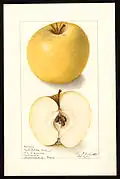 |
Middlesex, England | 1888, introduced 1893 | Large yellow conical cooking apple. W 65 - 90. H 54 - 90, We 130 - 190. Raised by John Graham of Hounslow. Stalk 10 mm. Tree very dwarf. Flesh yellow subacid. Free from canker. Pick late September. For use in October–December. | Cooking |
| Royal Late[7] | England | <1896 | A large yellow-green apple with russet. Am from RHS in 1896. Flesh soft, yellow, juicy, subacid. Very liable to canker. | Cooking | |
| Royal Russet[6] | England | 1597 | A most excellent culinary apple of first rate quality. W 88 H 69. Use November - May. | Cooking | |
| Rozela | Czech Republic | 2008 | Flesh is medium firm, juicy with great aromatic flavour and delicate smell. The skin is attractive bright red with prominent lenticels. Annual producer of heavy crops, the resistant equivalent of Idared with outstanding flavour. | Eating | |
| Rubens (Civni) | 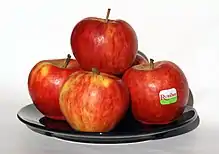 |
Italy | 1985 | Sweet and crunchy; Gala × Elstar. | Eating |
| Rubinette(syn. Rafzubin)[12] | 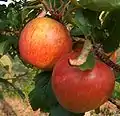 |
Germany | 1966, Introduced 1982 | A yellow apple with red flush. P Golden Delicious x unknown. Pick September. Use September - December. | Eating |
| Ruddy[7] | A round apple covered with red flush. Flesh sweet, slightly aromatic. P Ecklinville x Mere de Menage. Raised by Charles Ross. | ||||
| Rushock pearmain[6] | Wocestershire England | 1821 | An apple of first-rate qualtity, almost entirely covered with russet. H 57, W 63.Use Christmas - April. | Eating | |
| Rutledge[28] | 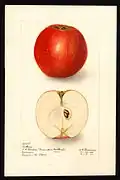 |
Texas ? US | <1892 | Tree vigorous. Flesh tender, juicy, subacid, sweet, fair to good. Use January–May. | Eating |
| Sack and Sugar[7] | A yellow apple. Stalk very short. Flesh tender, juicy, aromatic, good. Pick September. | Cooking, Eating | |||
| Saint Cecila[50] | Wales | 1900 | Even oval, golden yellow with crimson flush and stripes. H 60, W 73. FCC from RHS in 1919. Pick early October. Use December - March. | Eating | |
| Saint Clair[5] | Illinois, US | Introduced 1947 | Resembles of Wealthy. Tree strong, productive. | Eating | |
| Saint Edmund's Pippin[7]agm[352][21] | Bury, St. Edmunds Suffolk, England | 1870s | W 63, H 52. Stalk 12 – 22 mm. Unusual in fact that it has scaly russet patches mixed with smooth. Raised by Mr. Harvey. One of the best early russets. Flesh yellow, very juicy, vanilla/pear taste. Usually a light yellow-green. Pick mid September. Use September - October. | Eating | |
| Saint Everard[7][50][353] | Papwoth Everard, near Cambridge, Cambridgeshire, England | 1900, introduced 1910 | Yellow striped with crimson. H 45, W 57. FCC from RHS in 1919. Flesh crisp, yellow, juicy, excellent. Pick early September. Use September. | Eating | |
| Saint Lawrence[28] | 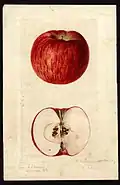 |
? | <1831 | Flesh tender, juicy, subacid. Use September - October. | Eating |
| Saint Martins[7] | England | <1896 | Brownish red with russet. A very sweet apple. AM from RHS in 1896. P Bess Pool x Cox Orange. Use - February | Eating | |
| Salome[354][355] | 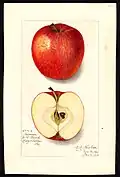 |
Illinois, US | ca 1853 | Yellow with red flush, round oblate.W 74, H 64. Stalk 16 mm. Tree vigorous, large. Flesh yellow firm, crisp, tender, juicy, subacid, good to very good. Use November - March. | Eating |
| Saltcote Pippin[50][8][356] | England | <1918 | Good flavour reminding one of Mother. Award of Merit from RHS in 1928. W 74, H 61. Stalk short or medium. Flesh, juicy, sweet, aromatic. Pick early October. Use November - January. | Eating | |
| Samo[31] | Finland | Introduced 1981 | A greenish-yellow apple. P Melba x Huvitus. Flesh sweet, subacid. Pick September. | Eating | |
| Sandow | Sandow | Ontario, Canada | 1935 | Fruity (raspberry,cherry flavours), tart, sweet, recommended for eating, cooking, and cider. Sandow is one of Canada's best kept secret apples. A few orchards exist in New Brunswick, Canada, where the trees can also be purchased. Stores well for four to five months in refrigeration. | Eating, Cooking, Cider. |
| Sandra[31] | Finland | Introduced 1996 | A red Apple. P Lobo x Huvitus. Flesh sweet, subacid. Pick mid September. | Eating | |
| Sandringham[7] | Norfolk, England | introduced 1884 | A yellow apple. FCC from RHS in 1883. P Woodford x King of the Pippins. Flesh yellowish, firm, soft, subacid. | Cooking | |
| Sanspareil[50][7] | England | <1899 | Medium to large , even round apple. Yellow red stripes. First Class Certificate from RHS in 1899. Use: February - May. | Cooking, Eating | |
| Santana[357] |  |
Wageningen, Netherlands | 1978 | Scab resistant. | Eating. |
| Särsö (syn. Mignon, Cloetta)[14][97] | 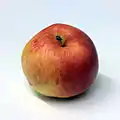 |
Sweden | <1917 | W 73, H 60. Stalk 25 mm. Flesh subacid, fair to good. Pick late September, Use October - November. | Eating, Cooking, Jam |
| Saturn | Kent, England | 1980 | Scab resistant. | Eating. | |
| Scarlet Cranberry[28] | 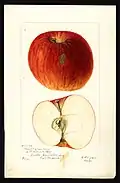 |
Virginia, US | <1865 | Flesh crisp, juicy, astringent, subacid, fair to good. | Eating |
| Scarlet Nonpareil[6][7] | Surrey, England | 1773 | A very excellent dessert apple of first-rate quality. AM from RHS in 1901. Flesh pale yellow, sweet, firm, good. Use: January to March. H 52, W 57. | Eating | |
| Scarlet Pearmain[6][7][358] | Middlesex, England | c1800 | A dessert apple of first rate quality. The tree is a free and vigorous grower. Flesh yellow, tender. H 54, W 60. Use: October–January. | Eating | |
| Scarlet Pippin[28] | 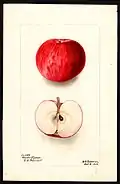 |
Ontario | <1895 | Stalk short. Flesh white, juicy, subacid. Use September - October. | Eating |
| Scarlet Staymared[5] | Washington, US | Introduced 1936 | A red apple. | Cooking | |
| Scarlet Tiffing[92] | England | <1875 | A valuable and excellent culinary apple. W 76 HH 57. Stalk 12 mm. Use November - December. | Cooking | |
| Schoolmaster[92][7] | Lincolnshire,England | 1855, introduced 1882 | A fine cooking apple. FCC from RHS in 1880. W 76, H 70. Stalk very short. P Golden Noble x Dumelow. Flesh white, crisp, acid. Pick October. Use November - January. | Cooking | |
| Scweizer Orange[18] | Switzerland | Raised 1935, Introduced 1954 | A green-yellow apple with red orange flush. W 67, H 50, We 105. | Eating, Cooking | |
| Scrumptious agm[359] | Kent, England | 2003 | Sweet and crisp. Self-fertile, mid-season variety that ripens in early September and will store well for about a month. The blossom is frost hardy resulting in heavy crops and the tree can be grown in all areas of the UK. The flesh is crisp and aromatic and the thin skin turns deep red as it develops | Eating | |
| Secor[5] | Iowa, US | Introduced 1922 | P Salome x Jonathan. Free from Jonathan spot in storage. Use January - April. | Eating | |
| SeeandO Red Rome 262[5] | Washington, US | Introduced 1943 | Mutation of Rome Beauty. | Eating | |
| Seneca Favorite[28] | 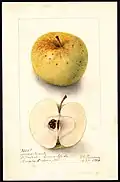 |
US | <1853 | Stalk long to medium. Flesh crisp, tender juicy, subacid, very good. Pick September. Use September - December. | Eating, Cooking. |
| September Beauty[53][7] | Bedfordshire, England | 1885 | H 57, W 70. FCC from RHS in 1885. A yellowish-green apple, striped with orange. Flesh yellow, tender. Skin slightly russetted. Pick mid September. Use September - November. | Eating | |
| Shackleford[28] | 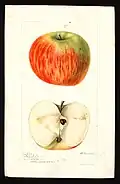 |
Missouri, US | <1883 | W 83, H 69. Stalk 16 mm. Flesh firm, crisp, tender, juicy, subacid, fair to good. Use November - April. | Eating |
| Sharp[28] | 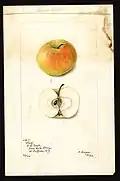 |
Illinois, US | <1889 | W 65, H 48. Stalk 10 mm. Flesh tender, crisp juicy, sweet, very good. Use October - November. | Eating |
| Sharon[5] | 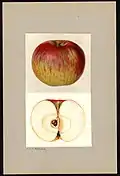 |
Iowa, US | Introduced 1922 | A red striped fruit. P McIntosh x Longfield. Tree vigorous, productive, hardy. | Eating |
| Shinano Sweet | Nagano, Japan | 1978 | mid-season crops. Tsugaru x Fuji | Eating | |
| Shiawasse(syn. Shiawasse Beauty)[4][360] | 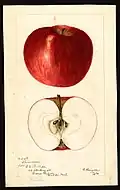 |
Mich. US | Introduced 1862 | W 81, H 54. Stalk 10 mm. Flesh white, subacid, aromatic. Use October - January. | Eating |
| Shockley[3] |  |
Jackson County, Georgia, United States | 1852 | W 64, H 59. Stalk 22 mm. Yellowish and green skin with reddish stripes. Flesh crisp, juicy, sweet taste with vinous flavour. Use April - May. | Eating, preserves |
| Shoesmith[8] | Surrey, England | <1930 | P Lane's Prince Albert x Golden Noble. W 93, H 76. Stalk medium to long. Flesh white, soft, juicy, subacid. Pick late September. Use September - December. | Cooking | |
| Shotwell Delicious[5] | Washington, US | 1928 | Mutation of Delicious | Eating | |
| Siely's Mignonne[92] | England | c1800 | Yellow covered with russet. H 45, W 45. Stalk 13 mm. Flesh greenish yellow. Juice highly aromatic and of most excellent flavour. Use November - February. | Eating, Juice | |
| Signe Tillisch[18] | 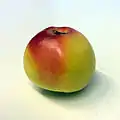 |
Denmark | 1866 | W 70-90, H 55-80, We 95-200. Alexander x London Pippin. | Eating, Cooking. |
| Sirius | _jm123575.jpg.webp) |
Czech Republic | 2007 | Flesh yellow, firm, crisp, fine
grained, very juicy, well balanced sugar and acid level, rich flavour |
Eating |
| Sir John Thornycroft[50] | United Kingdom | <1911 | Above medium size, shing yellow with pinkish red flush on sunny side. AGM from RHS in 1911. Use October - March. | Eating | |
| Sir William Gibbon's[92] | England | <1880 | A calville-shaped excellent culinary apple. H 76 W 96. Stalk very short. Use November - January. | Cooking | |
| Sitchamton Russet[92] | England | <1876 | A dessert apple of good quality. Skin covered with grey russet. H 51, W 60. Stalk short and stout. Flesh yellowish, juicy, aromatic flavour. Use December - February. | Eating | |
| Sköldinge[14] |  |
Sweden | c1800 | W 65, H 61. Stalk 15 mm. Flesh juicy, sweet, subacid, good. Pick early October. Use November - January. | Eating |
| Slack-Ma-Girdle | Devonshire, England | <1880 | Yellow streaked with red. H 47, W 62. Stalk very short. Pick mid October. Use October - December. | Cider | |
| Slastica[11] | Croatia | Yellow with red flush. W 50-60, H 40-60, We 70-100. Short stalk. Flesh yellowish to white, firm, juicy, sweet. Disease resistant. Biennial. Pick mid-October. | Eating, Cooking, Cider, Drying | ||
| Slatka šarenika(syn. Šarenika)[11] | Montenegro | Green with red flush. W 71, H 59. We 149. Stalk medium. Flesh juicy, sweet, aromatic. Pick mid October. Use November - May. | Eating, Cooking | ||
| Slatka srčika(syn. Srčika)[11] | Croatia | A yellow apple with red flush. W 65 - 75. H 50-60. We 100-150. Stalk short. Flesh juicy, sweet, subacid. Pick mid October. | Eating, Cooking, Cider, Drying. | ||
| Sleeping Beauty[6] | Lincolnshire, England | 1851 | Medium sized. A most excellent apple for all culinary purposes, and particularly for sauce. Use November - February. | Cooking | |
| Slor[10] | Israel | Introduced 1982 | Large conic, dark red stripes. Flesh sweet, subacid. | Eating | |
| Small's Admirable[7][6] | Lincolnshire or Buckinghamshire, England | c1850 | An excellent kitchen and dessert apple. Flesh white, firm, crisp, juicy, subacid. Use November - December. | Cooking, Eating | |
| Smith's(syn. Smith's cider)[4][3][28] | 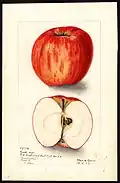 |
Pennsylvania, US | <1825 | W 70-83, H 60-76. Stalk 10–20 mm. Tree very vigorous. Flesh white, tender, juicy, crisp, subacid, good. Use December - March | Cooking, Cider |
| Smokehouse[3][361] | 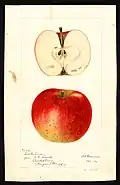 |
Mill Creek, Pennsylvania, US | 1837 | W 82-88, H 64-68. Stalk 19-23 mm. Greenish-yellow with flushed red-orange stripes. The yellowish-white flesh is crisp and tender with a spicy-sweet flavour that tastes like cider. Excellent all-purpose apple. Unusual in that it also makes excellent cider. Seedling discovered growing next to the smokehouse on William Gibbons' farm in Mill Creek, PA. Bears fruit from young age. Use September - February. | Eating, Cooking, Cider. |
| Snow apple (Fameuse) |  |
Quebec, Canada | 17th century | Tender, aromatic, distinct flavour. A parent of McIntosh. | Cider, cooking, eating |
| Snövit[14] |  |
Sweden | 1936 | Yellow with red flush. W 64, H 56. P Stenbock x Pfirsichroter Sommerapfel. Pick September. Use September. | Eating |
| Södermanlands kalvill[97][362][14] |  |
Sweden | <1850 | W 70-100, H 61-86. Stalk 17–18 mm. Flesh juicy, aromatic, good. Use October - December. | Eating |
| Södermanlands äpple[97][362][14] |  |
Sweden | <1800 | W 65-83, H 65-79. Stalk 19–28 mm. Flesh juicy, subacid, good. Use September - December. | Eating |
| Somerset[28] | 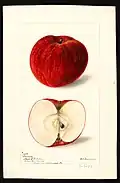 |
US | <1869 | Tree is an early bearer. Flesh white, juicy, aromatic, very good. Use September - October. | Eating |
| Sonya | New Zealand | 2000 | Cross between a Red Delicious and Gala. Coppery coloration. Crisp. | Eating | |
| Sops-in-Wine(syn. Sops of Wine)[7][6][4][363][364] | 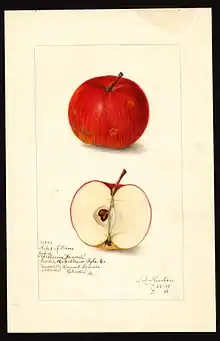 |
Cornwall or Devonshire, England | <1688 | W 71-89, H 60-73. Stalk 20 mm. Red flesh, juicy, and pleasantly flavoured. Tree is vigorous, very hardy, an excellent bearer and not subject to canker. Use August - September. | Cooking, Cider |
| Sowman's Seedling[365] | Lancashire, England | <1928 | A large green apple. P Grenadier x Bismark. Very susceptible to Bitter Pit. | Cooking | |
| Sparreholm[14] |  |
Sweden | 1868 | W 77 H 77. Stalk 10mm. Pick September. Use September. | Eating |
| Spartan[21] | 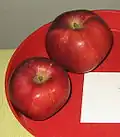 |
British Columbia, Canada | Raised 1926, Introduced 1936 | Round-conical, yellow, 75-100% flushed crimson. Strong aroma. Prone to canker. W 64, H 58. Stalk 15–20 mm. Good all-purpose, medium-sized apple. Has a bright red blush and may have background patches of greens and yellows. Popular across border in United States as well. Pick early October. Use November - February. | Cooking, Eating, Cider |
| Splendour/Splendor | .jpg.webp) |
New Zealand | 1948 | Descendant of Red Dougherty x Golden Delicious, ancestor of Pacific Rose and Aurora Golden Gala | Eating |
| Stanard(syn. Stannard)[4] | 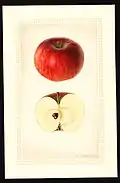 |
New York, US | <1850 | W 88, H 72. Stalk 14 mm. Flesh yellow, tender, acid to subacid. Use November - February. | Eating |
| Stäringe Karin[97] |  |
Sweden | <1902 | W 77, H 67. Stalk 15 mm. A green apple with red flush. Flesh, juicy, subacid, good. Pick late September. | Eating |
| Star of Devon[7][8] | Devonshire, England | 1905 | Oblong shaped yellow apple with red stripes. AM from RHS in 1905. Flesh white, soft, poor. H 48, W 64. Pick early October. Use October - April. | Eating | |
| Stark[366][367] | 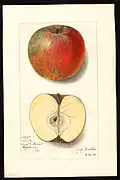 |
Ohio ? US | <1867 | W 92, H84. Stalk 20 mm. Tree vigorous, hardy, healthy. Flesh yellow, firm, fine, tender, juicy, mild subacid, fair to good. Use November - April | Eating, Cooking |
| Stark Earliest[5][21] | 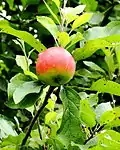 |
Idaho, US | 1938. Introduced 1944. | W 57-60, H 45-60. Stalk 18 mm. Does nicely in fruit salads. Red striping on light background. Pick early August. Use August - September. | Eating |
| Starkey[28] | 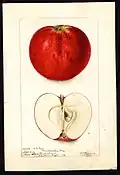 |
Me. US | <1875 | Stalk medium. Flesh white, juicy, crisp, subacid, very good. Use October - January. | Eating |
| Starr[3] | 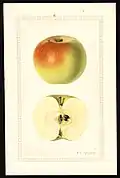 |
New Jersey, US | <1870 | Flesh whitish, subacid. Good. Stalk slender. Use July - September. | Cooking |
| Starking[5] | 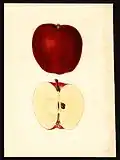 |
New Jersey | 1921. Introduced 1924 | A red mutation of Delicious. | Eating |
| Stayman[368][369] | 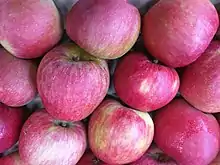 |
US | 1866 | Dullish red skin often covered with a light russet. H 76, W 78. Tart, wine-like flavour. Flesh yellow, firm, coarse, tender, juicy, mild subacid, aromatic, good to very good. Stores well. Particularly known for tangy cider. Use January - May. | Cider, Cooking, Eating |
| Staymanred[5] | Virginia, US | Discovered 1926. Introduced 1929 | A red apple. Mutation of Stayman Winesap. | ||
| Stenkyrke[14] |  |
Sweden | c1750 | A yellow conical apple. W 75, H60. Flesh, juicy, subacid, very good. Use November - January. | Eating |
| Stirling[5] | British Columbia, Canada. | Introduced 1936 | P Yellow Newtown x unknown. Flesh crisp, juicy. Short storage life. | Eating | |
| Stirling Castle[7][6][21] | Stirlingshire, Scotland | c.1830 | W 67-76, H 57-60. Stalk 18 mm. Medium size, round, flattish, even apple. Green soft flesh. Pick mid September. Use Sept. - December. | Cooking | |
| Stoke Edith Pippin[6] | Herefordshire, England | 1872 | An excellent dessert apple. Flesh yellow firm, crisp, brisk and juicy, sweet, and with a perfumed flavour. H 50, W50. Use November - February. | Eating | |
| Stolovača[11] | Serbia | <1900 | A green apple. W 65-75, H 45-55. We 155-185. Stalk short. Flesh white, subacid. Pick late September - early October. | Eating, Cooking | |
| Stonetosh[50] | Canada | Introduced 1922 | P Stone x McIntosh. Flesh soft, juicy, sweet, white. Triploid. Pick early October. Use October- February. | Eating | |
| Streifling Herbst | Netherlands or Western Europe | Sour sweet. Popular in Eastern Europe | Eating, juice, jam, compote, dried | ||
| Striped Beefing[6][34] |  |
Norfolk, England | 1794 | One of the best culinary apples, for baking it is unrivalled. H72, W88. Stalk 10mm. Use November - February. | Baking |
| Strode's Birmingham(syn. Strode's)[3] | 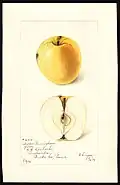 |
Pa. US | <1875 | A small yellow apple. Flesh yellow, juicy, subacid. Use September. | Eating |
| Sturmer Pippin[370][6][8][21] | 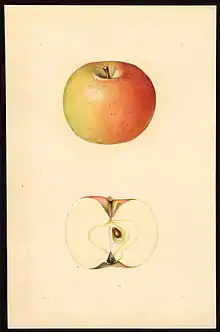 |
Sturmer,Haverhill, Suffolk, England | <1831 | A bright greenish-yellow apple with a reddish-brown blush, often on one face only. W 69, H 62. Stak 12–25 mm. Flesh white, crisp, juicy, subacid, aromatic. One of the best English keeping apples, with proper storage Sturmer Pippin lasts 4 to 5 months. Flavour is sprightly, more sharp than sweet when first picked, but improves dramatically in storage, becoming sweeter and richer, while maintaining its crisp texture. This keeping ability made it ideal for long journeys, as such, it was brought to Australia where it is still widely grown. Parent of Granny Smith. Pick mid October. Use January - April. | Eating |
| Suislepper[13] | Estonia | <1870 | Flesh soft and aromatic. W 70, H 70. Pick September. Use September. | Eating | |
| Šumatovka(syn. Popadija)[11] | Serbia | <1900 | A yellow apple with red flush. W 67, H 57. We 117. Stalk 23 mm. Flesh white, firm, crisp, sweet, subacid. Tree extremely vigorous. Pick October. Use November - January. | Eating, Cooking | |
| Summer Bellflower[28] | 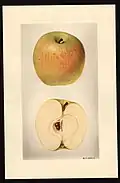 |
New York, US | <1848 | Flesh tender, subacid, good. P Esopus Spitzenburg x unknown. | Eating |
| Summerfree | Italy | 1998 | Resistant to scab. Spreading habit with moderate vigour, fruit is large, average weight of 175 g, skin is smooth, ripens 1–2 days before Gala, good storage ability. | Eating | |
| Summer Golden Pippin[6] | England | <1800 | A small apple, ripe in the end of August. Richer flavour than Yellow Ingestrie. H54, W51. The tree is a small grower. It is an early and abundant bearer. | Eating | |
| Summer Pearmain American(syn. Early Summer Pearmain)[59][79] | 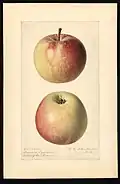 |
US | <1817 | Greenish yellow with red overcolour. W 75, H 68. Stalk 23 mm. Flesh yellowish, juicy, aromatic, mild, subacid. Use August - September. | Eating |
| Summer Pippin[3] | 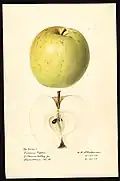 |
US | <1800 | Flesh white, tender, juicy, subacid. W 78, H 70. Use August - September. | Cooking |
| Summer Pound Royal(syn. Pound Royale, Orange)[3] | 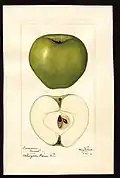 |
US | <1800 | Flesh white, tender, juicy, subacid. W 85, H 71. Stalk 20mm. Use August - September. Tree is a strong grower. | Eating |
| Summer Queen[4] | 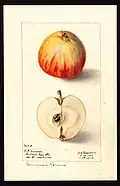 |
US | <1806 | W 68, H 60. Stalk 33 mm. Flesh yellow, acid, spicy, aromatic. Use July - August. | Cooking |
| Summerred[14][8] | 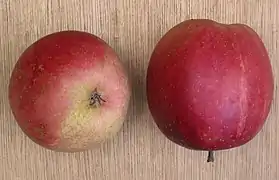 |
British Columbia, Canada | 1964 | Red apple. W 67 H 67. P(McIntosh x Golden Delicious) x unknown. Flesh white, soft, juicy. Pick early September, Use September - October. | Eating |
| Summer Rose[4] | 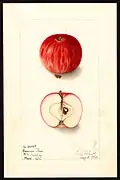 |
New Jersey | <1806 | A small apple. One of the best early apples. Flesh white, juicy, subacid. Use June - August. | Cooking, Eating |
| Summer Spitzenburg[28] | 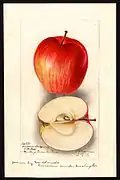 |
New York, US | <1872 | Flesh, juicy, aromatic, good to very good. Biennial. Pick August. Use August - September. | Eating |
| Sunset agm[371][21] |  |
England | 1918 | Easy to grow. W 61, H 51. Stalk 15 – 22 mm. Has very similar flavour to Cox's Orange Pippin. Won't do well in heat. Pick late September. Use October - December. | Eating |
| Suntan[372][21] | 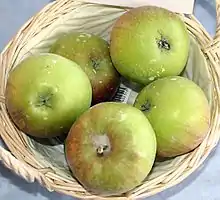 |
Kent, England | 1956 | Fruits ripen orange-red, flavour is sharp and intense. W 70, H 54. Stalk 15 – 20 mm. Pick mid October. Use November - January. | Eating |
| Superior[5] | Michigan, US | Introduced 1930 | P Duchess x Wealthy. Use - December. | Eating | |
| Surprise[3] | 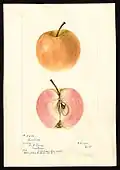 |
US ? | ? | A small apple. Flesh stained with red. Use November - January. | Eating |
| Sutton Beauty[3] | 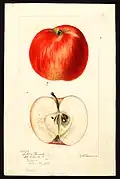 |
Sutton, Massachusetts | c. 1757 | Flesh whitish, crisp, tender, juicy, subacid. Use November - February. | Eating |
| Swaar(syn. Hardwick)[3][28][373] | 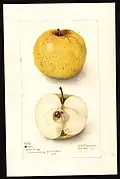 |
New York, US | <1800 | W 78, H 61. Stalk 19–26 mm. Flesh yellowish, tender, aromatic, spicy, very good to best. Use December - March. | Eating |
| Sweet Bough[59][374] |  |
US | <1806 | One of the finest summer apples, greenish-yellow. Flesh white, juicy, slightly aromatic, good to very good. Use August - September. AC s. | Eating |
| Sweet Delicious[5] | 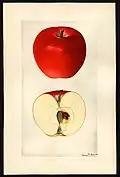 |
Geneva, New York, US | Introduced 1922 | P Deacon Jones x Delicious. | Eating, Baking |
| Sweet McIntosh[5] | 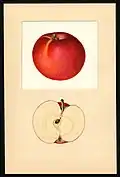 |
Geneva, New York, US | Introduced 1922 | P Lawver x McIntsosh. | Eating, Baking |
| Sweet Pippin[3] | 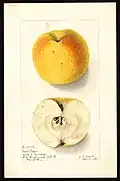 |
US | <1830 | Stalk short. Flesh juicy, sweet. Tree productive. Use November - December | Eating |
| Sweet Pippin syn. of Moore Sweet | |||||
| Sweet Pippin syn. of Hog Island Sweet | |||||
| Sweet Romanite[4] | 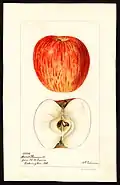 |
US | <1850 | W 74, H 61. Stalk 15 mm. Flesh yellow, juicy, very sweet. Use December - April. | Baking, Cider, Eating |
| Sweet Russet[4] | 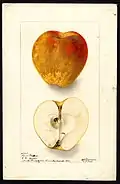 |
US | <1850 | W 74, H 62. Stalk 11 mm. Flesh yellow, tender, juicy, sweet. Use August. | Baking |
| Sweet Russet syn. of Pumpkin Russet | |||||
| Sweet Russet syn. of Cheeseboro | |||||
| Sweet Sixteen | Minnesota, US | 1973 | Large fruit, some russeting near top. Moderately acidic taste. | Eating | |
| SweeTango |  |
Minnesota, US | 2009 | Juicy and sweet, and viewed as a successor to the Honeycrisp by many growers. | Eating |
| Switzer[28] | 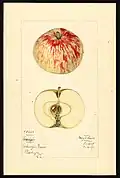 |
Russia | <1870 | Flesh white, juicy, subacid, good. Biennial. Pick August. Use September - October. | Cooking, Eating |
| Syke House Russet[7] | Yorkshire, England[6] | 1780 | One of the most excellent dessert apples. The tree is a free grower and an excellent bearer. Use: October–February | Eating | |
| Talman's Sweet see Tolman Sweet | |||||
| Talvikaneli see Vinterkanel | |||||
| Talvikki[31] | Finland | 2003 | A large green apple with red flush. P Lobo x Yläkautto. Pick mid October. | Cooking (Eating) | |
| Tamplin[7] | ? | <1900 | Crimson red with dark broken stripes. AM from RHS in 1902. Flesh yellowish, poor. | Eating | |
| Teser | United States | 1944 | Resistant to scab. | Eating | |
| Tart Bough(syn. Sour Bough)[3] | 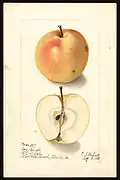 |
US | <1830 | Flesh white, tender, juicy, subacid. Use August. | |
| Tart Bough syn. of Early Harvest | |||||
| Tart Bough syn. of Champlain | |||||
| Telstar[8] | New Zeeland | 1934 | P Golden Delicious x Kidds Orange Red. W 69, H 56. Stalk long. Flesh white, crisp, juicy, sweet. Pick mid October. Use November - December. | Eating | |
| Tetofski[4][375] | 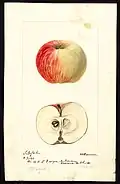 |
Russia | <1831 | A small apple. Flesh yellowish-white, firm, coarse, tender, aromatic juicy, subacid, fair to good. Use June - July | Cooking |
| Tewkesbury(syn. Tewkesbury Winter Blush)[3] | 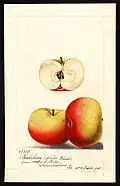 |
N.J. US | <1850 | W 60, H 45. Stalk 11 mm. Flesh yellow, subacid. Use January - July. | Eating |
| Thomas Rivers (syn. River's Codlin)[7][50] | Hertfordshire, England | <1892 | Round, conical, pale yellow with slight brownish flush, flesh crisp, yellowish, acid cooks extremely well. P Mother x Dumelow. First Class Certificate from RHS in 1892. H 64, W64. | Cooking | |
| Thompson[28] | 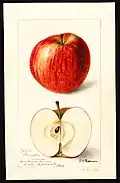 |
Iowa, US | <1892 | Flesh white, crisp, tender, juicy, subacid, fair to good. Stalk medium. Use October - December. | Eating |
| Thorle Pippin see Whorle Pippin | |||||
| Tiganka(syn. Tiganka Alaia)[11] | Moldova | <1900 | A red apple. W 73-82. H 70-75. We 80-115. Stalk short. Flesh juicy, subacid. Pick mid September. Use October - November. | Cooking (Eating) | |
| Tiganka Grie[11] | Moldova | <1900 | A green apple with red flush. W 70-85, H 70-85, We 85-125. Stalk medium to long. Flesh juicy, subacid. | Cooking (Eating) | |
| Tinmoth[28] | 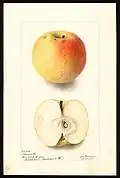 |
Vermont, US | >1857 | Flesh tender, juicy, subacid, peculiar flavor, good. Tree very productive. Use October - December. | Eating |
| Titovka(syn. Titus Apple)[28][376] | 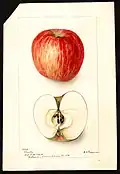 |
Russia | <1870 | Flesh white, juicy, subacid, good to very good. Tree vigorous. Use August - September. | Cooking |
| Titus Pippin[3] | 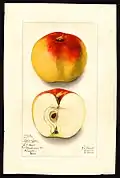 |
Long Island, US | <1870 | Flesh whitish yellow, juicy, tender, subacid.Good. Tree productive. Use December - February. | Eating |
| Tobias[31] | Finland | Introduced 2003 | A red conical apple. P Lobo x Huvitus. Pick early October. | Cooking, Eating | |
| Tolman Sweet(syn. Talman's Sweet)[377][378][379] | 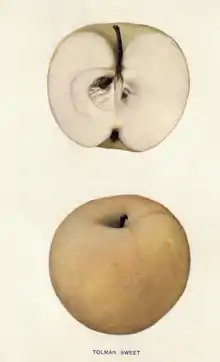 |
US | 1822 | Very sweet apple. W 79, H 67. Stalk 27 mm. Once used to make dried fruit for winter. Flesh white, firm, dry, sweet, good to very good. Use October - March. | Cider, Cooking |
| Tom Putt[21] | 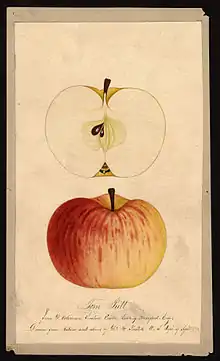 |
Trent, Dorset, England | <1800 | Small to medium, flat and irregularly shaped apple. Green, usually covered entirely with a bright red blush. H 55-63, W 65-78. Crisp, sharp flavour. An excellent cooker and ideal single-variety cider apple. Softens during storage. Tree is vigorous and precocious. Scab-resistant. Seedling found by a Rev. Tom Putt of Trent, Somerset, England in the late 1700s. Triploid. Pick early September. Use September - November. | Cider, Cooking |
| Tompkins King (or King)[380] |  |
United States | 1804? | This apple is gigantic, and of excellent quality both as a dessert fruit and for cooking. The fruit shape is uniform and the skin mostly red with some yellow stripes. The flesh is yellowish and crisp. The fruit does not keep as well as some other apple cultivars. | Eating |
| Topaz |  |
Czechoslovakia | 1990 | Rubin × Vanda, scab-resistant, sharp flavour. | Cider, Cooking, Eating |
| Tower of Glammis[6][21] | Angus, Scotland. | <1800 | A first rate culinary apple, once very popular in Lanarkshire. Greenish in colour with some russeting near stalk normal.[381] W 73, H 70. Stalk 12 – 15 mm. Triploid. Pick late October. Use November–February. | Cooking. | |
| Townsend[3] | 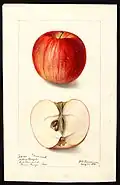 |
Pa. US | <1785 | Stalk long. Flesh white, tender, subacid, good to very good. Tree healthy, vigorous. Good to very good. Pick late August. | Eating |
| Traders Fancy[4] | 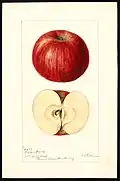 |
Pennsylvania, US | <1840 | Flesh white, crisp, tender, juicy, subacid, good to very good. Tree vigorous. Use January - May. | Cooking |
| Trajan[50] | Kent, England | Introduced 1989 | P Wijcik McIntosh x Golden Delicious. Dark red. Flesh crisp, juicy, sweet. Pick September. Use September - October. | Eating | |
| Trenton Early[4][3] | 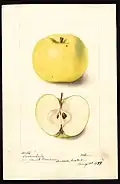 |
New Jersey, USA | Introduced 1852 | Flesh white, tender, juicy, subacid. Tree moderately vigorous, quite productive. Use August - September. | Cooking, Eating |
| Trogsta[14][19] |  |
Sweden | <1900 | W 59-71, H 50-59. Stalk 9 mm. Flesh juicy, good. Pick September. | Eating |
| Tropical Beauty[10] | South Africa | c1930 | P unknown. Flesh soft, poor. | Eating | |
| Tropic Sweet[10] | Florida | Introduced 1996 | P polycross from Jerseymac x Anna selections. W 70. One of a handful of apple varieties that will grow in Florida; will not do well in cold weather at all. | Eating | |
| Trumbull Sweet(syn. Fenton Sweet)[4] | 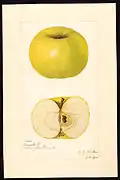 |
Ohio, US | <1850 | Flesh white, juicy, sweet. Tree vigorous, productive, early bearer. Use September - October | Baking |
| Tsáriskij schip[31] | Estonia | <1880 | Medium size conical. Yellow with red stripes. Pick September. Use September. | Cooking, Eating | |
| Tsugaru | .jpg.webp) |
Aomori, Japan | 1930 | Golden Delicious × Jonathan | Eating |
| Tufts[28] | 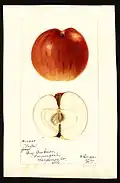 |
Wisconsin, US | 1855 | Flesh crisp, mild subacid, fair to good. Stalk long. Use October - December. | Eating |
| Tumanga (syn. Auralia)[144][18] | .jpg.webp) |
Germany | 1930 | A green apple with red flush. W 66-80, H 52, We 110-195. Pick early October. Use November - February. | Eating |
| Turley[5] | 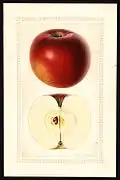 |
Indiana, US | Introduced 1922. | P Winesap x unknown. Tree bears annually, very productive. | Cooking |
| Twenty Ounce[382][59][383][384] | .jpg.webp) |
New York | <1844 | Huge: apple weighs over one pound, or nearly 500 g. Green overlaid with broad red striping. Stalk short, thick. Flesh whitish - yellow, tender, juicy, subacid, good. Excellent cooker. Nice juice qualities. Use September - October. | Cider, Cooking, Eating |
| Tydeman's Early Worcester[8][21] | England | Raised 1929 Introduced 1945 | Mclntosh × Worcester Pearmain. Crimson over yellow background colour. Flesh white, juicy, sweet with strong aroma. H 54-60, W 60-67. Stalk 17–20 mm. Pick mid August. Use August - September. | Eating | |
| Tydeman's Late Orange[8][21] | England | Raised 1930 Introduced 1949 | Good storage qualities, but loses fragrance with age. H 55, W 58. Stalk 15–25 mm. Pick mid October. Use December - April. Sometimes cultivated in California; one of a handful of British apples that will thrive in the state. | Eating | |
| Tyler's Kernel[7] | Herefordshire, England | <1883 | A pale yellow apple. W 64, H 76. FCC from RHS in 1883. Rather subject to canker. | Cooking | |
| Undine[18] | Germany | 1961 | A large apple (180-230 gram). Green with some orange overcolour. Jonathan x unknown. | Eating | |
| Utter[28] | 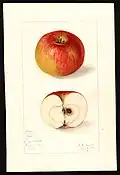 |
Wisconsin, US | 1855 | Flesh, crisp, tender, juicy, subacid, good. Tree regular grower, healthy, productive. Use October - December. | Eating |
| Uttwiler Spätlauber |  |
Switzerland | 1750 | Eating | |
| Valinhense[10] | Brazil | P unknown. Very firm tart apple. | Cooking | ||
| Valmore[5] | California, US | Introduced 1934 | P unknown. | Cooking | |
| Vance Delicious[5] | Virginia, US | Discovered 1930. Introduced 1935. | Mutation of Delicious. | Eating | |
| Vanderspiegel[3] | 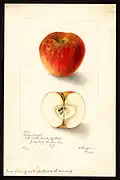 |
Bennington, Vt. US | <1875 | Flesh yellow, crisp, juicy, subacid. Tree productive. Use December -February. | Eating |
| Vandervere(syn. Large Vandervere, Vandervere Pippin, Yellow Vandervere)[4] | 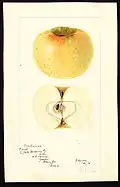 |
US | <1806 | Flesh yellow, firm, juicy, acid. Tree vigorous, productive, bearing annually. Use December. | Cooking |
| Venus Pippin[7] | Devonshire, England | ca 1800 | A pale yellow-green apple. AM from RHS in 1899. Flesh, tender, pale yellow, juicy. Use September - October. | Cooking, Eating | |
| Verorja[11] | Albania | ? | A greenish yellow apple with red stripes. W 50-60, H 50-60. We 100-120. Flesh crisp, juicy, subacid. Pick late July - Early August. | Eating | |
| Vicking[50] | S. Daktota, US | Introduced 1925 | Flesh brisk, soft, juicy. Pick late August. Use August - September. | Eating | |
| Victoria Sweet[385] | 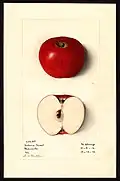 |
New York ? US | ca 1840 | A red apple. Tree vigorous. Flesh yellow, firm, tender, juicy, sweet, good to very good. Use October - January. | Eating, Cooking, Baking |
| Victory[5] | Minnesota, US | Introduced 1943 | Flesh white, juicy, aromatic. Use October 15 - March 15. | Eating | |
| Vidovdanka[11] | Serbia | <1900 | A green apple with red flush covering 85%. W 62, H 62-74. We 130. Flesh juicy, acid. Pick august. | Eating | |
| Vinterkanel(syn. Talvikaneli)[31] | Finland | Introduced 2003 | A red apple. P Lobo x Rödkanel. Pick early October. | Cooking, Eating | |
| Violette[6] | France | 1628 | A culinary apple of second rate quality. Use: October - March. | Cooking | |
| Virginia Greening[4] | 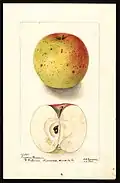 |
Virginia | <1835 | W 88. H 65. Flesh white, subacid. Use January - April. | Cooking |
| Vitgylling (syn. Virginskt Rosenäpple)[13][14] |  |
Europe | <1800 | W 69, H 60. Stalk 15 mm. Flesh sweet, subacid, fair to good. Pick late August. Use early September. | Cooking |
| Von Zuccalmaglios Rennete[18] |  |
Germany | 1878 | W 65, H 61, We 115. Picking October. Use November - March. Biennial. | Eating, Cooking |
| Vuokko[31] | Finland | Introduced 1999 | A green apple. P Melba x Huvitus. Flesh juicy, sweet, subacid. Pick late August - early September. | Cooking, Eating | |
| Vusanka[11] | Montenegro | <1900 | A greenish yellow apple with red flush. W 72, H 63. We 132. Stalk medium to long. Flesh juicy, sweet. Pick early October. Use November - April. | Eating, Cider | |
| Wadhurst Pippin[7][6] | Sussex, England | <1850 | A culinary apple of excellent quality, in use from October to February. | Cooking (Eating) | |
| Wagener[386][8][3][21][28] | 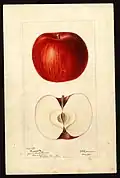 |
New York, US | 1791 | Antique American variety, known since Colonial times. Tree hardy, early bearer, scab-resistant. Green with red flush. Flesh yellowish, tender, subacid and vinous, very good to best. W 70-88. H 51-63, Stalk 13–26 mm. Keeps very well. Very versatile in kitchen; not only does it cook well, but makes a good single-variety cider. Wagener is a parent of Idared, to which it imparts its keeping and cooking qualities. Pick early October. Use November - February. | Cider, Cooking, Eating |
| Wanstall[6] | Kent, England | <1875 | A dessert apple of the first quality, equal in flavour to the Ribston Pippin and will keep till May. Flesh, yellow, firm crisp, juicy, rich, sugary, and highly flavoured. | Eating | |
| Warder[5] | Ohio, US | Introduced 1937 | P Rome Beauty x unknown. Pick October 1 in Ohio. | Eating | |
| Warner's King[34] agm[387][21] | 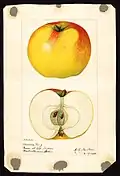 |
Kent, England | c. 1700 | Oblong and light green. Very tart. W 90-95, H 62-76. Stalk 15–20 mm. Do not attempt to eat out of hand. Pick late September. Use November - February. | Cooking |
| Washington Strawberry[3] | 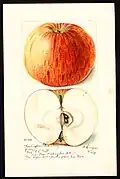 |
N.Y. US | <1849 | W 88, H 75. Stalk 16 mm. Flesh yellow, crisp, tender, juicy, brisk subacid. Pick mid September. Use September - October. | Eating |
| Washu 1984 | Japan | c. 1920 | Conical with light green skin and dark freckles, with a firm, white, bruise-resistant flesh and a sweet, low-acid flavor with tropical undertones. | Eating | |
| Water[3] | 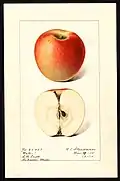 |
Pa. US | <1850 | W 70, H 70. Stalk 16 mm. Flesh white, tender, juicy, subacid. Use October - November. | Eating |
| Waterman Sweet[3] | 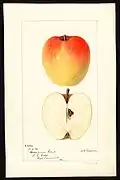 |
US | <1875 | Yellow with red flush. Flesh yellow, juicy, sweet. Use December - March. | Eating |
| Wealthy[8][21][388] | .jpg.webp) |
Minnesota, US | 1860 | Cherry Red × Sops of Wine.
Pretty reddish pink coat. Flesh white, fine, crisp, tender, very juicy, subacid, aromatic, good to very good. Believed at one time Minnesota was too cold to grow apples until "Wealthy" was cultivated. Now a parent to many apples for resistance to temperatures below freezing. Still available in upper Midwest. W 67-69, H 53-61. Stalk 18 – 22 mm. Pick mid September. Use September - December. |
Eating |
| Webster[5] | Geneva, New York, US | 1921, Introduced 1938 | P (Ben Davis x Jonathan) x (Ben Davis x Jonathan). A large red apple. Triploid. | Cooking | |
| Wedge[5] | 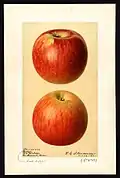 |
Minnesota, US | 1912, Introduced 1922 | P Ben Davis x unknown. A large apple. Use October - November. | |
| Well apple syn. of Domine | |||||
| Well apple syn. of Titus Pippin | |||||
| Werder Golden Reinette[7] | Potsdam, Germany | <1904 | Golden yellow striped with crimson. W 63, H 57. Tree vigorous. Flesh firm, yellowish, sweet, good. Am from RHS in 1904. | Eating | |
| Western Beauty[4] | 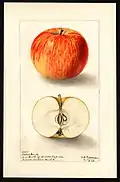 |
US | <1850 | W 89, H 74. Stalk 20 mm. Flesh light yellow, tender, juicy, vinous, subacid. Tree vigorous, productive, early bearer. Use August - December. | Cooking, Eating |
| Western Giant[5] | California, US | Introduced 1948 | A large Apple P unknown. Ripens before Red Astrachan. | ||
| Westfield Seek-No-Further(syn. Westfield)[4][389] | 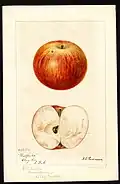 |
Westfield, Massachusetts, US | 18th century | A medium-sized conic to truncate-conic apple. W 70, H 58-63. Stalk 13-20 mm. Greenish-yellow, dull skin, flushed orange with carmine stripes, russet dots and patches. Shaded fruit are often irregularly russeted all over, with little colour showing. Flesh is light buttery-yellow, firm but tender, and moderately fine-grained. Flavour is nicely balanced, a honey-like sweetness balanced with a lemon-like citric acidity, rich, notes of pear and vanilla. Vigorous grower, some disease resistance. Use December. | Eating |
| Weisskante[34] |  |
Germany | <1850 | W66, H 66. Stalk 16 mm. Use November - March. | Cooking, Eating |
| Welschisner[390] |  |
Austria | 1659 | A greenish-yellow apple with red flush. W 75, H 62. Stalk short. Flesh whitish yellow, aromatic, subacid. Quality: eating good. Pick mid October. Use January - May. | Eating |
| Wheeler's Russet[6][391] | England | 1717 ? | Medium sized fruit, entirely covered with pale yellowish grey russet. A highly flavoured dessert apple of the first quality. Use: November–April. | Eating | |
| Whetstone[5] | 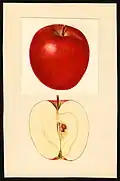 |
Missouri, US | Introduced 1935 | P Conard x Delicious. Quality fair. Tree vigorous. | |
| White Astrachan[13] | 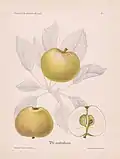 |
Sweden or Russia | <1800 | W 71, H 60. Stalk 10-15mm. | Eating |
| White Doctor[3] | 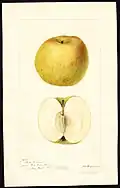 |
Pennsylvania, US | <1875 | A large greenish-yellow apple. Stalk short. Tree vigorous. Flesh white, subacid, good. Use September - October. | Cooking |
| White June see Yellow June | |||||
| White Pippin(syn. Canada Pippin)[3][392] | 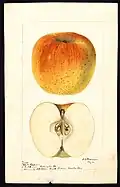 |
US or Canada | A yellow apple. W 80, H 65-70. Stalk 12-18 mm. Flesh white, crisp, juicy, subacid, very good to best. Use January - March. | Eating | |
| White Sweet[3] | 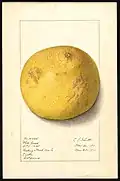 |
New Jersey, US | <1875 | Tree vigorous. Flesh white, sweet, good. Use Use September - October. | Cider, Cooking |
| White Transparent]][7][8][18][393] | 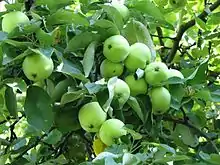 |
Latvia | 1850 | Very pale green skin. Flesh white, firm, crisp, tender, juicy, subacid, good. Fruit bruises easily and goes soft once harvested. W 55-70, H 55-68, We 85-100. AM from RHS in 1895. Pick and use July - August. | Cooking |
| White Winter Pearmain[4][3] | 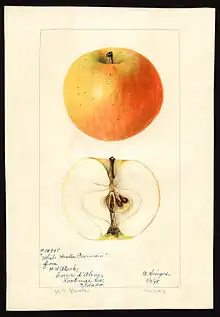 |
US | <1830 | W 74-79, H 62-73. Stalk 15–20 mm. Tree vigorous. Flesh yellow, crisp, juicy, very good. Use December - March. | Eating, Cooking |
| Whitney Russet[4] | 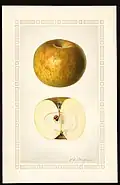 |
US | <1850 | W 67, H 52. Stalk 14 mm. Flesh grennish-yellow, juicy, subacid, aromatic, spicy. Use December - February. | Eating |
| Whorle Pippin[6] | Scotland | <1831 | Summer dessert apple of first-rate quality. Flesh firm, crisp and very juicy, with a brisk flavour. Picking August. H 51 W65. | Eating | |
| Wickham's Pearmain[6] | Hampshire, England | <1875 | A pearmain-shaped yellow apple with red overcolour on the side next the sun. H 50, W 50. Flesh, greenish yellow, crisp, juicy, and highly flavoured. An excellent dessert apple. | Eating | |
| Wickson[5] | California, US | Introduced 1944 | A red oblong apple. P Yellow Newtown x Spitzenberg crab. Flesh juicy. | Jam, Jelly, Cider | |
| Wickstrands favorit[14] |  |
Sweden | <1900 | A green apple. W 65 H 67. Stalk 16 mm. Flesh sweet. Pick October. Use October - December. | Eating |
| Wijcik McIntosh | British Columbia, Canada | Mid 1960s | Mutation of McIntosh apple that first showed columnar ornamental properties | Eating, Cooking, Ornamental | |
| Wild Twist[394] |  |
US | 2011 | Honeycrisp x Cripps Pink. Commercially available in 2020. | |
| William Crump[7][8][21] | Worcestershire, England | <1910 | High-quality, well-coloured dessert apple. Raised at Rowe's Nurseries, Worcester, England. AM from RHS in 1908. First Class Certificate from RHS in 1910. A yellow apple half covered with red flush. W 70-74, H 58-63. Stalk 13 mm. Pick mid October. Use December - February. | Eating | |
| Williams Favourite(syn. Williams, Williams Early)[7][13][28][395] | 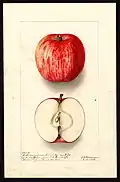 |
Massachusetts, US | c1750 | W 56-69, H 52-69. Stalk 15 mm. AM from RHS in 1895. Flesh crisp, tender, juicy, subacid, aromatic, good. Tree moderately vigorous. Pick September. Use September - November. | Eating |
| Williams Pride(syn. Co-op 23)[10] | Indiana, US | Introduced 1987 | Flesh firm, crisp, juicy, subacid. | Eating | |
| Willie Sharpe[10] | New Zealand | early 1900s | Light green, round, medium size. Flesh sweet, subacid, good. | Eating | |
| Willis Sweet(syn. Pear Lot)[3] | 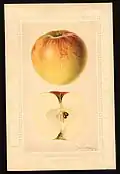 |
Long Island, US | <1850 | W 83, H 73. Stalk 22 mm. Very good. Flesh juicy, sweet. Use August - September. | (Eating, Cooking), Baking. |
| Willow Twig(syn. James River)[3][396][397] | 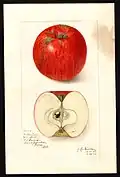 |
US | <1870 | Yellow with red flush. W 84, H 68-73. Stalk 22 mm. Flesh pleasant, subacid. Valuable for late keeping | |
| Windsor[398][399] | 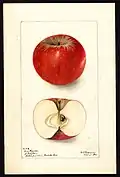 |
US | <1889 | Flesh juicy, aromatic, good to very good. Use October - March. | Eating |
| Wine[4] | 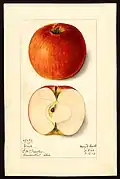 |
US | <1850 | A large apple. Flesh yellow, juicy, acid to subacid. Tree is very large. Use November - December. | Cooking, Eating |
| Winesap[400][401][402][403] | 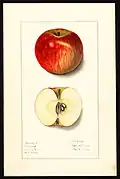 |
United States | 1817 | Sweet with tangy finish. Reddish blush flecked with some green. W 67, H 63. Stalk 17-20 mm. Flesh yellow, firm, coarse, crisp, juicy, subacid, good to very good. Use October - March. | Cider, Eating |
| Winston (Winter King) agm[404][21] | 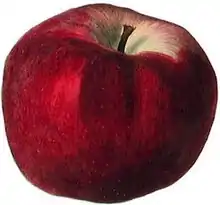 |
Berkshire, England | c. 1935 | Cox Orange × Worcester Pearmain. Originally called Winter King because of its extraordinary keeping ability, renamed during World War II for Winston Churchill. W 65, H 60. Stalk 10–18 mm. Pick mid October. Use December - April. | Eating |
| Winter Banana[8][10][405][406] |  |
Indiana, US | 1876 | Large, late dessert apple for use in December to March. Award of Merit from RHS in 1912. A golden yellow apple. 25-75% flushed with pinkish brown. W 78, H 71. Flesh yellow, firm, crisp, aromatic, juicy, mild subacid good to very good. Pick early October. Use December - March. | Eating |
| Winter Harvey[3] | 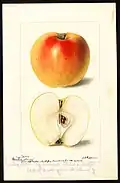 |
US | <1850 | Flesh white, tender, juicy, subacid, good. Tree vigorous. Use January - March | Eating |
| Winter Maiden's Blush[3] | 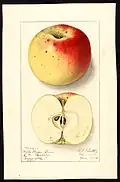 |
Pennsylvania, US | <1850 | Flesh white, crisp, tender, subacid, very good. Stalk short. | Eating |
| Winter Pearmain[6] | England | <1600 | A narrow conical ribbed apple. W 70-80, H 70-80. Stalk very short. Flesh yellow, firm crisp, juicy and a very pleasant flavour. Use December - April. | Eating, Cooking | |
| Winter Pomeroy[92] | England ? | <1850 | W 76, H 64. Stalk long. Flesh, yellow, crisp, sub-acid. Use December - January. | Cooking | |
| Winter Prinzenapfel[34] |  |
Germany | <1887 | W 69, H 69-72. Stalk 12 mm. Flesh juicy, sweet, good. Use December - March. | Eating, Cooking |
| Winter Quarrenden (syn. Stubb's Seedlin)[7] | Nottinghamshire, England | <1895 | A bright crimson apple. W 63, H 57. AM from RHS in 1895. P London Pippin x Devonshire Quarrenden. Flesh greenish-yellow, poor. Use November - December. | Eating | |
| Winter Quittenapfel[34] |  |
<1830 | W 72, H 58-60. Stalk 11 mm. Use December - April. | Cooking (Eating) | |
| Winter Quoining[92][407] | England | <1700 | W 57, H 64. Flesh greenish yellow, tender, soft, not very juicy, sugary, perfumed. Use November - May. | Cooking, Eating | |
| Winthrop Greening(syn. Lincoln Pippin, Hove Apple)[3] | 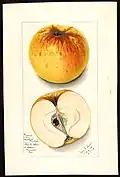 |
Winthrop, Me. US | <1875 | Stalk short. Flesh white, tender, juicy, subacid. Use September. | Eating |
| Witos[144] | Poland | ||||
| Wolf River[8][408] | .jpg.webp) |
Wisconsin, US | 1881 | Apple very large, some growing to size of large grapefruit. Red with yellow blush. Once very popular commercial apple in United States but presently relegated to upper Midwest if grown for profit. Occasionally can be found growing wild in backcountry thickets or abandoned land in Shenandoah Valley. Named for area where found. Flesh white, firm, tender, juicy, aromatic, subacid, fair to good. Feral trees can be brought back with care and pruning. W 80, H 62. Pick mid September. Use October - December. | Cooking, Eating |
| Wood's Greening(syn. Reinette Simerenko)[324] | Ukraine | <1895 | A golden yellow apple. H 54-65 W 70-78. Pick October. | Cooking, Eating | |
| Woolbroke Pippin[409] | England | Introduced 1921 | Yellow with red flush and Russet. Stalk short. AM from RHS in 1929. Flesh white, hard, sweet, aromatic. | Eating | |
| Woolbrook Russet[8][410] | Devon, England | 1903 | P Bramley x King Acre Pippin. W 84, H 67. Stalk short. Flesh white, juicy, acid. AM from RHS in 1930. Pick mid October. Use December - March. | Cooking | |
| Worcester Pearmain agm[411] |  |
Worcestershire, England | 1873 | Conical , entirely covered with scarlet. FCC from RHS in 1875. Crisp and sweet strawberry flavour when ripe. Pick early - mid September. Use September - October. W 64, H 61. | Eating |
| Wright[5] | Missouri, US | Introduced 1942 | P Ben Davis x Jonathan. Fruit large, good flavor. | Eating | |
| Wrixparent[5] | Delaware, US | Introduced 1940 | P Transparent x unknown. Ripens early. | Eating | |
| Wyken Pippin[8] | England or Netherland | <1720 | Flat round, even, greenish yellow, with delicious flavour. W 59, H 50. Pick mid October. Use November - February. | Eating | |
| Yakima Newtown[5] | Washington, US | Introduced 1949 | Mutation of Yellow Newtown. | Cooking, Cider, Eating | |
| Yates[3] | 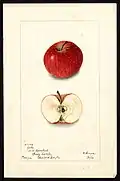 |
Georgia, US | <1865 | A small apple. Flesh white, tender, juicy, subacid, good. Use March - May. | Eating |
| Yellow Bellflower[18][4][412][413] | 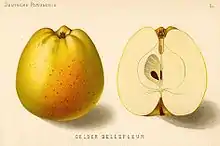 |
Burlington, New Jersey, US | <1800 | Yellow H 72-80, W 72-78, We 160. Stalk 18 – 26 mm. A favorite for baked apples. Banana flavour. Tree large, vigorous. Flesh yellow, tender, juicy, crisp, subacid, very good. Picking October. Use December–February. | Cooking, Eating |
| Yellow Forset[28] | 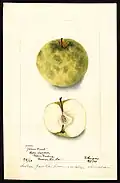 |
La. US | <1885 | Flesh white, tender, crisp, juicy, aromatic, subacid, good. Use January - June. | Eating |
| Yellow Ingestrie[7][50] | 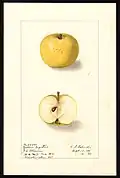 |
Shropshire, England | c1800 | Small, even, golden yellow. P Orange Pippin x Golden Pippin. Flesh firm, very juicy and delicately flavoured. H 59, W 53. | Eating |
| Yellow June(syn. White June)[3] | 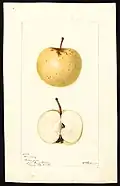 |
Southern US | <1865 | Flesh white, tender, juicy, brisk, subacid, good. Stalk long. Tree vigorous, abundant bearer. Use southern US June, Jyly, northern US August. | Eating |
| Yellow Newtown see Newtown Pippin | |||||
| Yellow Transparent see White Transparent | |||||
| Yopp(syn. Yopp's Favorite)[3] | 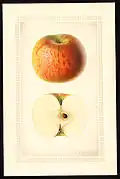 |
Georgia, US | <1857 | Flesh white, tender, juicy, subacid, good. Stalk short. Use November. | Eating |
| York[3] |  |
Massachusetts, US | <1865 | Flesh whitish, tender, juicy, subacid, good to very good. Stalk short. Use October - November. | Cooking |
| York-A-Red[5] | West Virginia, US | 1931. Introduced 1937. | Mutation of York Imperial. | Eating, Cider, Juice | |
| York Imperial[4][3][414] | 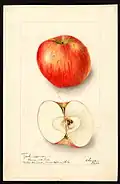 |
York, Pennsylvania, US | 1820 | Flesh yellowish, tender, juicy, subacid, aromatic. Tree healthy, productive. Preserves well, lop-sided shape. Use November - February. | Cider, Cooking, Eating |
| Yorking[5] | Pennsylvania, US | 1925. Introduced 1932. | Mutation of York Imperial | Eating, cider, juice | |
| Yorkshire Greening[7][8] | Yorkshire, England | <1803 | W 92, H 76. Stalk short to medium. Tree very dwarf. Flesh white, firm, dry, acid. Pick early October. Use November - March. | Cooking | |
| Zabergäu Renette[8] |  |
Germany | 1875 | Large russet apple somewhat like Belle de Boskoop. (128-208 gram). High in sugar 14.8%. Pick early October. Use October - March. | Eating |
| Zestar | .jpg.webp) |
Minnesota, US | 1999 | Red and greenish-yellow, round, sweet and tangy, preserves well | Cooking, Eating |
| Zimska Kolačara[11] | Serbia | <1900 | A greenish yellow apple. W 55-65, H 65-75, We 170-210. Stalk short. Flesh firm, sweet, juicy. Pick late September - early October. | Eating, Cooking, Pie | |
| Zoar Greening[3] | 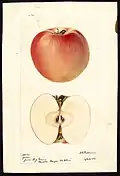 |
Ohio, US | <1865 | Flesh white, tender, juicy, subacid, good. Use November - December. | Eating |
| Ökna Lökäpple[13] | 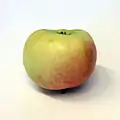 |
Sweden | <1830 | Greenish yellow with some red stripes. H 50, W64. Stalk 10 mm. Pick October. Use December - February. | Eating |
| Ökna vita Vintergylling[14] |  |
Sweden | <1900 | A small yellow conical apple. H 60, W 60. Use December - April. | Cooking, Eating. |
| Ölands Kungsäpple[64][13] | 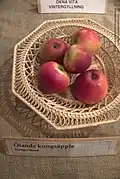 |
Sweden | <1850 | A small red conical apple for use in November–December. H 56, W 66. Stalk 8 mm. | Eating |
Cider apples
Cider apples are a variety of apples that may be far too sour or bitter for fresh eating, but are used for making cider. Some apples (especially older ones from the U.S. and Canada) are used for both cider and eating purposes. shp = sharp, swt = sweet, bswt = bittersweet, bshp = bittersharp. s = susceptible, r = resistant, AS =to apple scab, AC = apple canker, BI = bacterial infections, PM = powdery mildew, T = Triploid[3][92][415][416][6][417][50][418][53][419][420]
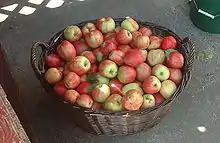
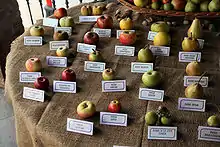
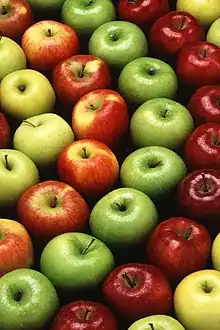
| Common name | Origin | First developed | Type | Juice titrable acidity % weight/volume | Juice specific gravity
grams/liter |
Tannin % | Days from full bloom to maturity(in S.W. England) | Disease susceptibility |
|---|---|---|---|---|---|---|---|---|
| Amanda | Somerset, England | 2007 | bswt | 0.22 | 1054 | 0.23 | 137 | |
| Angela | Somerset, England | 2007 | bsp | 0.62 | 1049 | 0.19 | 135 | |
| Antoinette | France | bswt | 0.25 | 1050 | 0.27 | sAS | ||
| Arbeya | Spain | shp | 0.57 | 0.16 | ||||
| Arbeya Montés | Spain | shp | 0.71 | 0.15 | ||||
| Armagnac | France | shp | 0.81 | 1065 | 0.17 | |||
| Ashton Bitter | Somerset, England | 1947 | bswt | |||||
| Ashton Brown Jersey | Somerset, England | 1903 | bswt | 0.14 | 1054 | 0.34 | 194 | |
| Avrolles | France | shp | 1.20 | 1055 | 0.09 | |||
| Backwell red | Somerset England | old | shp | 0.70 | 1051 | 0.13 | 172 | |
| Baldwin | Wilmington, Massachusetts, US | c. 1740 | shp | 0.74 | ||||
| Ball's Bittersweet | Herefordshire, England | 1927 | bswt | 0.28 | 0.28 | |||
| Bedan | France | bswt | 0.15 | 1056 | 0.23 | 184 | sAS | |
| Belle de Boskoop | Netherlands | 1856 | bshp | |||||
| Belle Fille de la Manche | France | swt | sAS, T | |||||
| Betty | Somerset, England | 2007 | shp | 0.90 | 1050 | 0.11 | 125 | |
| Bickington Grey | Devonshire | shp | ||||||
| Binet Blanc | France | bswt | 0.18 | 1060 | 0.25 | |||
| Binet Rouge | France | bswt | 0.18 | 1063 | 0.24 | sPM | ||
| Binet Violet | France | bswt | 0.17 | 1050 | 0.26 | |||
| Bisquet | France | bswt | 0.21 | 1045 | 0.21 | |||
| Bittenfelder | Germany | 1930s | bshp | 1.00 | 1070 | |||
| Black Dabinett | Somerset, England | bswt | ||||||
| Black Vallis | Somerset, England | T | ||||||
| Blanchet | France | shp | 0.48 | 1050 | 0.13 | |||
| Blanc Sur | France | shp | 0.67 | 1055 | 0.12 | |||
| Blanquina | Spain | shp | 0.63 | 0.09 | ||||
| Bohnapfel | Germany | <1800 | bshp | 0.55 | 1050 | |||
| Bran Rose | Herefordshire | <1880 | shp | |||||
| Breakwell's Seedling | Wales | 1890 | bshp | 0.64 | 1042 | 0.23 | 150 | |
| Broad-Leaved Hereford | England | bswt | ||||||
| Browns Apple | Devon | 1920s | shp | 0.67 | 191 | |||
| Brown Snout | Herefordshire, England | c. 1850 | bswt | 0.24 | 1053 | 0.24 | 176 | |
| Brown Thorn (syn. Argile Grise) | bswt | |||||||
| Broxwood Foxwhelp | England | 1920 | bshp | 1.91 | 0.22 | |||
| Bulmer's Norman | France | <1890 | bswt | 0.24 | 1053 | 0.27 | 165 | T |
| Burrowhill Early | Somerset, England | bswt | ||||||
| Buttery d´Or | Dorset, England | shp | ||||||
| Börtlinger Weinapfel | Germany | 1827 | bshp | |||||
| Cadbury(syn. Royal Wildling) | Somerset, England | swt | ||||||
| Calabaza | Spain | shp | 0.77 | 0.14 | ||||
| Campfield | New Jersey, US | <1817 | bswt ? | |||||
| Campillo | Spain | shp | 0.52 | 0.11 | ||||
| Cap of Liberty | Somerset, England | bshp | 0.82 | 1052 | 0.21 | |||
| Captain Broad | Cornwall, England | bswt | T | |||||
| Cartigny | France | bswt | 0.21 | 1051 | 0.22 | |||
| Casado | Spain | shp | 0.98 | 0.19 | ||||
| Cazo Jaune | France | bshp | 1.31 | 1054 | 0.33 | |||
| Chaperonnais | France | bswt | ||||||
| Charlepitré | France | swt | ||||||
| Cherry Norman | Herefordshire | <1880 | bswt | |||||
| Cherry Pearmain | Herefordshire | shp | ||||||
| Chevalier Jaune | France | bswt | 0.22 | 1053 | 0.38 | |||
| Chisel Jersey(syn. Bitter Jersey) | Somerset, England | <1900 | bswt | 0.22 | 1059 | 0.40 | 194 | |
| C`Huero Briz | France | bswt | 0.21 | 1056 | 0.47 | |||
| Cider Ladies Finger | Somerset, England | shp | 0.59 | 1052 | ||||
| Cidor | France | bswt | 0.17 | 1055 | 0.40 | sAS | ||
| Clara | Spain | swt | 0.21 | 0.19 | ||||
| Clos Renaux | France | bswt | 0.25 | 1052 | 0.22 | |||
| Clozette Douce | France | bswt | 0.22 | 1054 | 0.23 | |||
| Coat Jersey | Somerset, England | bswt | ||||||
| Coleman's Seedling | Devonshire | shp | ||||||
| Collaos | Spain | shp | 0.62 | 0.11 | ||||
| Collington Big Bitters | bswt | 0.21 | 0.21 | T | ||||
| Coloradona | Spain | swt | 0.15 | 0.13 | ||||
| Corset Hill | Gloucestershire, England | shp | ||||||
| Court Royal(syn. Sweet Blenheim) | England | swt | 0.21 | 1050 | 0.11 | 195 | T | |
| Crimson King | Somerset, England | <1900 | shp | 0.6 | 1044 | 0.13 | 195 | T |
| Cristalina | Spain | shp | 0.46 | 0.066 | ||||
| Cul Plat | France | bswt | ||||||
| Cummy Norman | Radnorshire, Wales | <1876 | bswt | |||||
| Dabinett | Somerset, England | late 19th century | bswt | 0.18 | 1057 | 0.29 | 180 | |
| Debbie | Somerset, England | 2007 | shp | 0.9 | 1050 | 0.08 | 110 | |
| De La Riega | Spain | shp | 0.58 | 0.11 | ||||
| Diot Roux | France | shp | 0.98 | 1052 | 0.18 | |||
| Dolores | Spain | shp | 0.54 | 0.07 | ||||
| Domaines | France | bswt | 0.21 | 1067 | ||||
| Douce Coetligné | France | swt | 0.19 | 1051 | 0.18 | sPM, sBI | ||
| Douce Moen | France | bswt | 0.21 | 1061 | 0.24 | sAS, sPM, sAC, sBI | ||
| Doux au Gober | France | swt | ||||||
| Doux Eveque Jaune | France | swt | 0.16 | 1052 | 0.20 | |||
| Doux Joseph | France | bswt | 0.21 | 1058 | 0.36 | |||
| Doux Lozon | France | bswt | 0.14 | 1053 | 0.21 | |||
| Doux Normandie | France | swt | 0.16 | 1065 | 0.14 | |||
| Doux Veret de Carrouges | France | swt | ||||||
| Dove | Somerset, England | <1899 | bswt | 0.22 | 1049 | 0.31 | 168 | |
| Dufflin | Devonshire | swt | ||||||
| Dunkerton's Late Sweet | Somerset, England | swt | ||||||
| Durón Arroes | Spain | shp | 0.52 | 0.12 | ||||
| Durón Encarnado | Spain | shp | 0.75 | 0.10 | ||||
| Durona Tresali | Spain | shp | 0.77 | 0.14 | ||||
| Dymock Red | Gloucestershire, England | <1800 | bshp | 1052 | 0.22 | 149 | ||
| Early Bird | bswt | 0.21 | 1052 | 0.55 | ||||
| Eggleton Styre | Herefordshire, England | 1847 | swt | |||||
| Ellis Bitter | Newton St. Cyres, Devon, England | c. 1850 | bswt | 0.20 | 1053 | 0.24 | 157 | |
| Engelsberger | Germany | ? | ||||||
| Fair Maid of Taunton(syn. Moonshines) | Somerset | shp | ||||||
| Filbarrel | Somerset, England | bswt | 180 | |||||
| Fiona | Somerset, England | 2007 | shp | 0.69 | 1049 | 0.15 | 125 | |
| Four Square | England | shp | T | |||||
| Foxwhelp | Gloucestershire, England | c. 1600 | shp | |||||
| Frederick | Monmoutshire, Wales | 1800s | shp | 1.02 | 1048 | 0.09 | 190 | |
| Fréquin Audievre | 168 | |||||||
| Fréquin Rouge | France | bswt | 0.24 | 1065 | 0.51 | sAS, sAC | ||
| Fresnosa | Spain | shp | 0.67 | 0.11 | ||||
| Fuentes | Spain | shp | 0.75 | 0.11 | ||||
| Gehrers Rambour | Germany | 1885 | bshp | |||||
| Gesnot | France | shp | 0.65 | 1049 | 0.11 | |||
| Gilly | Somerset, England | 2007 | bshp | 0.54 | 1053 | 0.18 | 125 | |
| Golden Ball | Devonshire | shp | ||||||
| Golden Russet | US | <1850 | shp | 0.55 | ||||
| Great Britain | Devonshire | shp | ||||||
| Green Bittersweet | Devonshire | bswt | ||||||
| Guillevic | France | shp | 0.58 | 1059 | 0.135 | |||
| Hagloe Crab | Gloucestershire, England | <1880 | shp | |||||
| Hangdown(syn. Pocket Apple) | Somerset or Devonshire, England | bswt | 0.20 | 1056 | 0.28 | 161 | ||
| Harrison | New Jersey, US | 1770 | shp | 0.60 | 0.15 | |||
| Harry Masters Jersey | Somerset, England | <1900 | bswt | 0.20 | 1056 | 0.32 | 172 | |
| Hastings | Somerset, England | 2007 | bswt | 0.13 | 1057 | 0.29 | 120 | |
| Hauxapfel | Germany | 1920 | bshp | |||||
| Helens's Apple | Somerset, England | 2007 | bswt | 0.10 | 1050 | 0.29 | 142 | |
| Hereford Broadleaf | Herefordshire, England | T | ||||||
| Honeystring | Somerset | swt | ||||||
| Improved Dove | England | early 1900s | bswt | |||||
| Improved Lambrook Pippin | Somerset, England | <1960 | shp | |||||
| Improved Redstreak | England | <1940 | bshp | |||||
| Jane | Somerset, England | 2007 | bsw | 0.19 | 1052 | 0.33 | 118 | |
| Jaune de Vitré | France | shp | 0.88 | 1060 | ||||
| Jeanne Renard | France | bswt | 0.17 | 1065 | 0.42 | rBI | ||
| Joanna | bswt | 0.11 | 1045 | 0.22 | 128 | |||
| Judaine | France | shp | 0.67 | 1053 | 0.075 | sAS | ||
| Judeline | France | shp | 0.50 | 1050 | 0.07 | sAS | ||
| Judin | France | shp | 0.66 | 1060 | 0.09 | |||
| Judor | France | shp | 0.67 | 1052 | 0.07 | sAC | ||
| Juliana | France | shp | 1.03 | 1061 | 0.18 | |||
| Jurella | France | shp | 0.85 | 1053 | 0.06 | sAS | ||
| Kaiser Wilhelm | Germany | 1864 | bshp | 0.63 | 1055 | |||
| Kardinal Bea | Germany | ? | ||||||
| Kermerrien | France | bswt | 0.15 | 1062 | 0.43 | |||
| Kingston Bitter | 168 | |||||||
| Kingston Black(syn. Black Taunton) | Near Taunton, Somerset, England | late 19th century | bshp | 0.58 | 1061 | 0.19 | 182 | |
| Knotted Kernel | Somerset, England | <1842 | bswt | 0.24 | 1059 | 0.34 | 188 | |
| Lagar | Spain | bshp | 0.60 | 0.22 | ||||
| Lambrook Pippin | Somerset, England | shp | 0.58 | 1054 | 0.24 | |||
| Langworthy (syn. Wyatt's Seedling) | England | shp | ||||||
| Lavignée (syn. Belle de Douai) | bswt | 0.21 | 1049 | 0.27 | 182 | |||
| Le Bret | England ? | swt | ||||||
| Limón Montés | Spain | shp | 0.81 | 0.12 | ||||
| Lin | Spain | bshp | 0.71 | 0.24 | ||||
| Lizzy | Somerset, England | 2007 | bswt | 0.17 | 1047 | 0.20 | 128 | |
| Locart Vert | France | shp | sPM | |||||
| Lorna Doone | Somerset | shp | ||||||
| Loroñe | Spain | shp | 0.61 | 0.19 | ||||
| Loroñesa | Spain | shp | 0.55 | 0.16 | ||||
| Maggie | Somerset, England | 2007 | shp | 0.58 | 1052 | 0.14 | 125 | |
| Major | England | bswt | 0.18 | 1054 | 0.41 | 150 | ||
| Marialena | Spain | |||||||
| Marie Ménard | France | bswt | 0.22 | 1061 | 0.48 | |||
| Mariñana | Spain | shp | 0.60 | 0.11 | ||||
| Marin Onfroy | France | bswt | 0.17 | 1059 | 0.325 | |||
| Maundy | England | bswt | ||||||
| Meana | Spain | shp | 0.66 | 0.19 | ||||
| Médaille D´Or | France | <1850 | bswt | 0.27 | 1059 | 0.64 | 177 | |
| Meriennet | France | bswt | ||||||
| Mettais | France | bswt | 0.17 | 1063 | 0.38 | |||
| Merton Russet | Surrey, England | 1921 | shp | 0.82 | ||||
| Michelin | France | 1872 | bswt | 0.25 | 1050 | 0.23 | 172 | |
| Miyares | Spain | shp | 0.48 | 0.15 | ||||
| Montoto | Spain | shp | 0.57 | 0.155 | ||||
| Morgan Sweet | Somerset, England | swt | 0.22 | 1049 | 0.13 | 125 | T | |
| Moulin á Vent | France | bswt | 0.26 | 1061 | 0.27 | |||
| Muscadet de Dieppe | France | bswt | 0.21 | 1055 | 0.25 | T | ||
| Naomi | Somerset, England | 2007 | swt | 0.28 | 1041 | 0.17 | 135 | |
| Nehou | France | <1920 | bswt | 0.17 | 1057 | 0.60 | 150 | |
| Neverblight | Somerset | shp | ||||||
| Newtown Pippin | Queens County, New York, US | c. 1750 | ||||||
| No Prieta Antigua | Spain | swt | 0.10 | 0.086 | ||||
| Northwood | Devon, England | c1800 | swt | 0.27 | 1049 | 0.17 | 182 | |
| Norton Bitter | Somerset | shp | ||||||
| Obdulina | Spain | swt | 0.37 | 0.155 | ||||
| Omont | France | bswt | 0.19 | 1063 | 0.22 | T | ||
| Orange Pippin | France or UK | <1800 | ||||||
| Osier | England | bswt | ||||||
| Paignton Marigold | Devon England | <1834 | bswt | |||||
| Panquerina | Spain | shp | 0.55 | 0.12 | ||||
| Paraguas | Spain | swt | 0.31 | 0.09 | ||||
| Parda Blanquera | Spain | shp - bshp | 0.71 | 0.20 | ||||
| Parda Carreño | Spain | shp | 0.57 | 0.10 | ||||
| Pardona | Spain | shp | 0.93 | 0.12 | ||||
| Peau de Chien | France | bswt | 0.22 | 1065 | 0.30 | sBI | ||
| Pennard Bitter | Somerset, England | <1900 | bswt | |||||
| Pepa | Spain | swt | 0.21 | 0.10 | ||||
| Perezosa | Spain | shp | 0.55 | 0.075 | ||||
| Perico | Spain | shp | 0.59 | 0.12 | ||||
| Pethyre | Monmoutshire, Wales | 1920s | bswt | |||||
| Petit Amer | France | bswt | 0.20 | 1055 | 0.44 | |||
| Petit Jaune | France | shp | 0.74 | 1055 | 0.12 | sAS, rBI | ||
| Pomme de Bouet | France | shp | ||||||
| Ponsford | Devonshire | <1880 | shp | |||||
| Porters Perfection | Somerset, England | <1900 | bshp | 0.82 | 1054 | 0.25 | 199 | |
| Pound | Devonshire | swt | ||||||
| Poveshon | Essex County, New Jersey, US | 18th century | ||||||
| Prieta | Spain | shp | 0.58 | 0.10 | ||||
| Prince William | England | 2007 | bswt | 0.15 | 1057 | 0.25 | ||
| Queue Torte | France | swt | ||||||
| Rambault | France | shp | 0.64 | 1061 | 0.14 | |||
| Rawlings | Devonshire | swt | ||||||
| Raxao | Spain | shp | 0.78 | 0.08 | ||||
| Red Jersey(syn. Loral Drain) | Somerset, England | 1895 | bswt | 0.63 | 1052 | 0.48 | 143 | |
| Red Norman | Herefordshire | <1880 | bswt | |||||
| Redstreak | Herefordshire, England | c. 1630 | shp or bshp | |||||
| Red Worthy | Somerset | bswt | ||||||
| Regona | Spain | shp | 1.07 | 0.145 | ||||
| Reine des Hatives | Normandy, France | 1872 | bswt | 0.24 | 0.27 | |||
| Reine des Pommes | France | bswt | 184 | |||||
| Reineta Encarnada | Spain | shp | 0.55 | 0.11 | ||||
| Reinette Obry | 167 | |||||||
| Rénao | France | shp | ||||||
| René Martin | France | shp | 0.76 | 1053 | 0.14 | |||
| Repinaldo Gozón | Spain | swt | 0.32 | 0.08 | ||||
| Repinaldo Hueso | Spain | shp | 0.61 | 0.13 | ||||
| Rouge Duret | France | swt | 0.17 | 1049 | 0.16 | |||
| Rousse de la Sarthe | France | swt | 0.17 | 1056 | 0.16 | |||
| Roxbury Russet | Massachusetts, US | c. 1640s | shp | 0.71-0.80 | 0.11 | |||
| Royal Jersey | Somerset, England | bswt | ||||||
| Royal Somerset(Copas) | Somerset | shp | ||||||
| Royal Wilding | Herefordshire, England | bswt | 0.23 | 1053 | 0.24 | |||
| Saint Martin | France | bswt | 0.20 | 1055 | 0.23 | |||
| Sebin Blanc | France | shp | 0.54 | 1051 | 0.14 | |||
| Severn Bank | England | shp | ||||||
| Sherrington Norman | bshp | 0.27 | 1051 | 0.33 | 167 | |||
| Sibirian Bittersweet | England | c1810 | ||||||
| Sibirian Harvey | England | 1807 | ||||||
| Silver Cup | Somerset | bswt | ||||||
| Slack-ma-Girdle | Devon, England | 18th century | swt | 0.27 | 1052 | 0.14 | ||
| Solarina | Spain | shp | 0.55 | 0.16 | ||||
| Somerset Redstreak | Somerset, England | <1917 | bswt | 0.19 | 1050 | 0.35 | 148 | |
| Spicey Pippin | Devonshire | shp | ||||||
| Stable Jersey | Somerset, England | bswt | ||||||
| Stead's Kernel | Herefordshire, England | <1875 | ||||||
| Stembridge Cluster | Somerset, England | bshp | ||||||
| Stembridge Jersey | Somerset, England | c1950 | bswt | |||||
| Stoke Red | Rodney Stoke, Somerset, England | <1920 | bshp | 0.64 | 1052 | 0.31 | 191 | |
| Strawberry Norman | Herefordshire, England | <1900 | bswt | 0.32 | 1053 | 0.36 | T | |
| Styre | Forest of Dean, England | before 1600 | ||||||
| Sugar Loaf | Devonshire | swt | ||||||
| Sugar Sweet | Devonshire | swt | ||||||
| Sweet Alford | Devon, England | swt | 0.22 | 1052 | 0.15 | 174 | ||
| Sweet Bramley | Devonshire | swt | ||||||
| Sweet Coopin | Devon, England | <1800 | swt | 0.20 | 1052 | 0.14 | 178 | |
| Tale Sweet | Devonshire, England | swt | ||||||
| Tan Harvey | Cornwall, England | bswt | ||||||
| Tardive de la Sarthe | France | bswt | 0.20 | 1059 | 0.37 | |||
| Tardive Forestiere | France | <1900 | bswt | 183 | ||||
| Taylor's Sweet(syn. Taylor's) | Somerset, England | <1900 | swt-bswt | |||||
| Teórica | Spain | shp | 0.80 | 0.08 | ||||
| Tesniére | Franc | shp | 0.56 | 1055 | 0.16 | |||
| Three Counties | Somerset, England | 2007 | bswt | 0.20 | 1056 | 0.30 | 137 | |
| Tina | Somerset, England | 2007 | bswt | 0.18 | 1055 | 0.25 | 125 | |
| Tom Putt | England | shp | 0.65 | 1052 | 0.13 | 120 | T | |
| Tremlett's Bitter | Exe Valley, England | c. 1820 | bswt | 0.27 | 1052 | 0.34 | 174 | |
| Upright French | Dorset, England | bswt | ||||||
| Vagon Archer | England | bswt | ||||||
| Verdialona | Spain | swt | 0.34 | 0.09 | ||||
| Vicky | Somerset, England | 2007 | swt | 0.15 | 1050 | 0.14 | 125 | |
| Vilberie | France | <1900 | bswt | 169 | T | |||
| Weisser Trier Weinapfel | Germany ? | <1890 | bshp | 0.84 | ||||
| Welschisner | Germany or Austria | ? | ||||||
| Whimple Queen | Devonshire | swt | ||||||
| Whimple Wonder | Devonshire | swt | ||||||
| White Close Pippin | Somerset or Devonshire, England | bswt | ||||||
| White Jersey | Somerset, England | 1895 | bswt | 0.29 | 1051 | 0.26 | ||
| White Norman(syn. White Hereford) | Herefordshire, England | <1900 | bswt | 0.20 | 1056 | 0.32 | 155 | |
| Winesap | US | c. 1817 | bshp | 0.51 | ||||
| Winter Banana | Indiana, US | 1876 | swt | 0.41 | ||||
| Winterrambour | Germany | 1864 | bswt | 0.36 | ||||
| Woodbine(syn. Rice's Jersey) | Somerset, England | swt | 0.29 | 1052 | 0.15 | |||
| Woodcock | Gloucestershire, England | c. 1600 | ||||||
| Xuanina | Spain | shp | 0.75 | 0.10 | ||||
| Yarlington Mill | Somerset, England | 1898 | bswt | 0.22 | 1052 | 0.32 | 183 | |
| Yellow Elliot | England | <1700 | ||||||
| Yeovil Sour | Yeovil, Somerset, England | c. 1824 | bshp | 0.55 | 1052 | 0.15 |
Rootstock cultivars
Selection of rootstock cultivars can be difficult: vigorous roots tend to give trees that are healthy but grow too tall to be harvested easily without careful pruning, while dwarfing rootstocks result in small trees that are easy to harvest from, but are often shorter-lived and sometimes less healthy. Most modern commercial orchards use one of the "Malling series" (aka 'M' series), introduced or developed by the East Malling Research Station from the early 20th century onward. However, a great deal of work has been done recently introducing new rootstocks in Poland, the U.S. (Geneva), and other nations. The Polish rootstocks are often used where cold hardiness is needed. The Geneva series of rootstocks has been developed to resist important diseases such as fireblight and collar rot, as well as for high fruit productivity.
See also
| Wikimedia Commons has media related to Apple cultivars. |
References
- Elzebroek, A.T.G.; Wind, K. (2008). Guide to Cultivated Plants. Wallingford: CAB International. p. 27. ISBN 978-1-84593-356-2.
- "AGM Plants - Ornamental" (PDF). Royal Horticultural Society. July 2017. p. 63. Retrieved 2 April 2018.
- Downing, Fruits and Fruit-Trees of America, 1885
- Warder, American Pomology
- Brooks, Register of New Fruit, 1952
- Robert Hogg, The Fruit Manual, 1875.
- Bunyard, Hardy Fruits, 1920
- John Bultitude, Apples, 1983
- Deutschlands Obstsorten
- Erez, Temperate Fruit Crops
- Balkan Pomology Apples, 2012
- Farbatlas Obstsorten, 1995
- C.G. Dahl, Pomologi, 1929
- A. Nilsson, Våra äpplesorter, 1986
- Hedrick, Systematic Pomology, 1925
- The Apples of New York, 1905
- Deutschlands Obstsorten
- Herbert Petzold, Apfelsorten, 1990
- Näslund, Svenska äpplen, 2010
- Taylor, The Apples of England, 1936
- Rosanne Sanders, The English Apple, 1988
- Hedrick, Systematic Pomology, 1925
- The Apples of New York, 1905
- Taylor, The Apples of England, 1936
- "RHS Plant Selector - Malus domestica 'Alkmene'". Retrieved 3 January 2021.
- Taylor, The Apples of England, 1936
- Taylor, The Apples of England, 1936
- The Apples of New York, 1905
- H.C. Bredsted, Haandbog i Dansk Pomologi, 1893
- Deutschlands Obstsorten
- L. Blomqvist, Äppel i norr, 2005
- Gardeners Chronicle, 1926
- Ciarallo, Annamaria (2001). Gardens of Pompeii. ISBN 9780892366293.
- Engelbrecht, Apfelsorten, 1889
- Hedrick, Systematic Pomology, 1925
- The Apples of New York, 1905
- "RHS Plant Selector - Malus domestica 'Arthur Turner'". Retrieved 3 January 2021.
- Gardeners Chronicle, 1919
- "RHS Plant Selector - Malus domestica 'Ashmead's Kernel'". Retrieved 3 January 2021.
- Deutschlands Obstsorten
- "Archived copy". Archived from the original on 2013-02-19. Retrieved 2012-12-31.
{{cite web}}: CS1 maint: archived copy as title (link) - Hedrick, Systematic Pomology, 1925
- The Apples of New York, 1905
- Warder, American Pomology
- The Apples of New York, 1905
- Taylor, The Apples of England, 1936
- Gardeners Chronicle, 1923
- Hedrick, Systematic Pomology, 1925
- J.G. Dittrch, Systematisches Handbuch der Obstkunde, 1837
- The New Book of Apples, 1993
- Deutschlands Obstsorten
- Deutschlands Obstsorten
- The New Book of Apples, 2002
- "RHS Plant Selector - Malus domestica 'Belle de Boskoop'". Retrieved 3 January 2021.
- Warder, American Pomology
- The Apples of New York, 1905
- Warder, American Pomology
- Downing, Fruits and Fruit-Trees of America, 1885
- Beach, The apples of New York, 1905
- Hedrick, Systematic Pomology, 1925
- https://harvestnursery.com/blog/product/beverly-hills-apple/
- Hedrick, Systematic Pomology, 1925
- The Apples of New York, 1905
- Håkan Svensson, Äpplen i Sverige
- Hedrick, Systematic Pomology, 1925
- The Apples of New York, 1905
- The Apples of New York, 1905
- "RHS Plant Selector - Malus domestica 'Blenhein Orange'". Retrieved 3 January 2021.
- The Apples of New York, 1905
- Deutschlands Obstsorten
- The Apples of New York, 1905
- Matthiesen, Dansk Frugt, 1913
- Hedrick, Systematic Pomology, 1925
- Hedrick, Systematic Pomology, 1925
- The Apples of New York, 1905
- "RHS Plant Selector - Malus domestica 'Bramley'". Retrieved 23 May 2013.
- "Bramley apple recipes - BBC Food". www.bbc.co.uk. Retrieved 20 August 2018.
- Deutschlands Obstsorten
- Downing, Fruit and Fruit-Trees of America, 1885
- Hedrick, Systematic Pomology, 1925
- Taylor, The Apples of England, 1936
- Downing, Fruits and Fruit-Trees of America, 1885
- Nova sorte voćaka stvorene u Čačku
- Nove sorte voćaka stvorene u Čačku
- Bultitude, Hardy Fruits, 1920
- Calhoun, Creighton Lee, Jr. "Old Southern Apples", Blacksburg, Virginia 1995, MacDonald and Woodward, (ISBN 978-0-939923-37-3), page 59
- Deutschlands Obstsorten
- The Apples of New York, 1905
- Hedrick, Systematic Pomology, 1925
- The Apples of New York, 1905
- "Malus domesticus 'Charles Ross'". RHS. Retrieved 6 January 2021.
- Hogg, The Fruit Manual, 1884
- Gardeners Chronicle, 1904
- Gardeners Chronicle, 1917
- Hedrick, Systematic Pomology, 1925
- The Apples of New York, 1905
- Svensson, Äpplen i Sverige, 2003
- Hedrick, Systematic Pomology, 1925
- The Apples of New York, 1905
- Hedrick, Systematic Pomology, 1925
- The Apples of New York, 1905
- Hedrick Systematic Pomology, 1925
- Hedrick, Systematic Pomology, 1925
- The Apples of New York, 1905
- The Apples of New York, 1905
- Deutschlands Obstsorten
- The Apples of New York, 1905
- Gardeners Chronicle, 1912
- "Malus domestica 'D'Arcy Spice'". RHS. Retrieved 6 January 2021.
- Hedrick, Systematic Pomology, 1925
- The Apples of New York, 1905
- "RHS Plant Selector - Malus domestica 'Delcorf'". Retrieved 23 May 2013.
- The Apples of New York, 1905
- "RHS Plant Selector - Malus domestica 'Discovery'". Retrieved 3 January 2021.
- Warder, American Pomology
- The Apples of New York, 1905
- "RHS Plant Selector - Malus domestica 'Dummellor's Seedling'". Retrieved 3 January 2021.
- "Plant details > Search for AGM plants / RHS Gardening". apps.rhs.org.uk. Retrieved 20 August 2018.
- H. V. Taylor, Apples of England, 1948
- Hedrick, Systematic Pomology, 1925
- Downing, Fruits and Fruit-Trees of America, 1885
- The Apples of New York, 1905
- Warder, American Pomology
- Hedrick, Systematic Pomology, 1925
- Warder, American Pomology
- Hedrick, Systematic Pomology, 1925
- The Apples of New York, 1905
- The Apples of New York, 1905
- Warder, American Pomology
- Hedrick, Systematic Pomology, 1925
- Taylor, The Apples of England, 1936
- "RHS Plant Selector - Malus domestica 'Edward VII'". Retrieved 3 January 2021.
- Taylor, The Apples of England, 1936
- Gardeners Chronicle, 1915
- "RHS Plant Selector - Malus domestica 'Egremont Russet'". Retrieved 3 January 2021.
- Taylor, The Apples of England, 1936
- Taylor, The Apples of England, 1936
- "RHS Plant Selector - Malus domestica 'Ellison's Orange'". Retrieved 3 January 2021.
- Gardeners Chronicle, 1917
- "RHS Plant Selector - Malus domestica 'Elstar'". Retrieved 3 January 2021.
- Taylor, The Apples of England 1936
- "RHS Plant Selector - Malus domestica 'Emneth Early'". Retrieved 3 January 2021.
- Smith, National Apple register of the U.K., 1971
- Obstsorten Atlas, 1996
- Warder, American Pomology
- Hedrick, Systematic Pomology, 1925
- The Apples of New York, 1905
- The Apples of New York, 1905
- The Apples of New York, 1905
- Downing, Fruits and Fruit-Trees of America, 1885
- Downing, Fruits and Fruit-Trees of America, 1885
- Hedrick, Systematic Pomology, 1925
- "RHS Plant Selector - Malus domestica 'Falstaff'". Retrieved 3 January 2021.
- Bunyard Hardy Fruits, 1920
- Hedrick, Systematic Pomology, 1925
- Hedrick, Systematic Pomology, 1925
- The Apples of New York, 1905
- "RHS Plant Selector - Malus domestica 'Fiesta'". Retrieved 3 January 2021.
- The Apples of New York, 1905
- "RHS Plant Selector - Malus domestica 'Fortune'". Retrieved 3 January 2021.
- Esther Deutsch (15 November 2017). "The Apple of My I". Ami. No. 342. p. 102.
- "RHS Plant Selector - Malus domestica 'George Neal'". Retrieved 3 January 2021.
- Illustrirtes Handbuch der Obstkunde, 1859
- Hedrick, Systematic Pomology, 1925
- The Apples of New York, 1905
- The Apples of New York, 1905
- Hedrick, Systematic Pomology, 1925
- The Apples of New York, 1905
- "RHS Plant Selector - Malus domestica 'Golden Delicious'". Retrieved 3 January 2021.
- Hedrick, Systematic Pomology, 1925
- "RHS Plant Selector - Malus domestica 'Golden Noble'". Retrieved 3 January 2021.
- Hedrick, Systematic Pomology, 1925
- The Apples of New York, 1905
- Hedrick, Systematic Pomology, 1925
- "'GoldRush' Apple". Retrieved 12 Dec 2017.
- Gardeners chronicle, 1896
- Warder, American Pomology
- Hedrick, Systematic Pomology, 1925
- "RHS Plant Selector - Malus domestica 'Greensleeves'". Retrieved 3 January 2021.
- "RHS Plant Selector - Malus domestica 'Grenadier'". Retrieved 3 January 2021.
- Downing, Fruits and Fruit-Trees of America, 1885
- Warder, American Pomology
- The Apples of New York, 1905
- Hedrick, Systematic Pomology, 1925
- The Apples of New York, 1905
- Deutschlands Obstsorten
- Hedrick, Systematic Pomology, 1925
- The Apples of New York, 1905
- Erwerbsobstbau, Nr 7, 1997
- Warder, American Pomology
- Hedrick, Systematic Pomology, 1925
- The Apples of New York, 1905
- Gardeners Chronicle, 1924
- Taylor, The Apples of England, 1936
- Hedrick, Systematic Pomology, 1925
- The Apples of New York, 1905
- "Hightop Sweet".
- "Description of Apple Varieties: H. Part 2".
- Taylor, The Apples of England, 1936
- Deutschlands Obstsorten
- Taylor, The Apples of England, 1936
- The Apples of New York, 1905
- Fruit varieties journal, 1965
- Hedrick, Systematic Pomology, 1925
- The Apples of New York, 1905
- Hedrick, Systematic Pomology, 1925
- The Apples of New York, 1905
- The Apples of New York, 1905
- Taylor, The Apples of England, 1936
- "Malus domestica 'Howgate Wonder'". RHS. Retrieved 6 January 2021.
- Taylor, The Apples of England, 1936
- Taylor, The Apples of England, 1936
- "RHS Plant Selector - Malus domestica 'Idared'". Retrieved 23 May 2013.
- Hedrick, Systematic Pomology, 1925
- "RHS Plant Selector - Malus domestica 'James Grieve'". Retrieved 3 January 2021.
- Downing, Fruits and Fruit-Trees of America, 1885
- Hedrick, Systematic Pomology, 1925
- The Apples of New York, 1905
- Downing, Fruits and Fruit-Trees of America, 1885
- Hedrick, Systematic Pomology, 1925
- The Apples of New York, 1905
- Hedrick, Systematic Pomology, 1925
- The Apples of New York, 1905
- "RHS Plant Selector - Malus domestica 'Jonagold'". Retrieved 3 January 2021.
- Warder, American Pomology
- The Apples of New York, 1905
- The Apples of New York, 1905
- "RHS Plant Selector - Malus domestica 'Jupiter'". Retrieved 3 January 2021.
- Kalmar Glasapple, kalmarlexikon.se, Retrieved 17 January 2016
- Deutschlands Obstsorten
- The Apples of New York, 1905
- Warder, American Pomology
- "RHS Plant Selector - Malus domestica 'Kidd's Orange Red'". Retrieved 3 January 2021.
- Taylor, The Apples of England, 1936
- Taylor, The Apples of England, 1936
- Taylor, The Apples of England, 1936
- Taylor, The Apples of England, 1936
- "RHS Plant Selector - Malus domestica 'King of the Pippins'". Retrieved 3 January 2021.
- "RHS Plant Selector - Malus domestica 'King Russet'". Retrieved 3 January 2021.
- "RHS Plant Selector - Malus domestica 'Kingston Black'". RHS. Retrieved 6 January 2021.
- Warder, American Pomology
- The Apples of New York, 1905
- Hedrick, Systematic Pomology, 1925
- Story of Lady Alice Archived 2012-01-16 at the Wayback Machine
- Gardeners Chronicle, 1925
- Warder, American Pomology
- Hedrick, Systematic Pomology, 1925
- The Apples of New York, 1905
- The Apples of New York, 1905
- "RHS Plant Selector - Malus domestica 'Lane's Prince Albert'". Retrieved 3 January 2021.
- Hedrick, Systematic Pomology, 1925
- The Apples of New York, 1905
- Warder, American Pomology
- "RHS Plant Selector - Malus domestica 'Laxton's Epicure'". Retrieved 3 January 2021.
- Taylor, The Apples of England, 1936
- Gardeners Chronicle, 1922
- Taylor, The Apples of England, 1936
- Hedrick Systematic Pomology, 1925
- Gardeners Chronicle, 1923
- Gardeners Chronicle, 1926
- Gardeners Chronicle, 1923
- Gardeners Chronicle, 1916
- "RHS Plant Selector - Malus domestica 'Lord Lambourne'". Retrieved 3 January 2021.
- Hedrick, Systematic Pomology, 1925
- The Apples of New York, 1905
- Hedrick, Systematic Pomology, 1925
- Warder, American Pomology
- The Apples of New York, 1905
- "5 types of apples, once thought extinct, are rediscovered". Associated Press. 6 March 2018.
- Hedrick, Systematic Pomology, 1925
- The Apples of New York, 1905
- Taylor, The Apples of England, 1948
- Hedrick, Systematic Pomology, 1925
- The Apples of New York, 1905
- Gardeners Chronicle , 1926
- "Malus domestica 'Mother'". RHS. Retrieved 6 January 2021.
- Hedrick, Systematic Pomology, 1925
- The Apples of New York, 1905
- Warder, American Pomology
- "Archived copy". Archived from the original on 2012-12-18. Retrieved 2012-12-19.
{{cite web}}: CS1 maint: archived copy as title (link) - "Unknown Apples Worthy of Attention - The Cloudforest Gardener Wiki". www.cloudforest.com. Retrieved 20 August 2018.
- [Santa Cruz Sentinel, June 27, 2006: "Life changes after encounter with fairy-tale horses"]
- Warder, American Pomology
- Hedrick, Systematic Pomology, 1925
- The Apples of New York, 1905
- Warder, American Pomology
- The Apples of New York, 1905
- Warder, American Pomology
- The Apples of New York, 1905
- Taylor, The Apples of England, 1936
- Taylor, The Apples of England, 1936
- Warder, American Pomology
- Hedrick, Systematic Pomology, 1925
- The Apples of New York, 1905
- Hedrick, Systematic Pomology, 1925
- Gardeners Chronicle, 1924
- The Apples of New York, 1905
- Opal
- Hedrick, Systematic Pomology, 1925
- Hedrick, Systematic Pomology, 1925
- "Index of /". riversnurseryorchard.org.uk. Retrieved 20 August 2018.
- Hedrick, Systematic Pomology, 1925
- Hedrick, Systematic Pomology, 1925
- "RHS Plant Selector - Malus domestica 'Peasgood Nonesuch'". Retrieved 3 January 2021.
- Warder, American Pomology
- The Apples of New York, 1905
- Hedrick, Systematic Pomology, 1925
- Hedrick, Systematic Pomology, 1925
- The Apples of New York, 1905
- "RHS Plant Selector - Malus domestica 'Pixie'". Retrieved 3 January 2021.
- The Apples of New York, 1905
- Hedrick, Systematic Pomology, 1925
- Deutschlands Obstsorten
- Pomologia Republicii Populare Romine, 1964
- Hedrick, Systematic Pomology, 1925
- The Apples of New York, 1905
- The Apples of New York, 1905
- Hedrick, Systematic Pomology, 1925
- Warder, American Pomology
- Hedrick, Systematic Pomology, 1925
- Warder, American Pomology
- Hedrick, Systematic Pomology, 1925
- The Apples of New York, 1905
- Pomologia Republicii Populare Romine
- Hedrick, Systematic Pomology, 1925
- Warder, American Pomology
- The Apples of New York, 1905
- Warder, American Pomology
- Hedrick, Systematic Pomology, 1925
- The Apples of New York, 1905
- "Malus domestica 'Red Falstaff'". RHS. Retrieved 6 January 2021.
- Norsk Pomologi, 1943
- Hedrick, Systematic Pomology, 1925
- "Red Prince Apple – Taste at its Peak". www.redprinceapple.ca. Retrieved 20 August 2018.
- Anton Pedersen, Danmarks Frugtsorter, 1950
- Erwerbsobstbau, Nr 3, 1979
- Gardeners Chronicle, 1904
- Hedrick, Systematic Pomology, 1925
- "RHS Plant Selector - Malus domestica 'Ribston Pippin'". Retrieved 3 January 2021.
- Hedrick, Systematic Pomology, 1925
- Warder, American Pomology
- The Apples of New York, 1905
- Warder, American Pomology
- The Apples of New York, 1905
- Hedrick, Systematic, Pomology, 1925
- "RHS Plant Selector - Malus domestica 'Rosemary Russet'". Retrieved 3 January 2021.
- Deutschlands Obstsorten
- Deutschlands Obstsorten
- Warder, American Pomology
- Hedrick, Systematic Pomology, 1925
- The Book of Apples, J. Morgan, 1993
- "RHS Plant Selector - Malus domestica 'St Edmund's Pippin'". Retrieved 3 January 2021.
- Gardeners Chronicle, 1925
- Hedrick, Systematic Pomology, 1925
- The Apples of New York, 1905
- Gardeners Chronicle, 1927
- "RHS Plant Selector - Malus domestica 'Santana'". Retrieved 26 May 2013.
- Gardeners Chronicle, 1926
- "Malus domestica 'Scrumptious'". RHS. Retrieved 6 January 2021.
- The Apples of New York, 1905
- The Apple of New York, 1905
- Åhlén, Bland Pomonas skatter, 1900
- Gardeners Chronicle, 1927
- The Apples of New York, 1905
- Taylor, The Apples of England, 1936
- The Apples of New York, 1905
- Hedrick, Systematic Pomology, 1925
- Hedrick, Systematic Pomology, 1925
- The Apples of New York, 1905
- Gardeners Chronicle, 1926
- "RHS Plant Selector - Malus domestica 'Sunset'". RHS. Retrieved 6 January 2021.
- "RHS Plant Selector - Malus domestica 'Suntan'". Retrieved 3 January 2021.
- Hedrick, Systematic Pomology, 1925
- Hedrick, Systematic Pomology, 1925
- Hedrick, Systematic Pomology, 1925
- Hedrick, Systematic Pomology, 1925
- Warder, American Pomology
- Hedrick, Systematic Pomology, 1925
- The Apples of New York, 1905
- The Apples of New York, 1905
- "Tower of Glamis".
- Warder, American Pomology
- Hedrick, Systematic Pomology, 1925
- The Apples of New York, 1905
- Hedrick, Systematic Pomology, 1925
- Warder, American Pomology
- "RHS Plant Selector - Malus domestica 'Warner's King'". Retrieved 3 January 2021.
- Hedrick, Systematic Pomology, 1925
- The Apples of New York, 1905
- Deutschlands Obstsorten
- J.G. Dittrich, Systematisches Handbuch der Obstkunde, 1837
- The Apples of New York, 1905
- Hedrick, Systematic Pomology, 1925
- Loria, Keith (December 26, 2019). "Hess Bros. launching Wild Twist apples in 2020". The Produce News. Archived from the original on August 3, 2020. Retrieved July 29, 2020.
- Hedrick, Systematic Pomology, 1925
- Warder, American Pomology
- The Apples of New York, 1905
- Hedrick, Systematic Pomology, 1925
- The Apples of New York, 1905
- Downing, Fruits and Fruit-Trees of America, 1885
- Warder, American Pomology
- Hedrick, Systematic Pomology, 1925
- The Apples of New York, 1905
- "RHS Plant Selector - Malus domestica 'Winston'". Retrieved 3 January 2021.
- Hedrick, Systematic Pomology, 1925
- The Apples of New York, 1905
- Taylor, The Apples of England, 1936
- Hedrick, Systematic Pomology, 1925
- Taylor, The Apples of England, 1936
- Taylor, The Apples of England, 1936
- "RHS Plant Selector - Malus domestica 'Worcester Pearmain'". Retrieved 3 January 2021.
- Hedrick, Systematic Pomology, 1925
- The Apples of New York, 1905
- The Apples of New York, 1905
- Annual report, Long Ashton Research station, 1930-1940
- Information from John Worle nursery
- Obstsorten-Atlas, 1989
- Pommiers á cidre - Variétés de France, J.M. Bore et J. Fleckinger
- Journal American Pomological Society, 2003
- Mangas, Study of the Phenolic Profile of Cider Apple Cultivars, J. Agric Food Chem.
Khanizadeh, S. and J. Cousineau. 1998. "Our Apples/ Les Pommiers de Chez Nous", A Description of Over 250 Apple Cultivars Grown in Eastern and Central Canada Including 400 Coloured Photographs of the Fruits, Flowers and Leaves. Publisher Shahrokh Khanizadeh, 260 p. Ed: S. Khanizadeh. ISBN 0-660-60543-0.
Further reading
Two of the most comprehensive publications on apple cultivars are: Khanizadeh, S. and J. Cousineau. 1998. "Our Apples/ Les Pommiers de Chez Nous", A Description of Over 250 Apple Cultivars Grown in Eastern and Central Canada Including 400 Coloured Photographs of the Fruits, Flowers and Leaves. Publisher Shahrokh Khanizadeh, 260 p. Ed: S. Khanizadeh. ISBN 0-660-60543-0.
- The New Book of Apples (ISBN 0-09-188398-9) by Dr Joan Morgan of The National Fruit Collection and Alison Richards.
- Directory of Apple Cultivars (ISBN 1-874275-40-8) by Martin Crawford of The Agroforestry Research Trust
- For Cider apples - "Cider Apples, The New Pomona" ISBN 978-0-9568994-2-2 by Liz Copas
- Apples (ISBN 0-393-03690-1) by Roger Yepsen. Text of apple history and descriptions with full-color watercolor illustrations of 90 apple varieties by Yepsen. W.W. Norton and Company, New York and London.
- "Old Southern Apples" (ISBN 978-0-939923-37-3) by Creighton Lee Calhoun, Jr.
.jpg.webp)